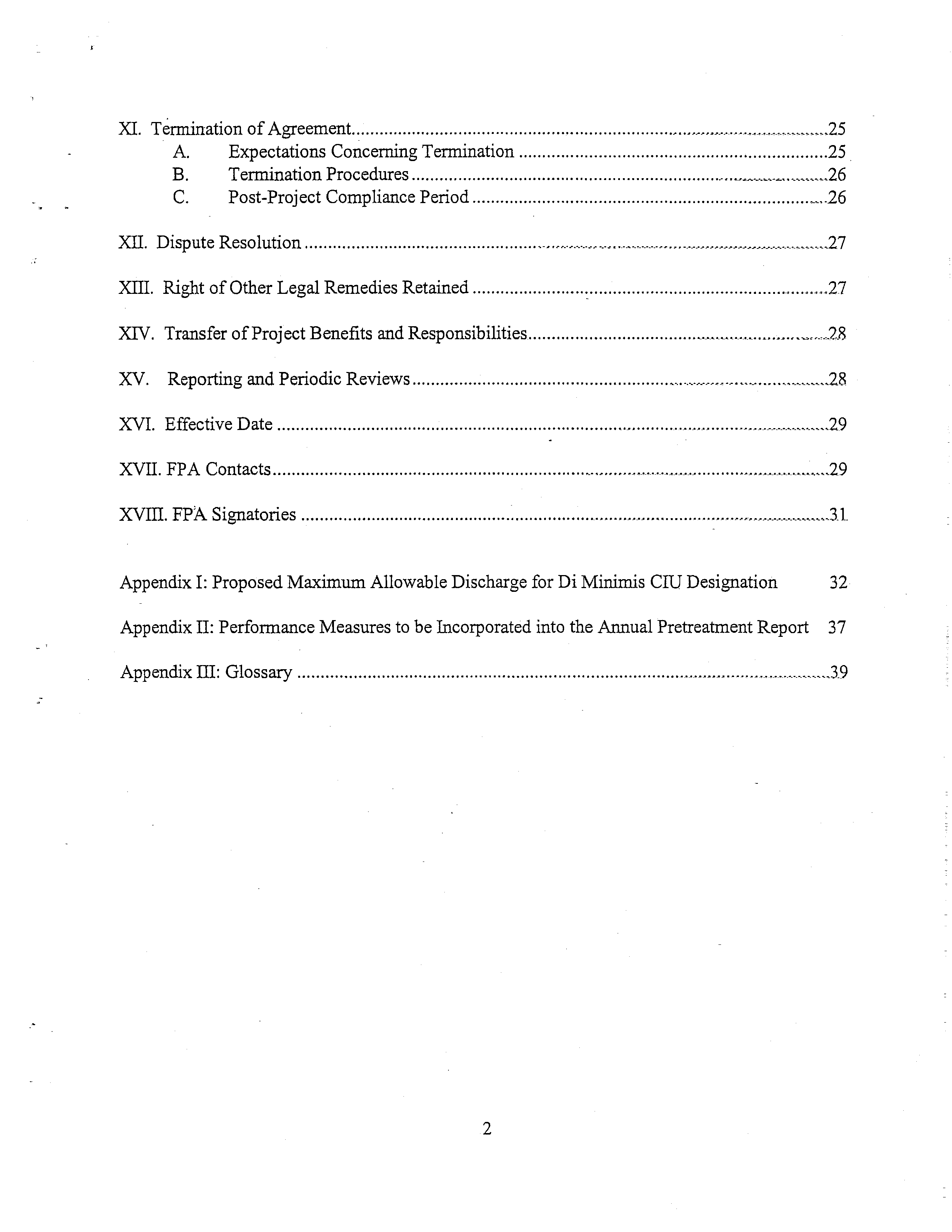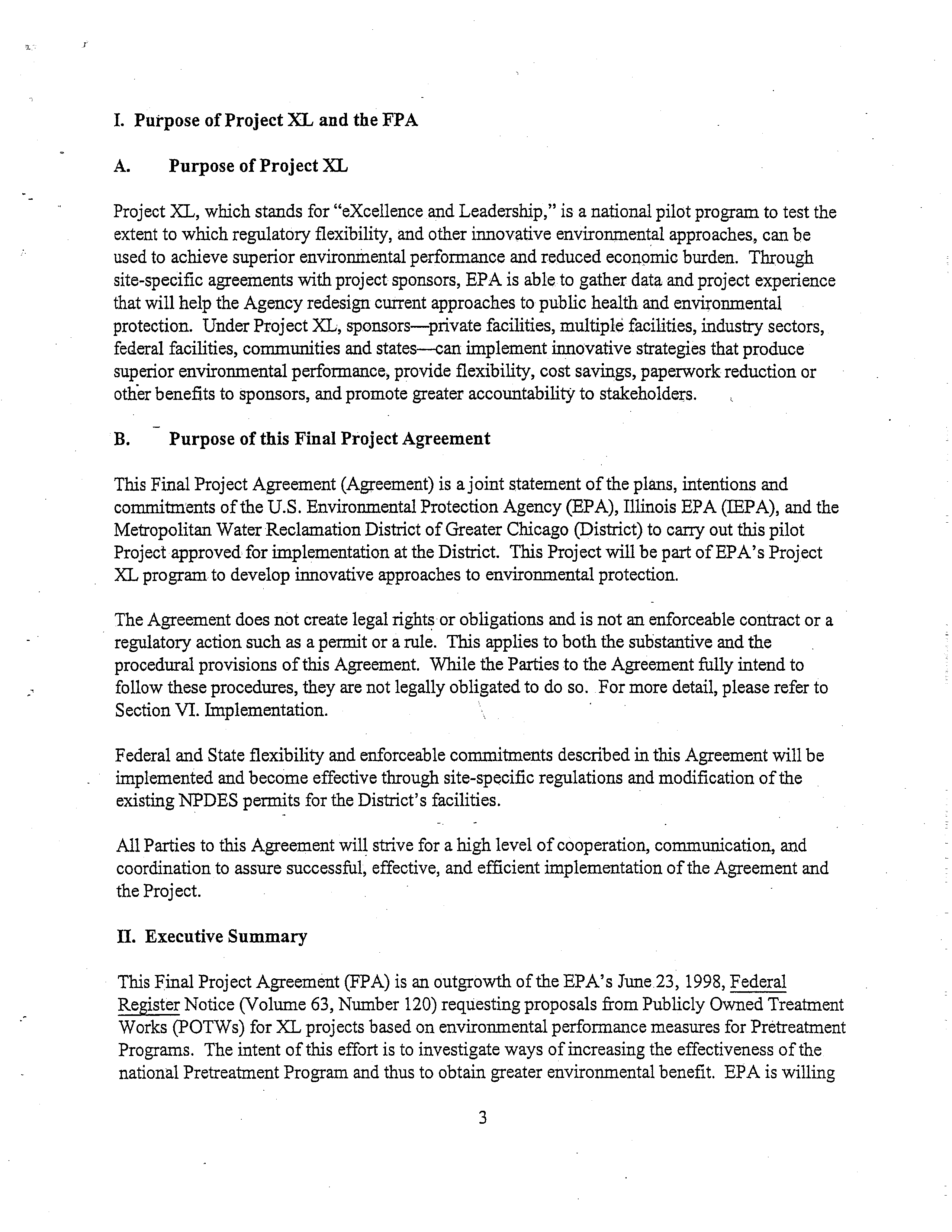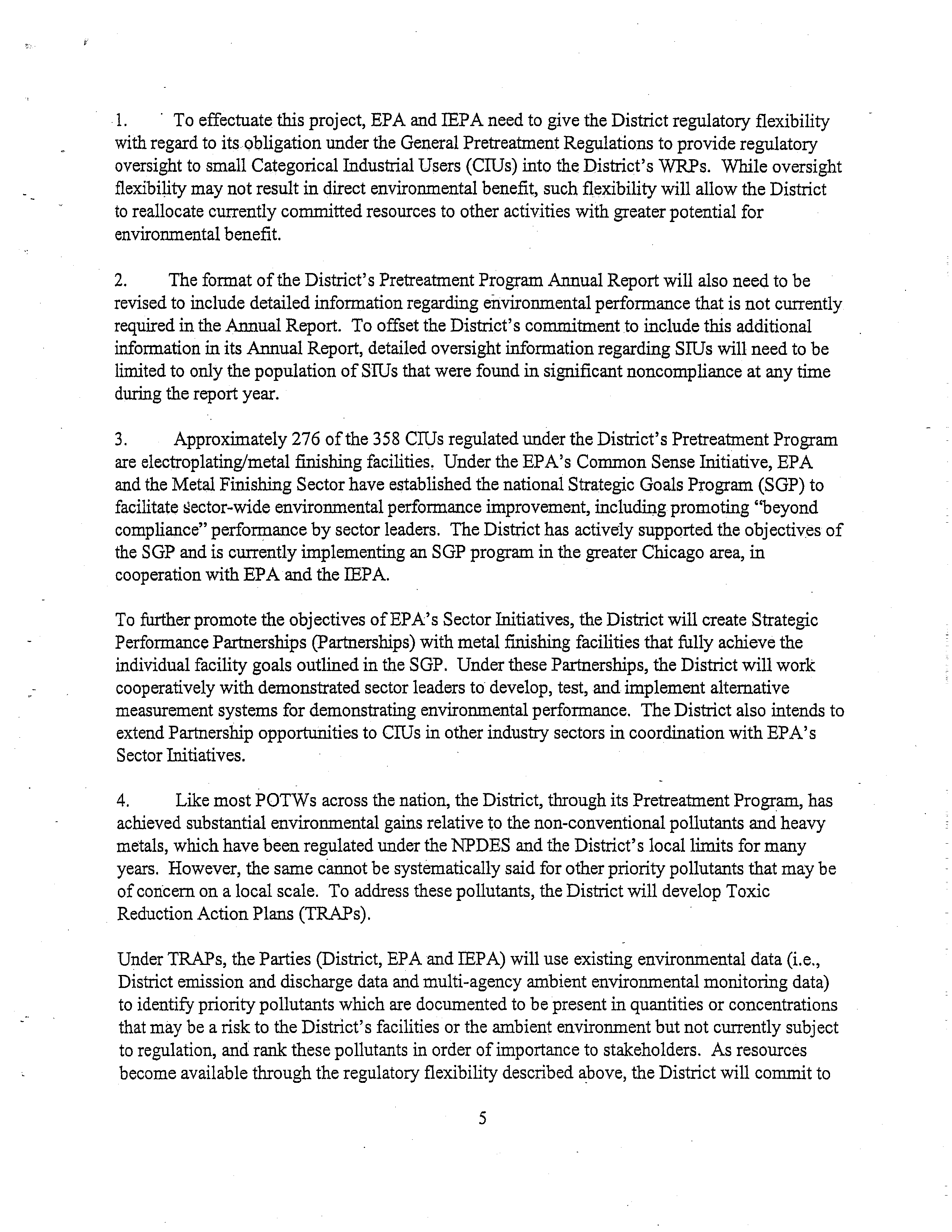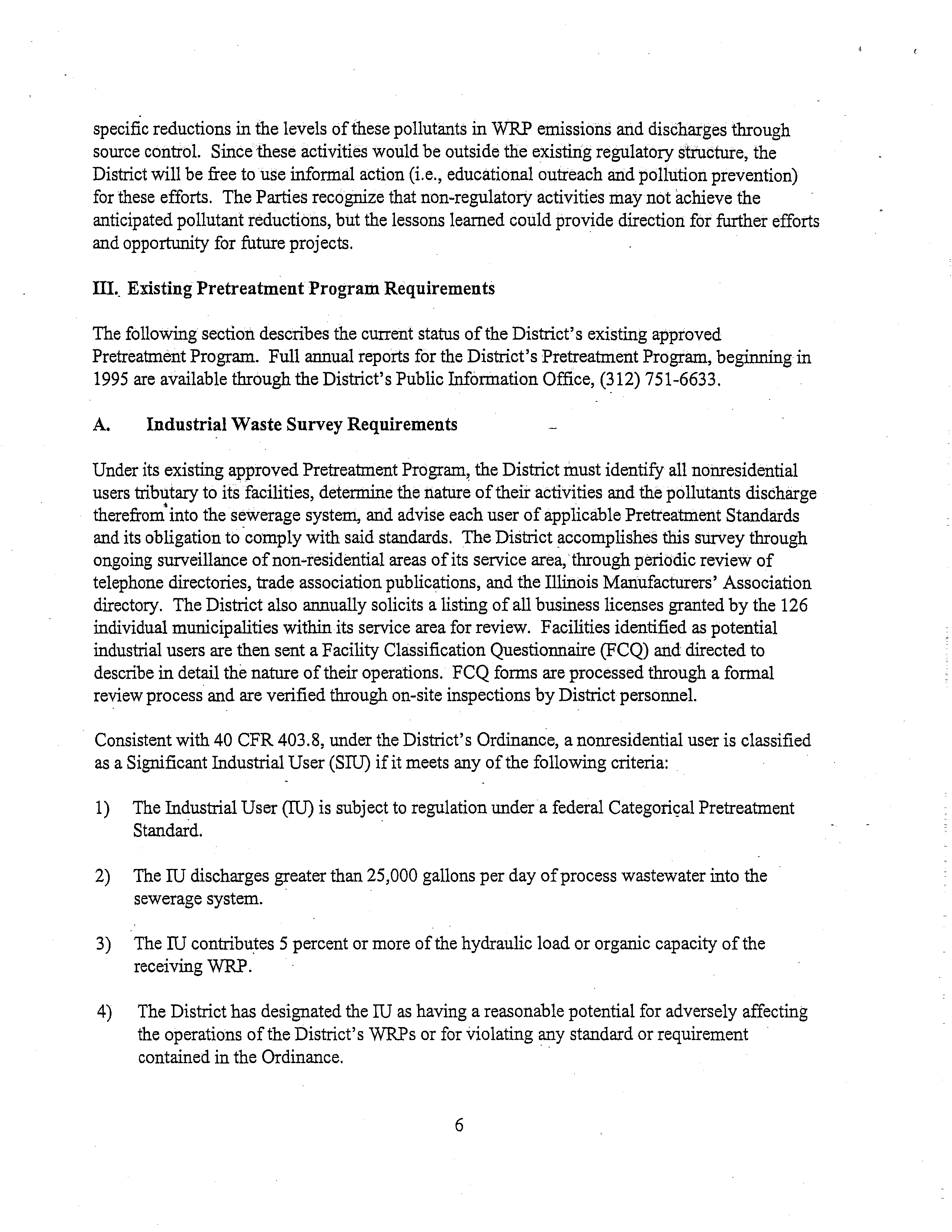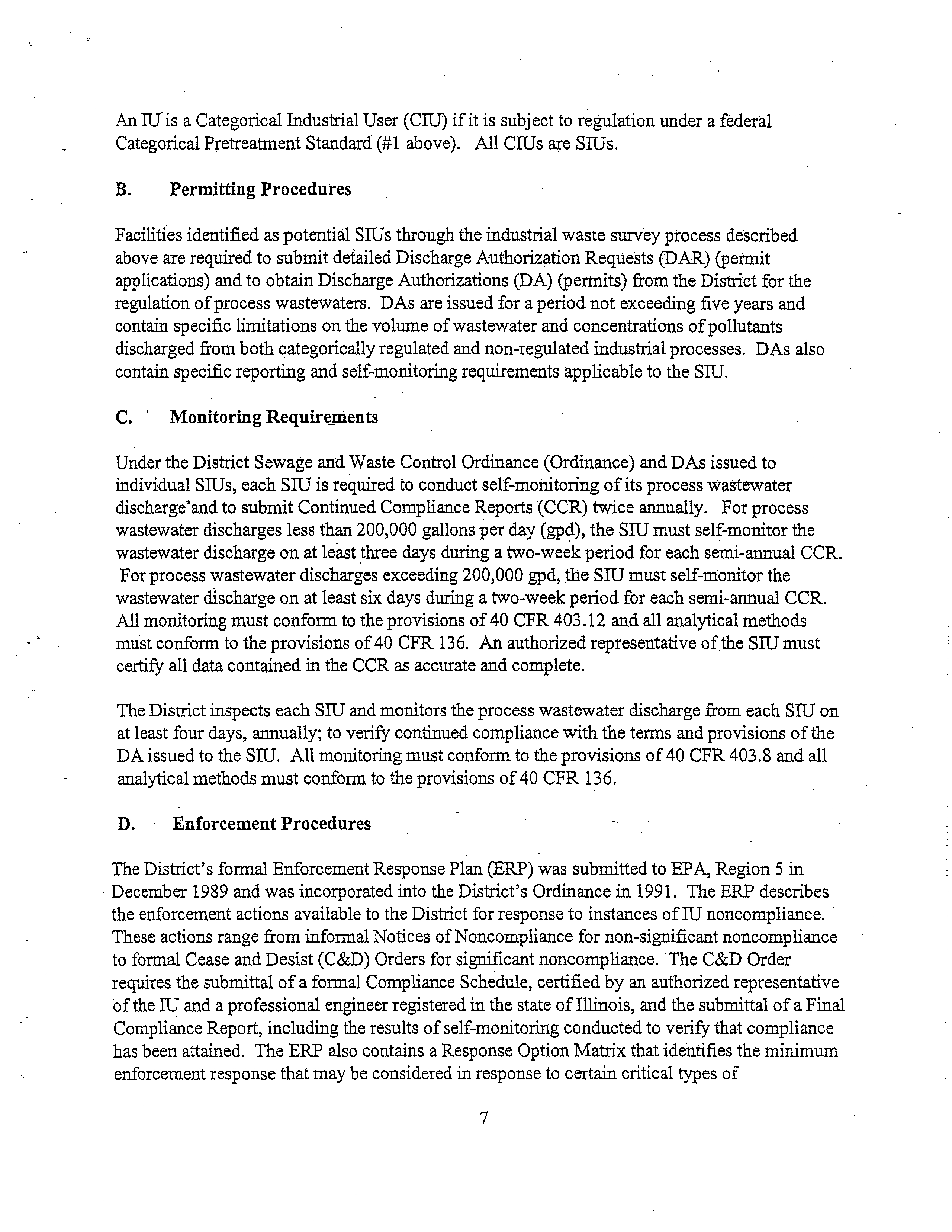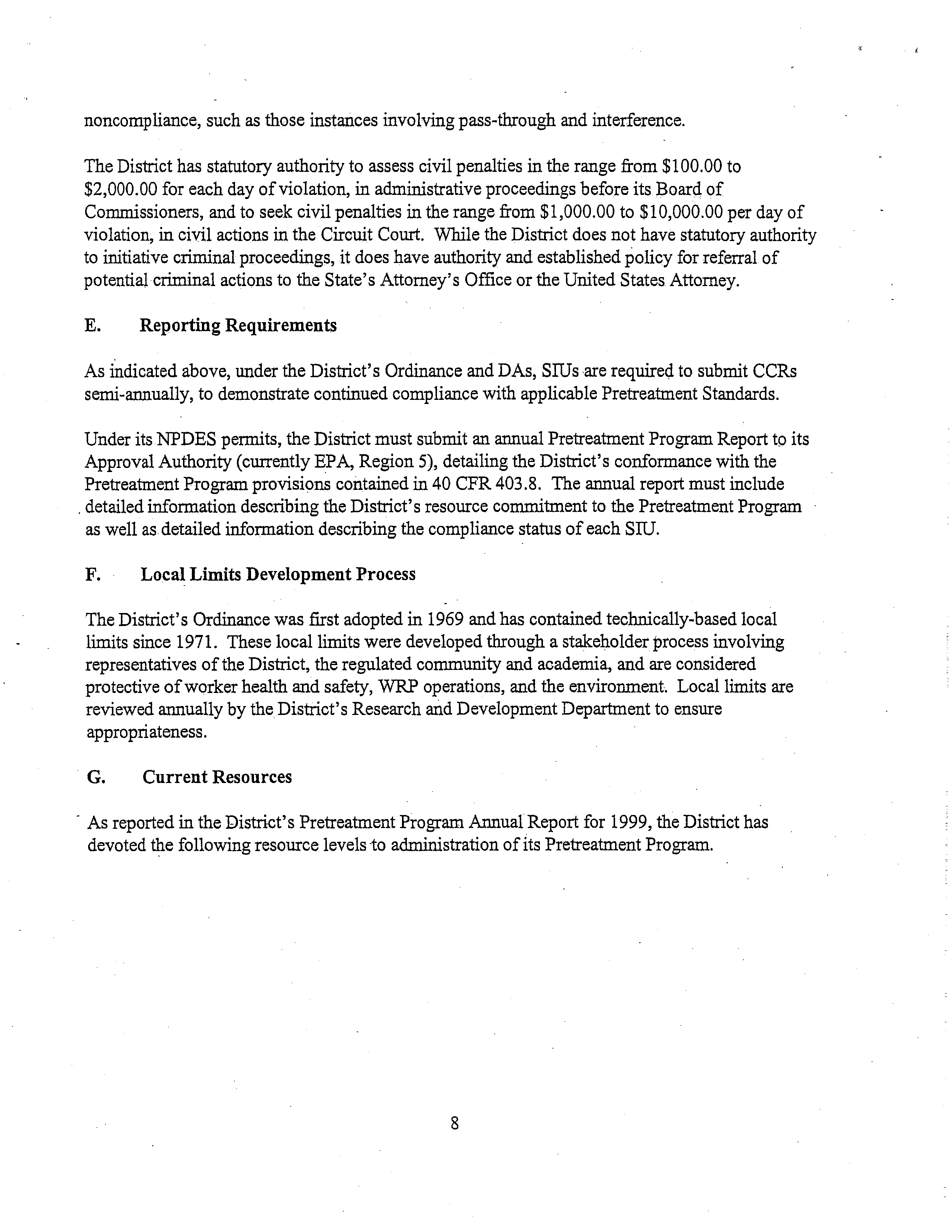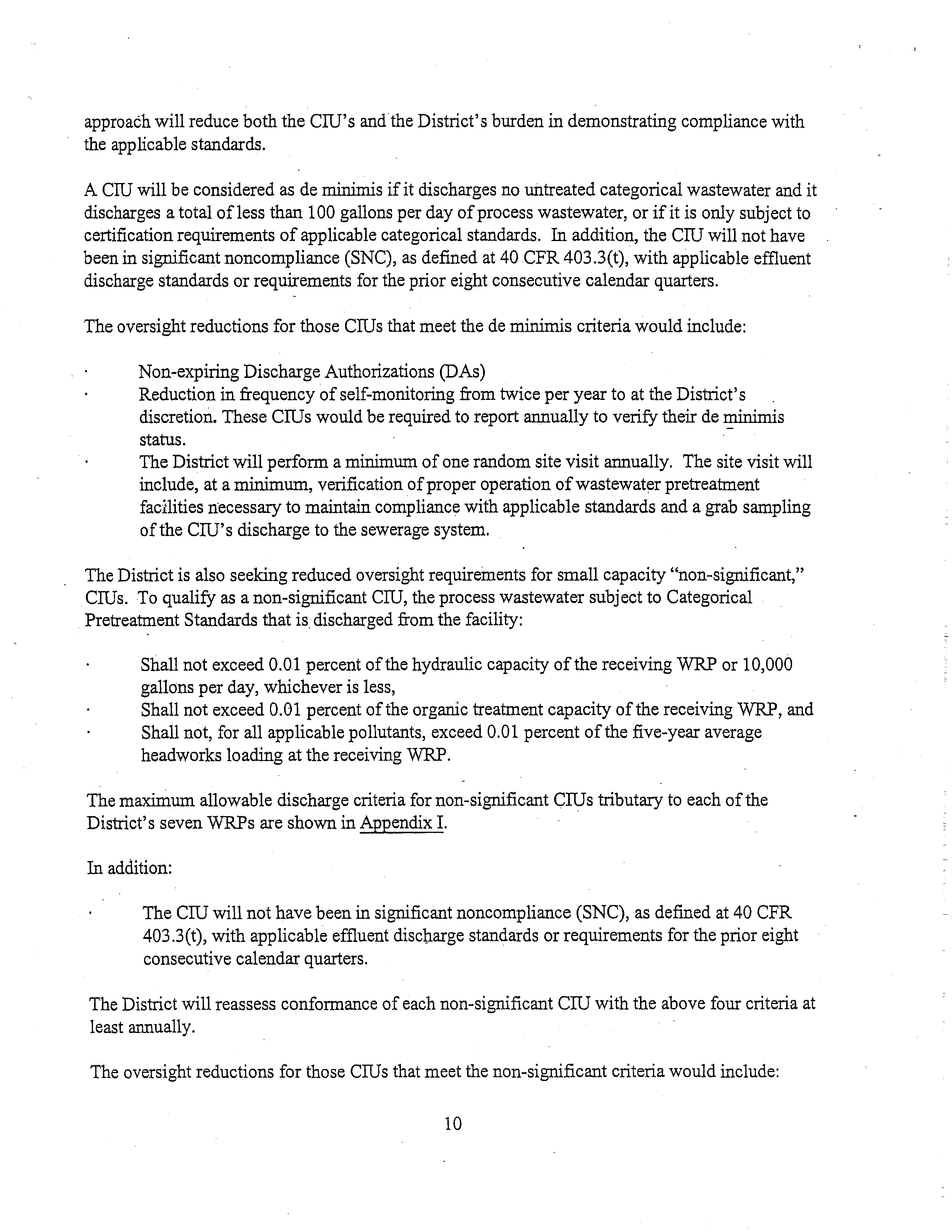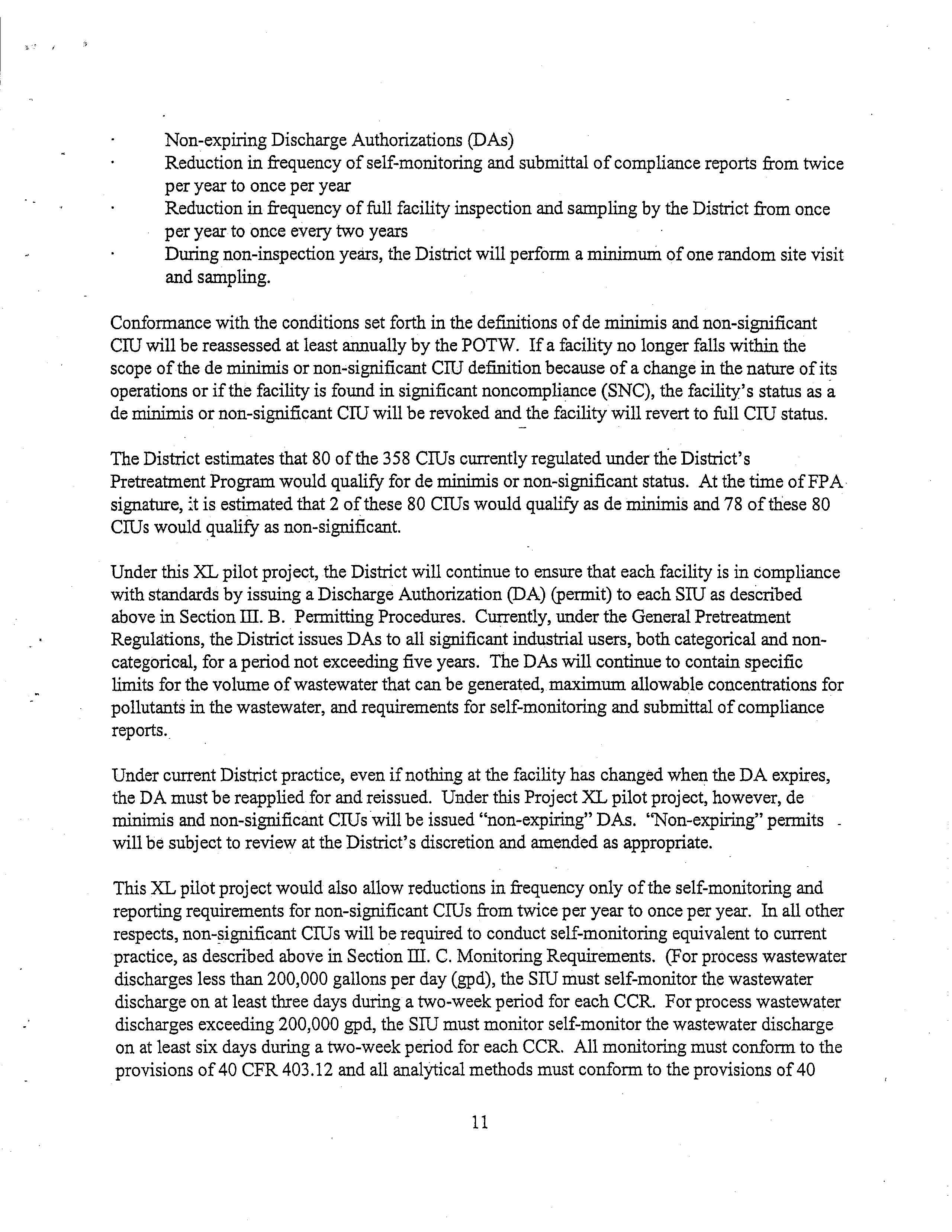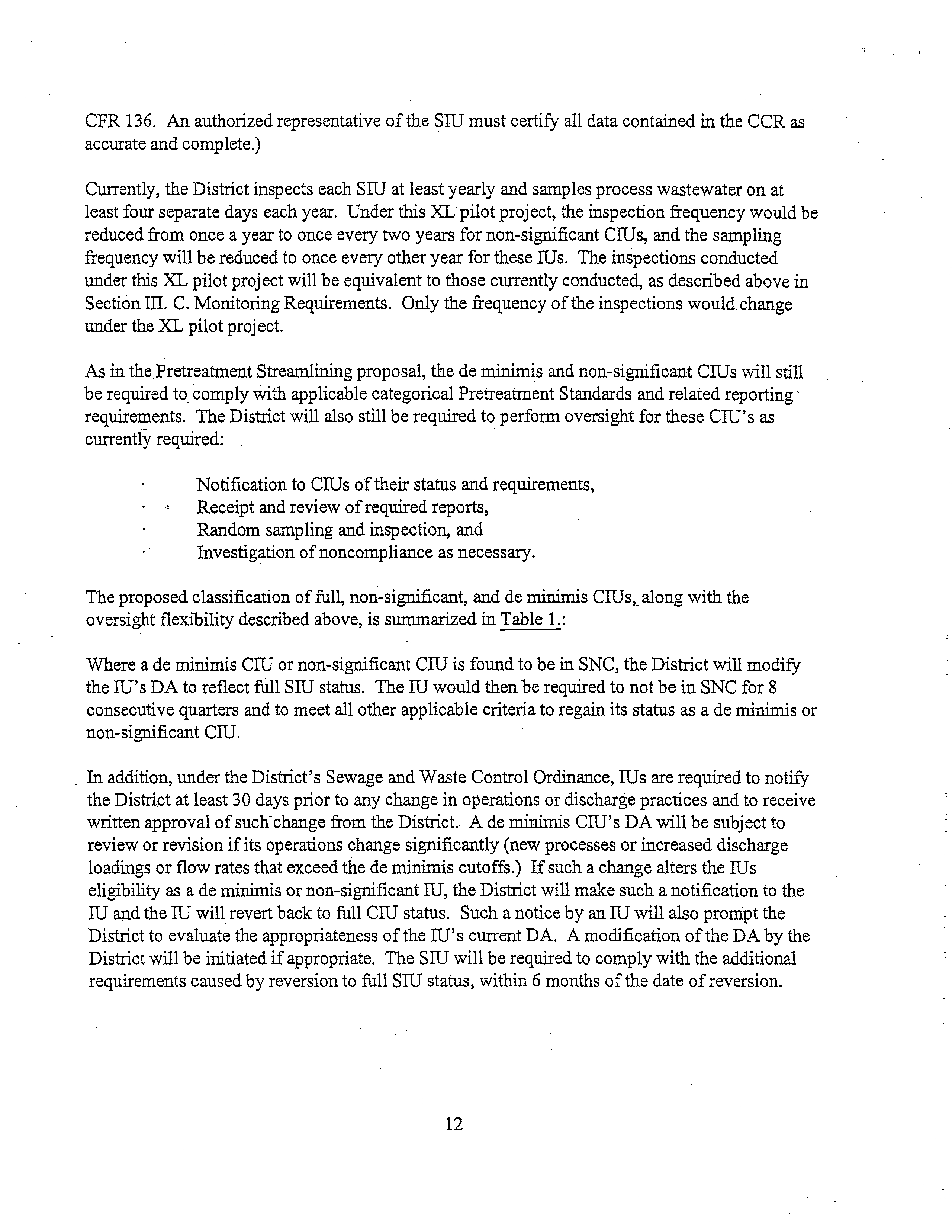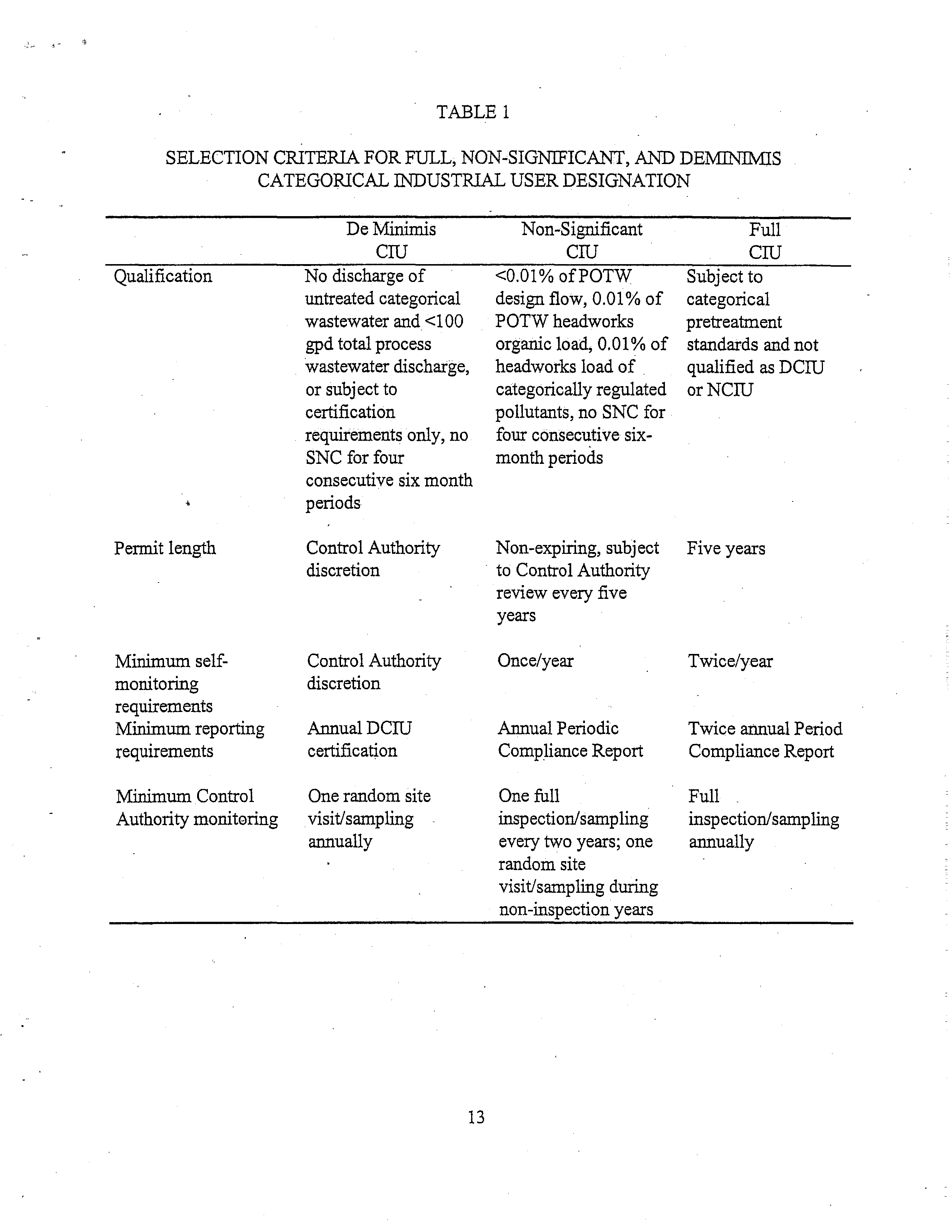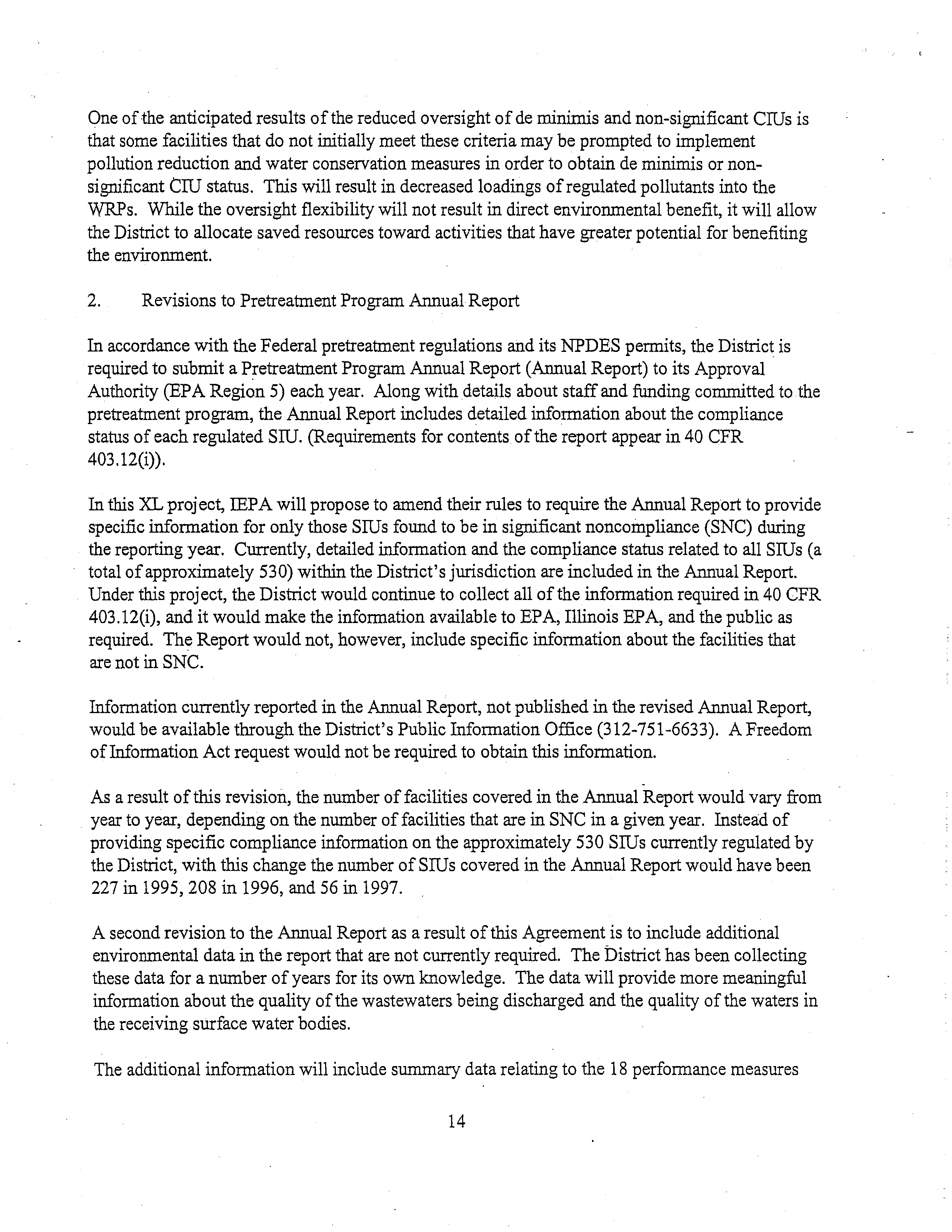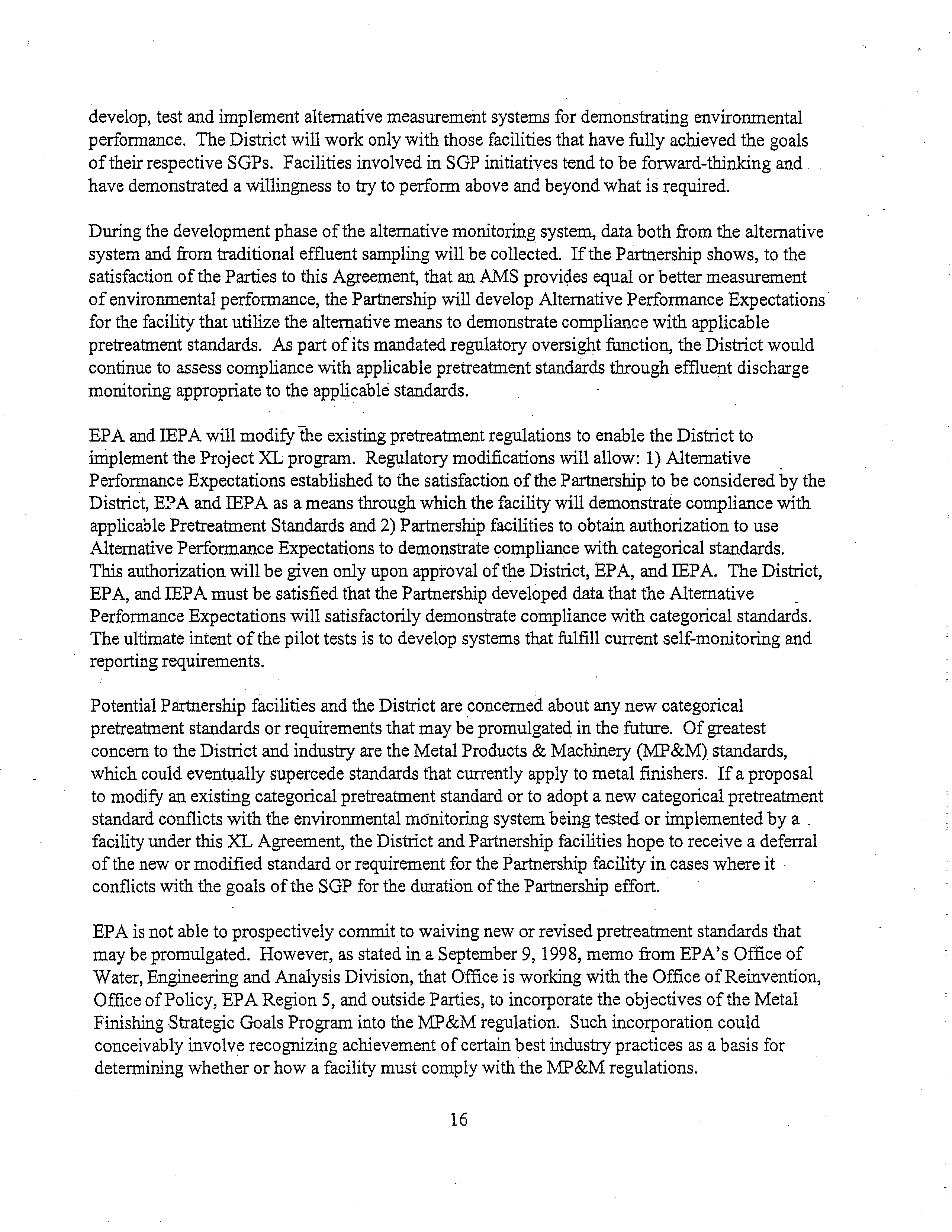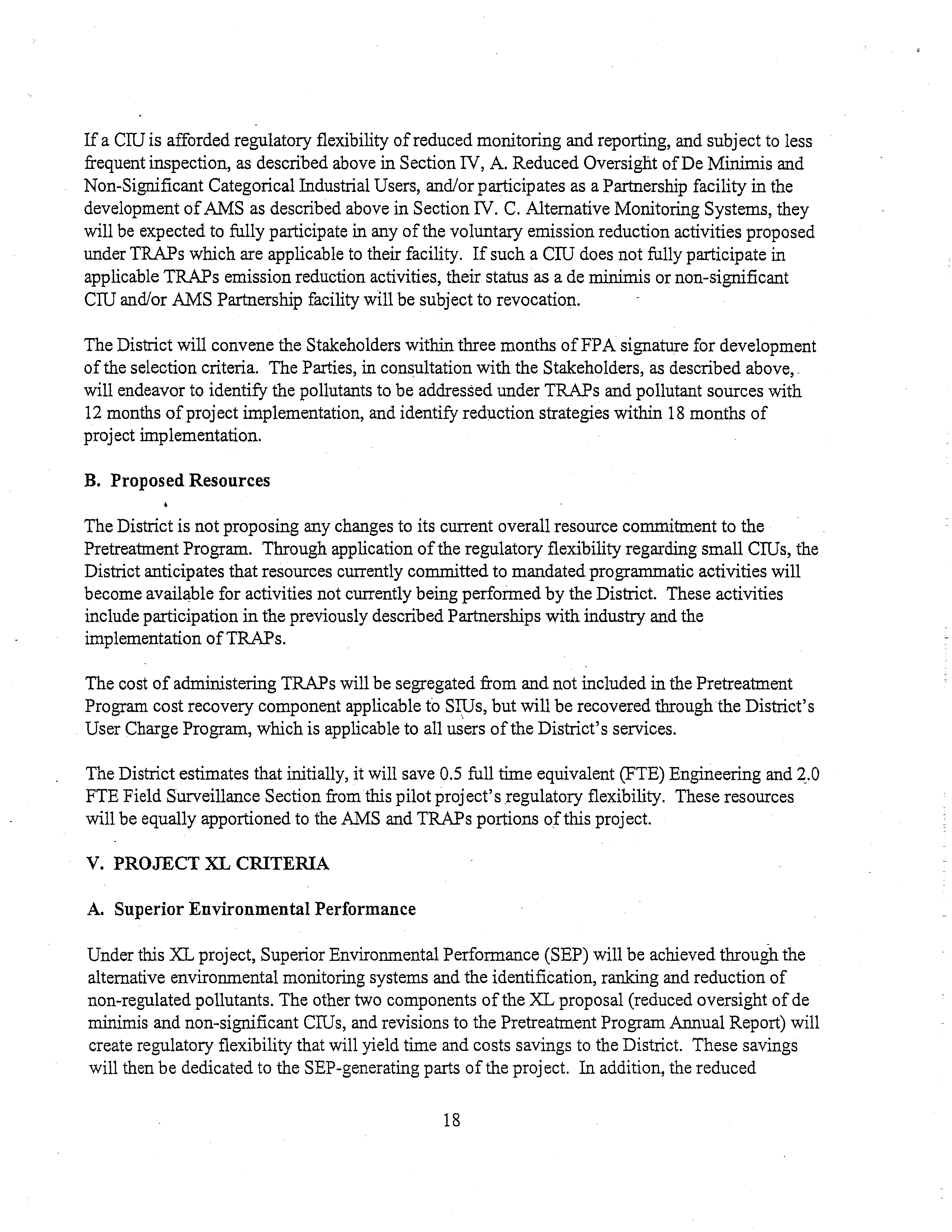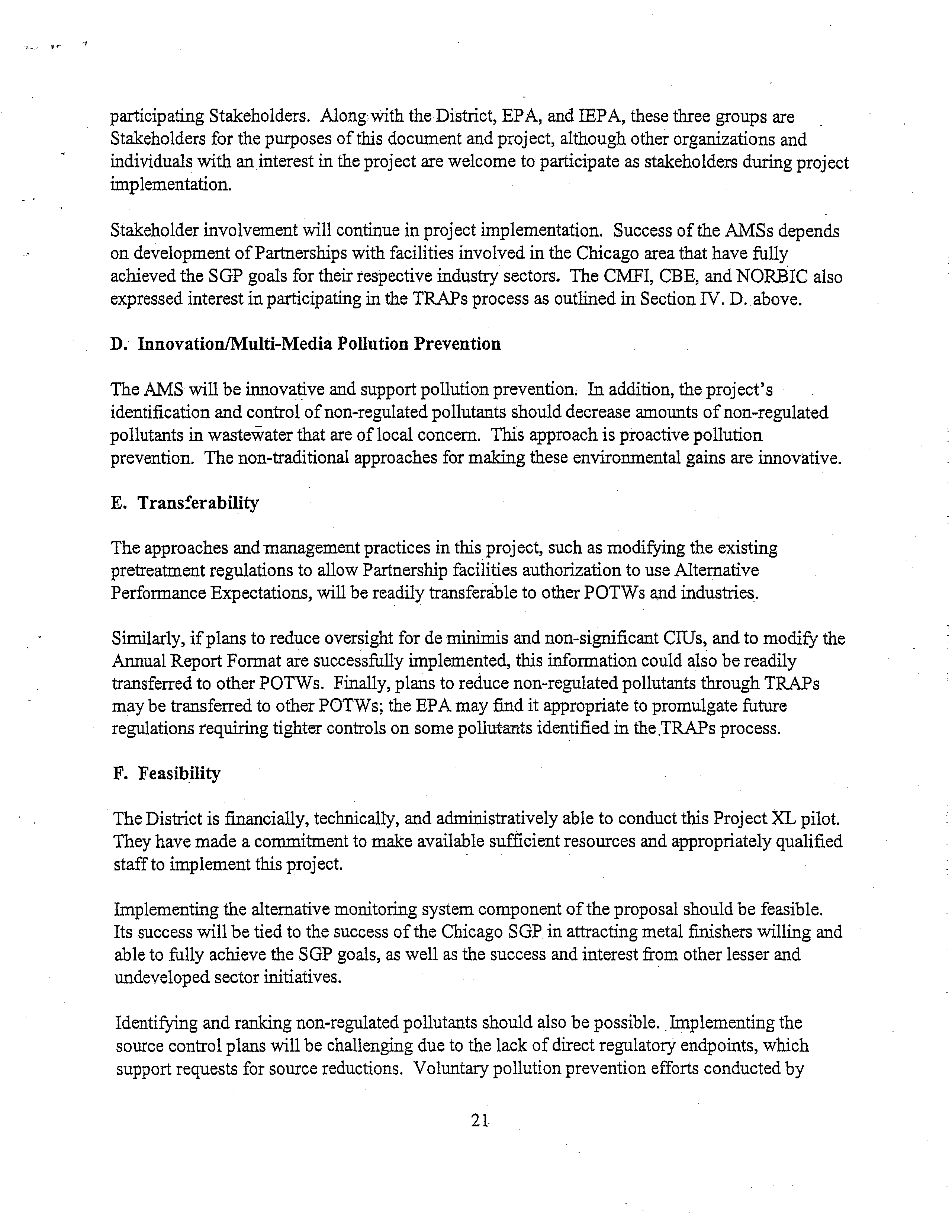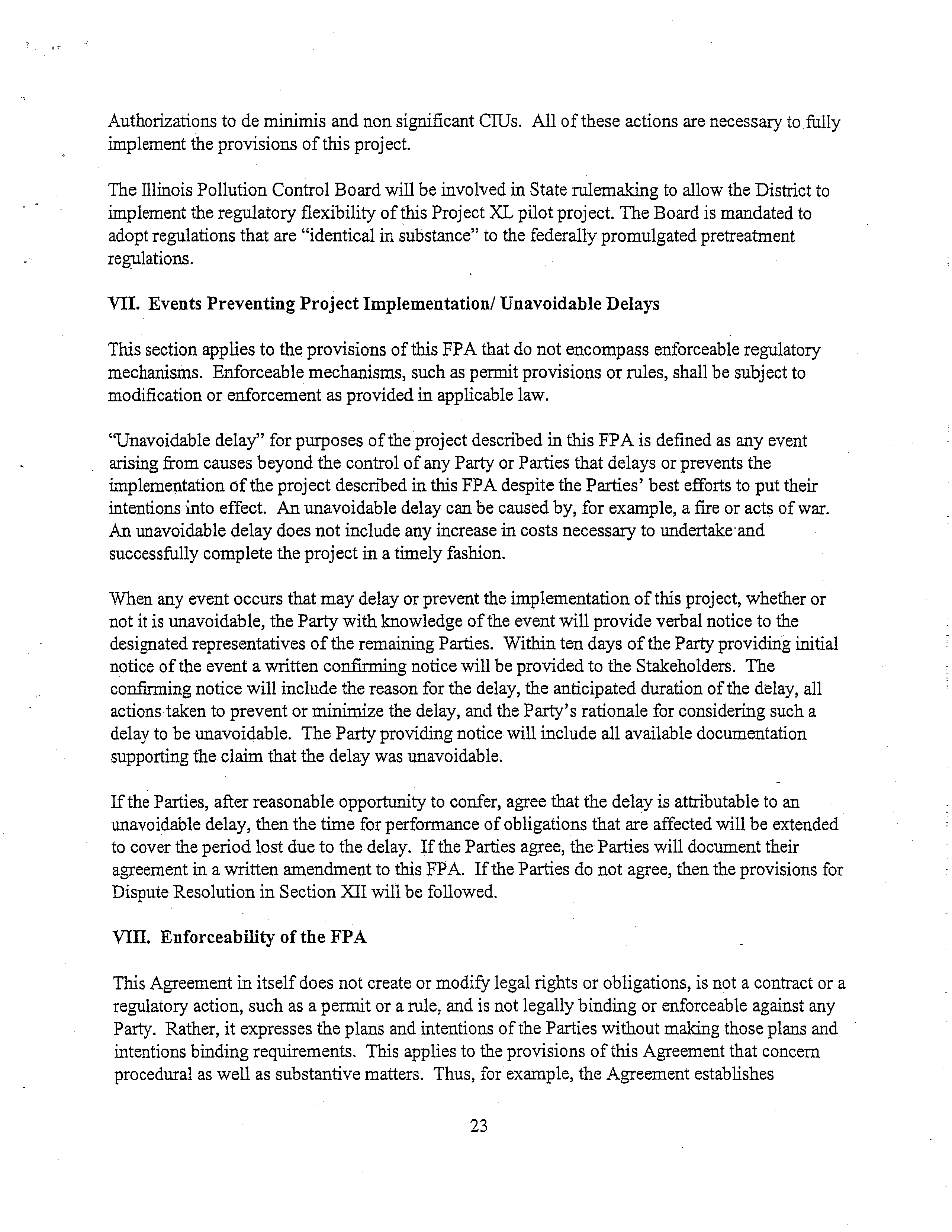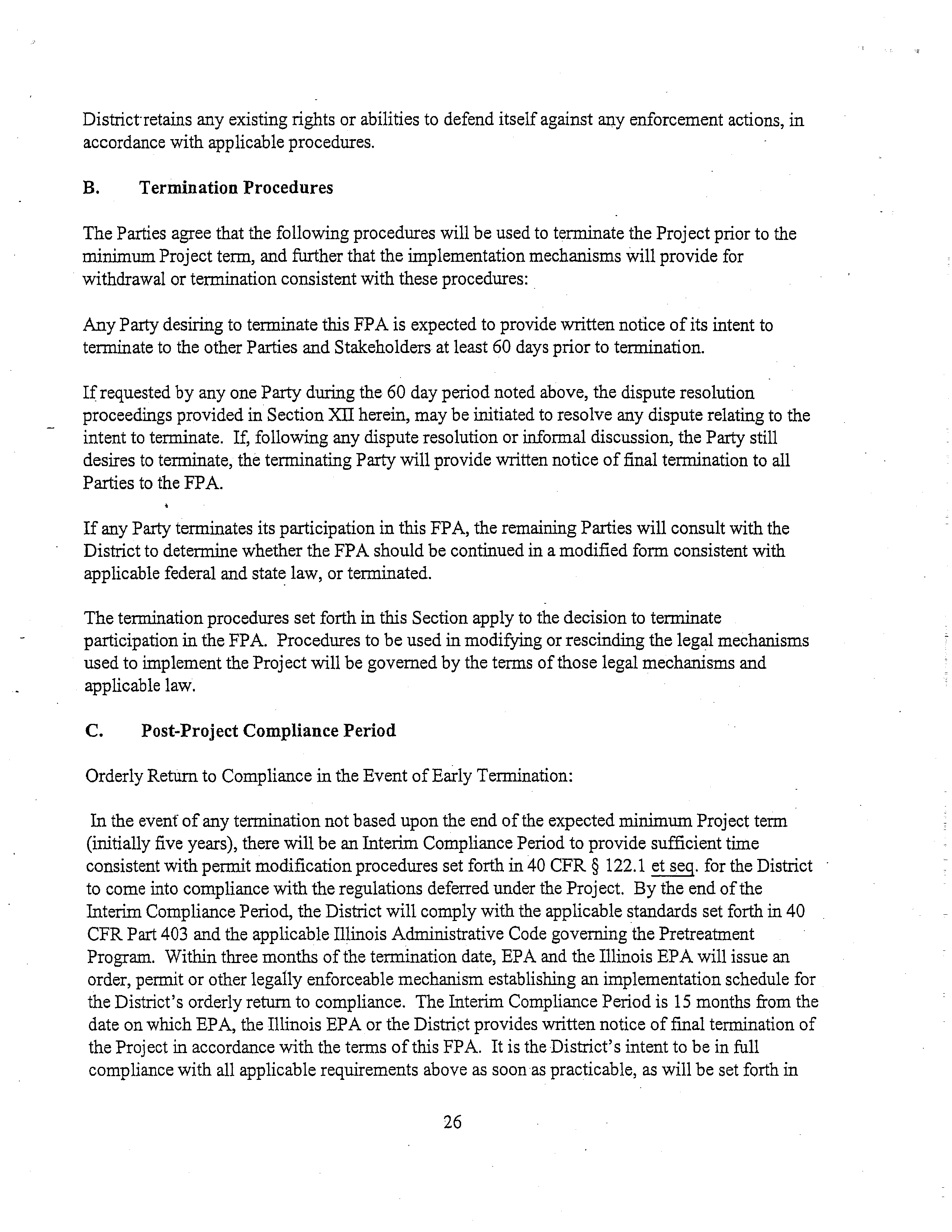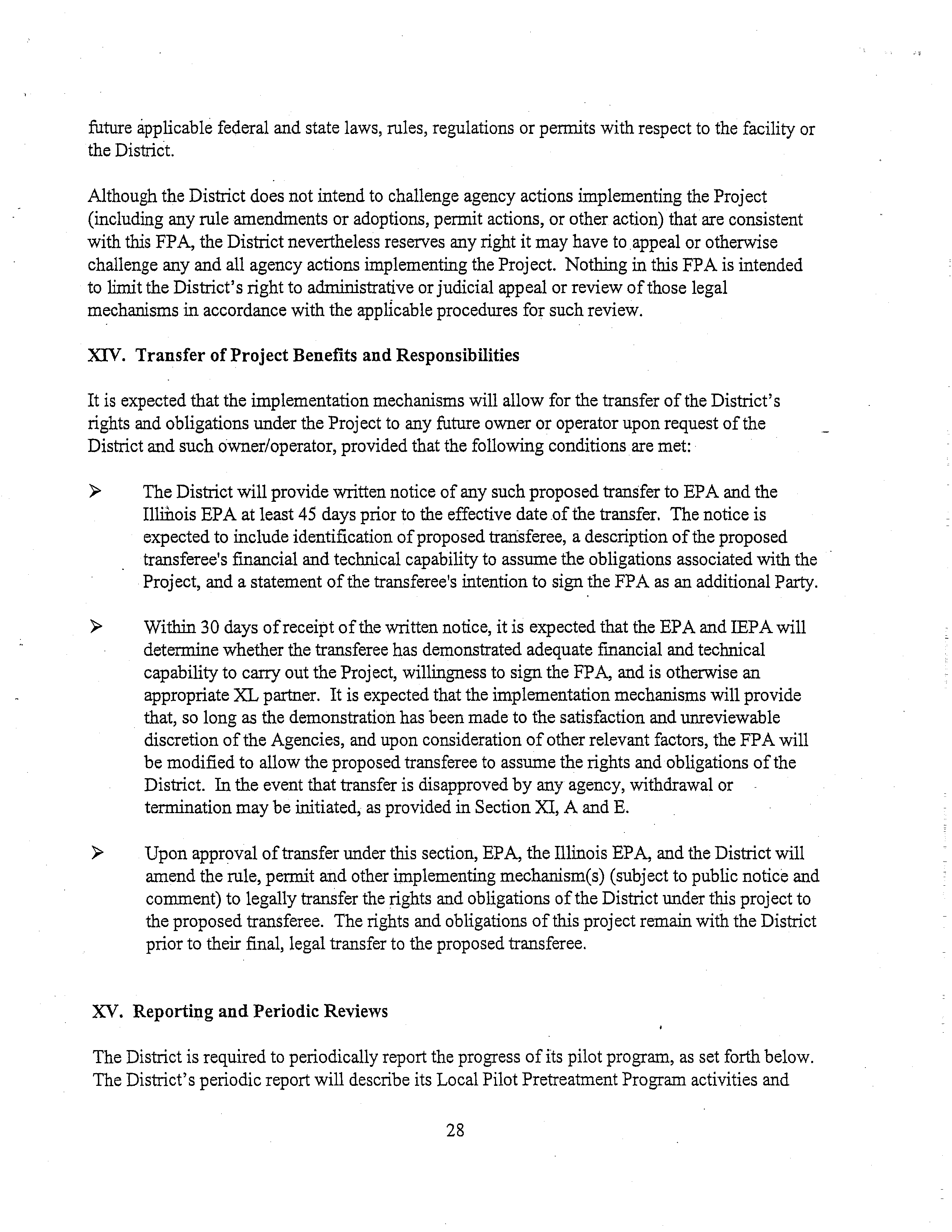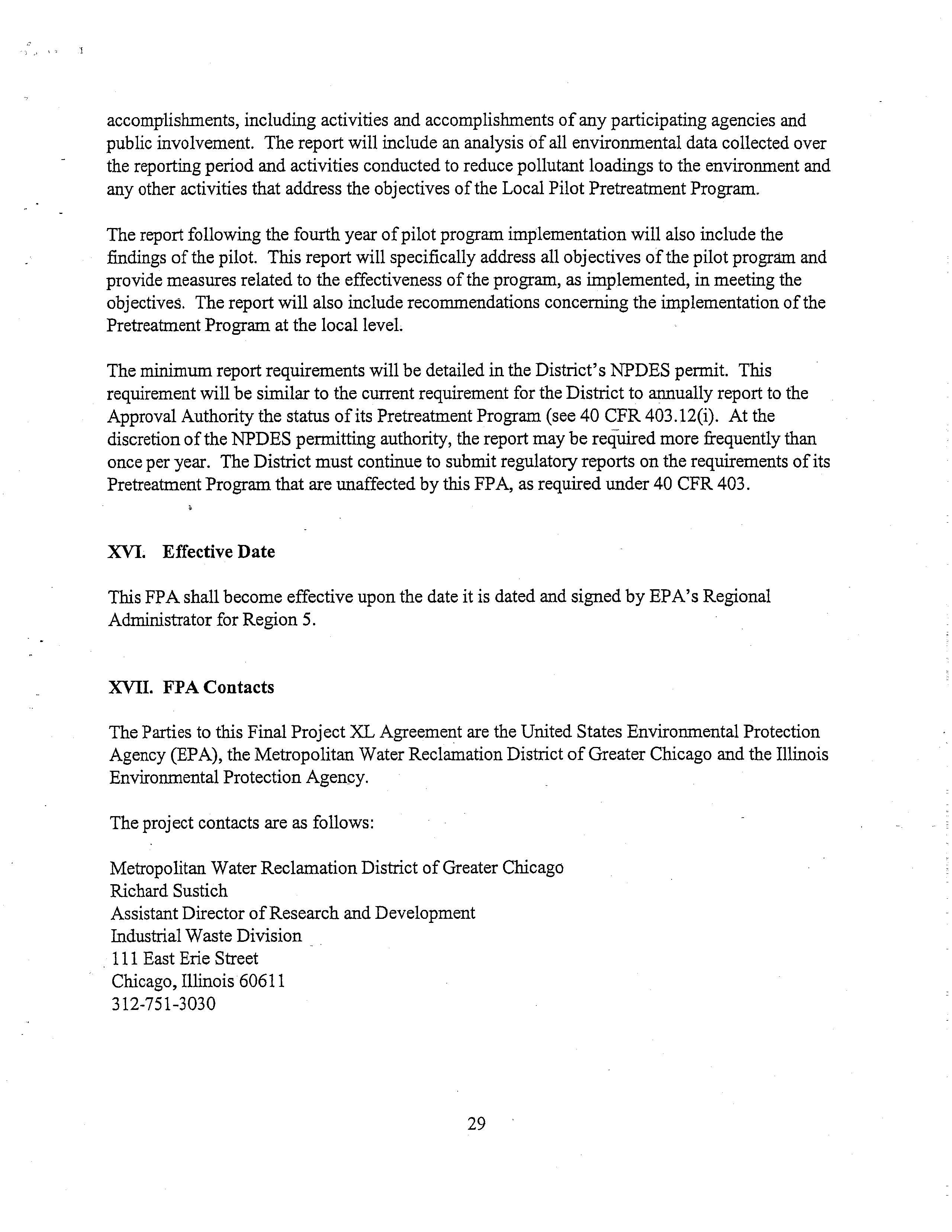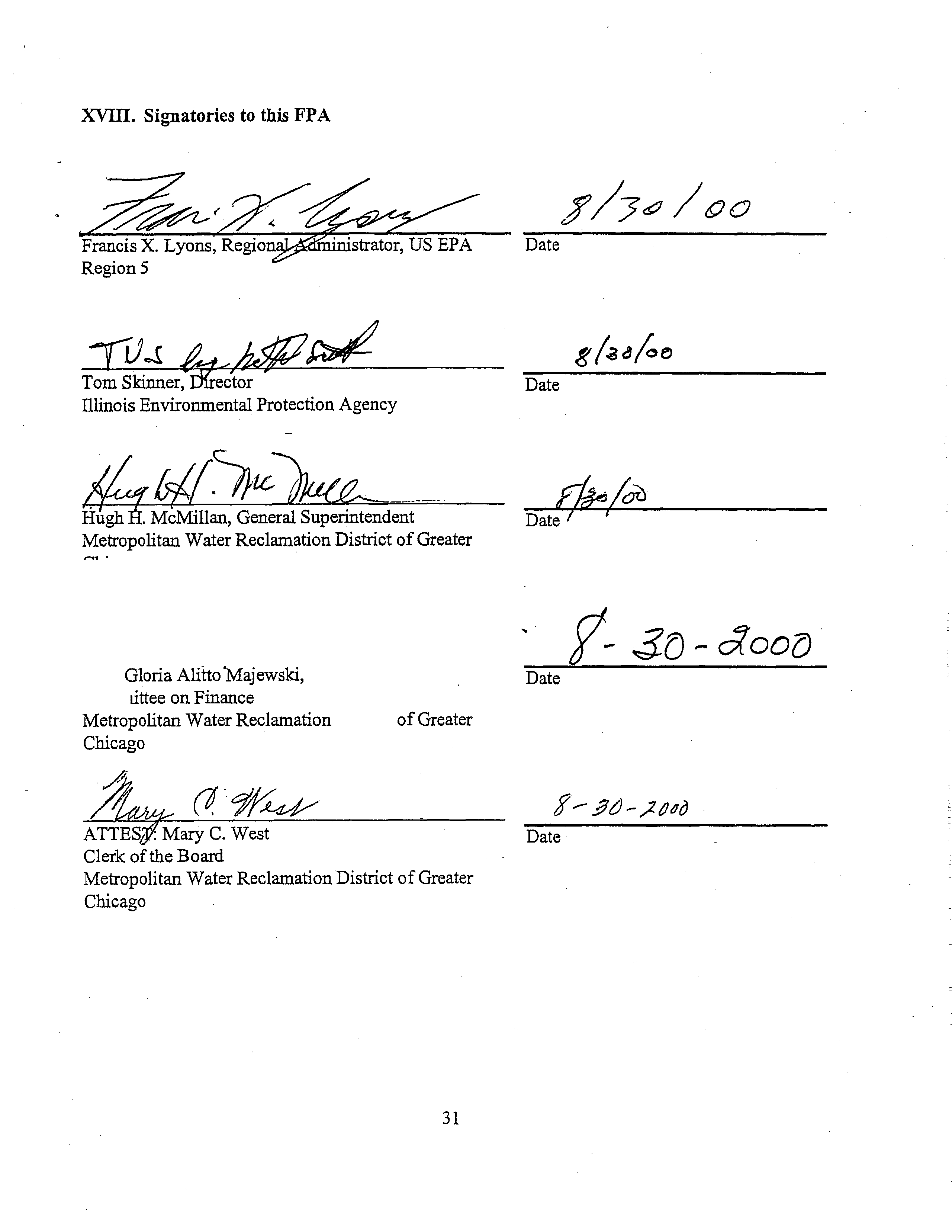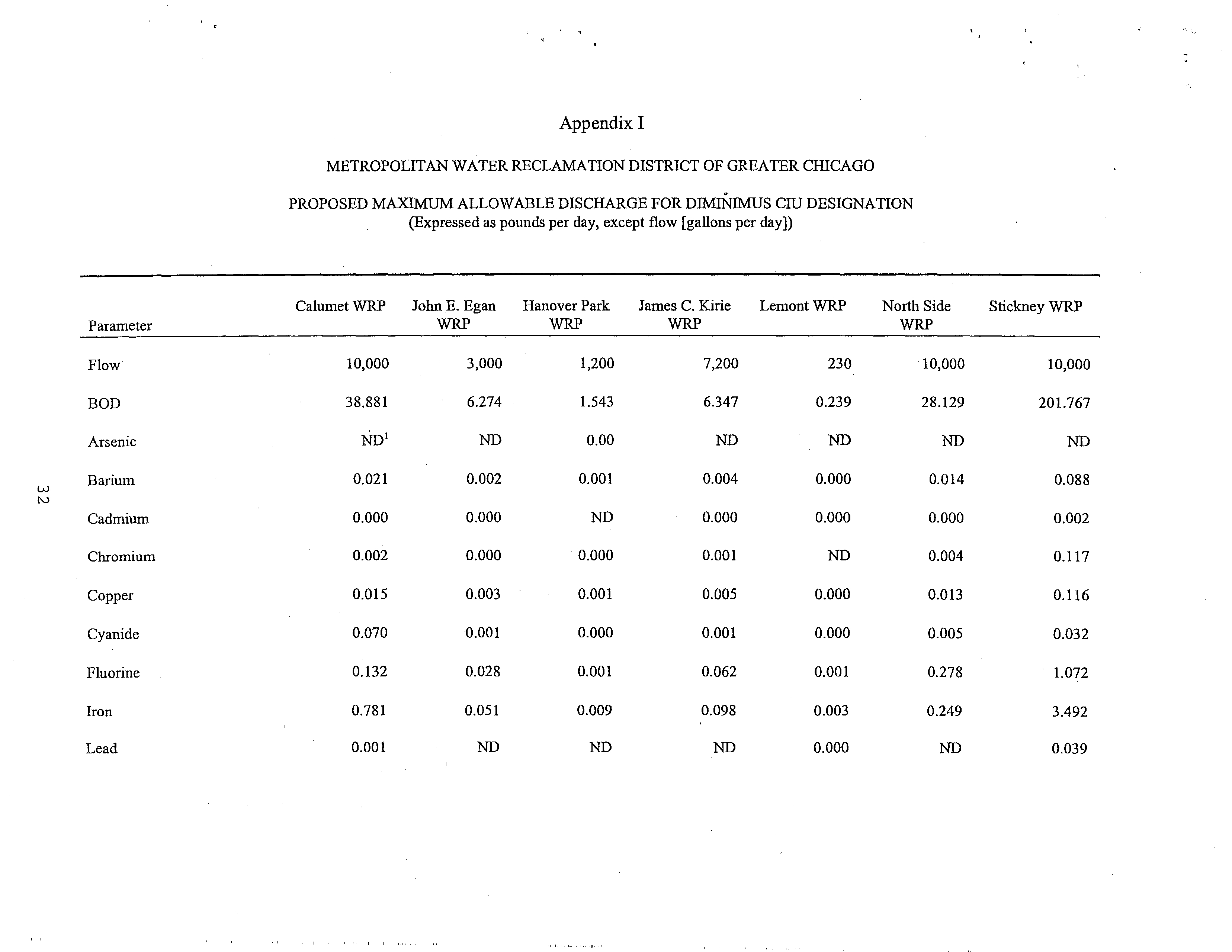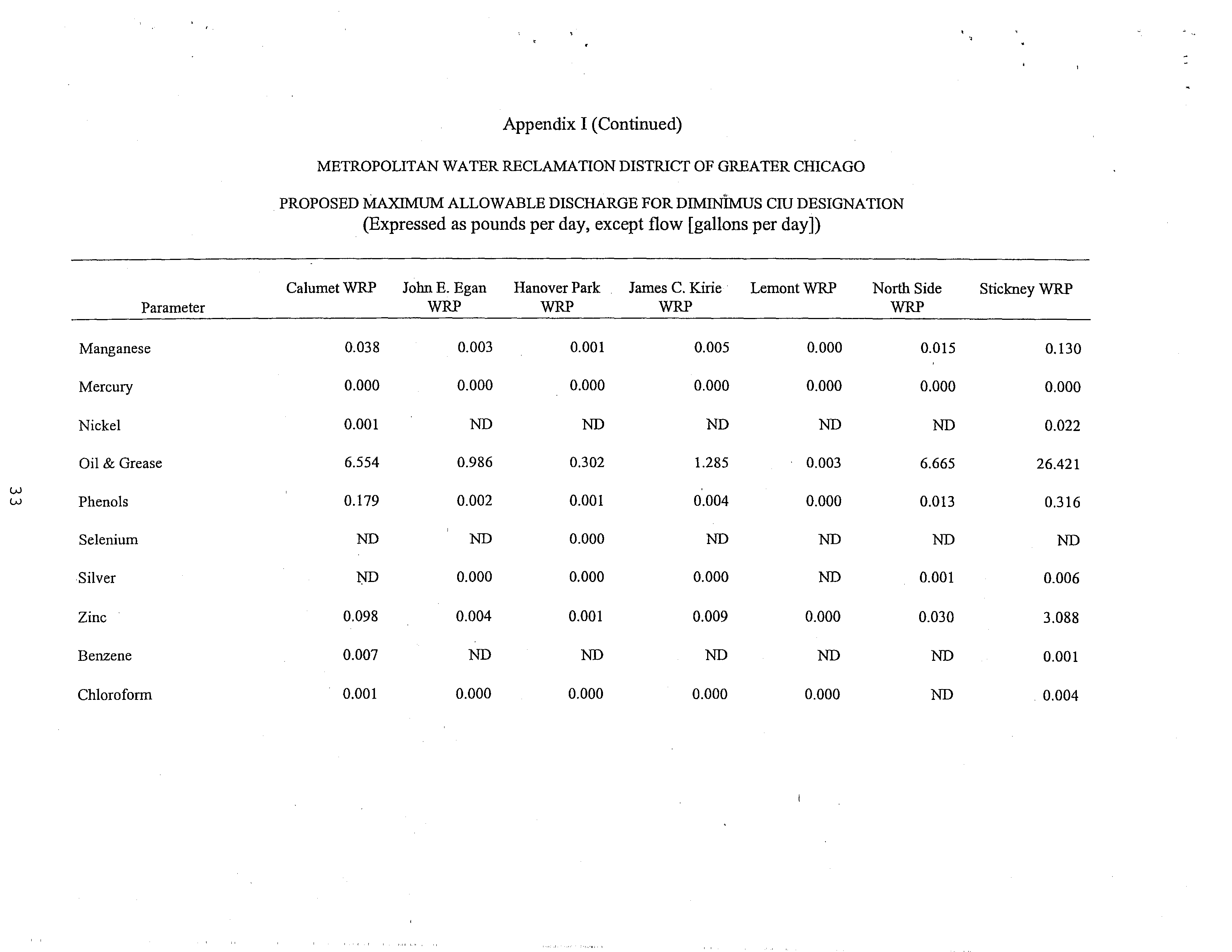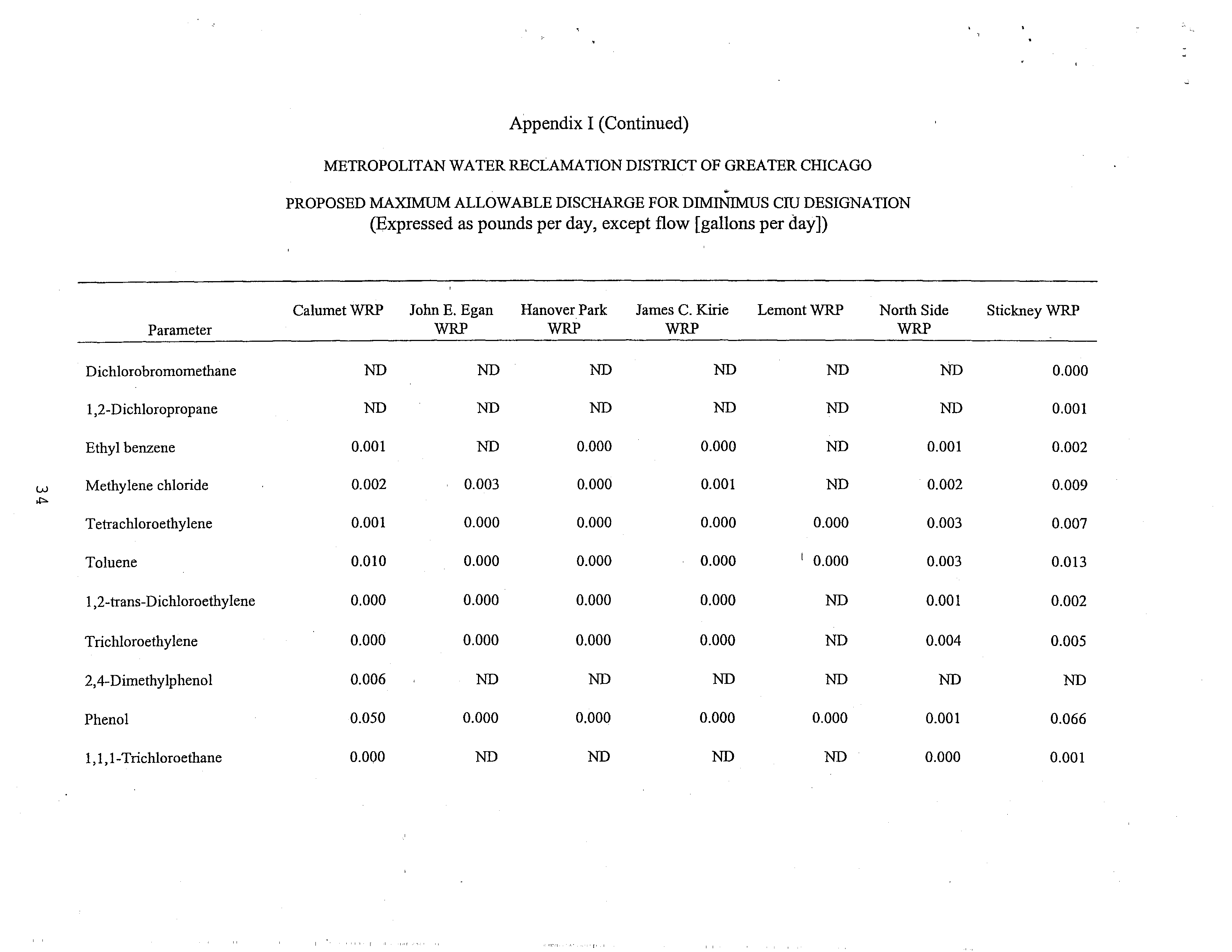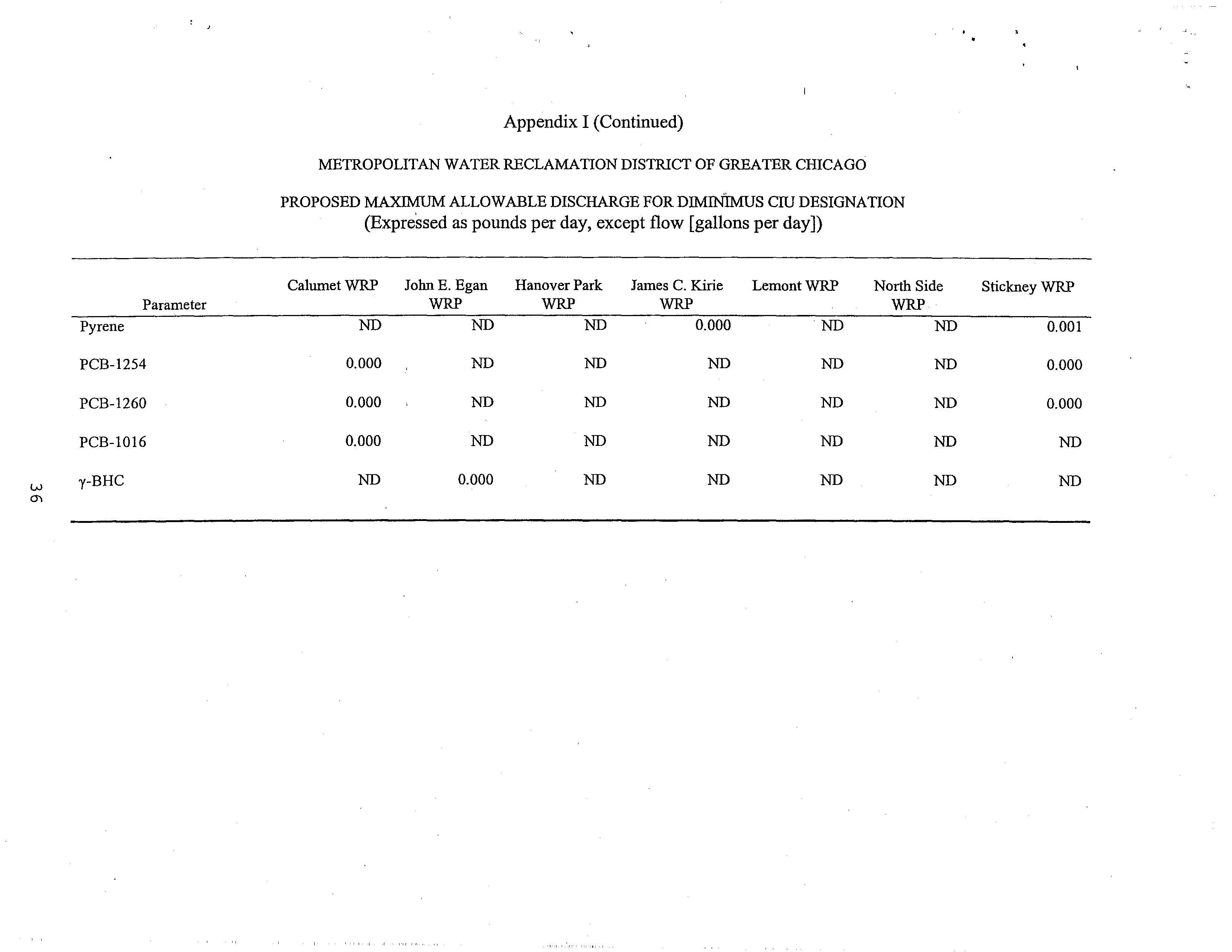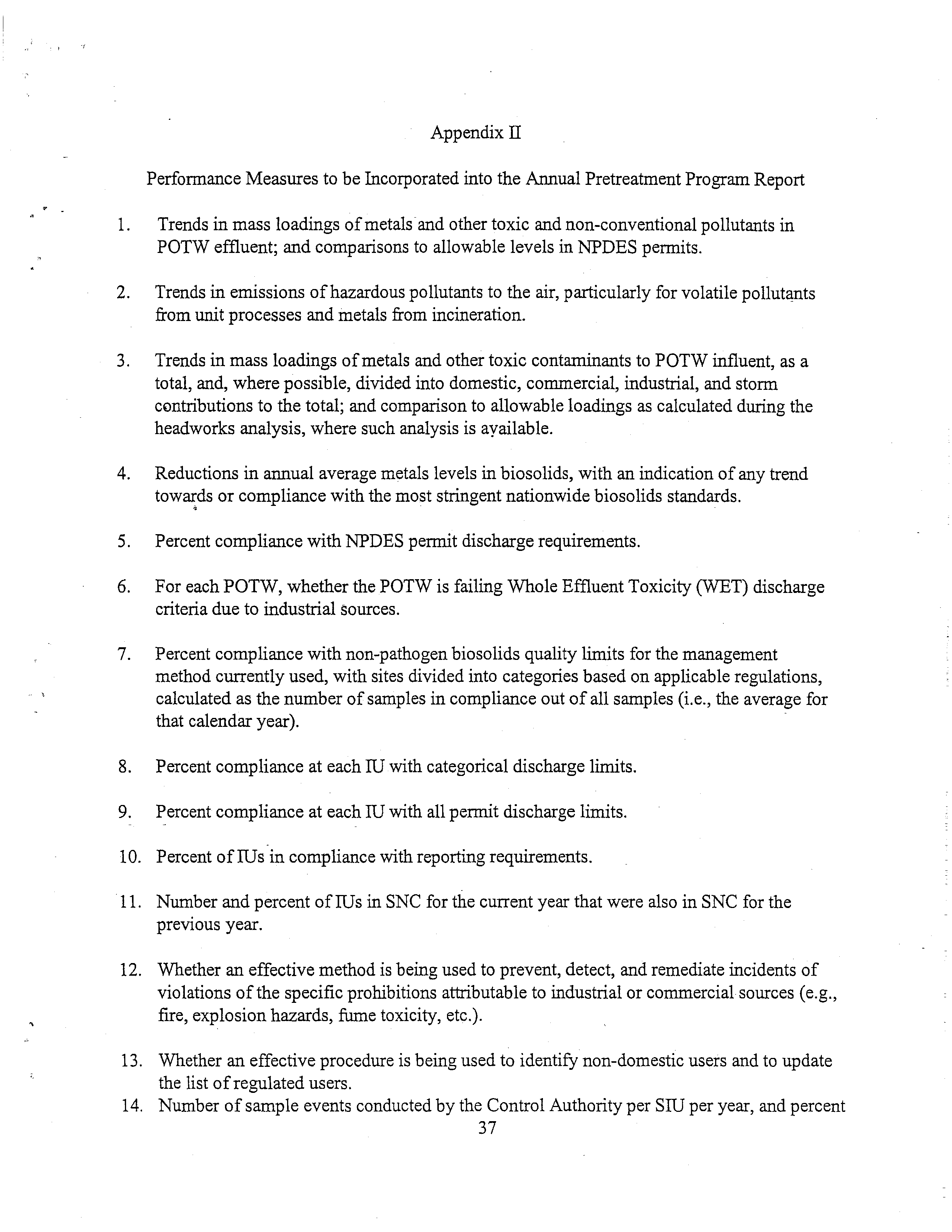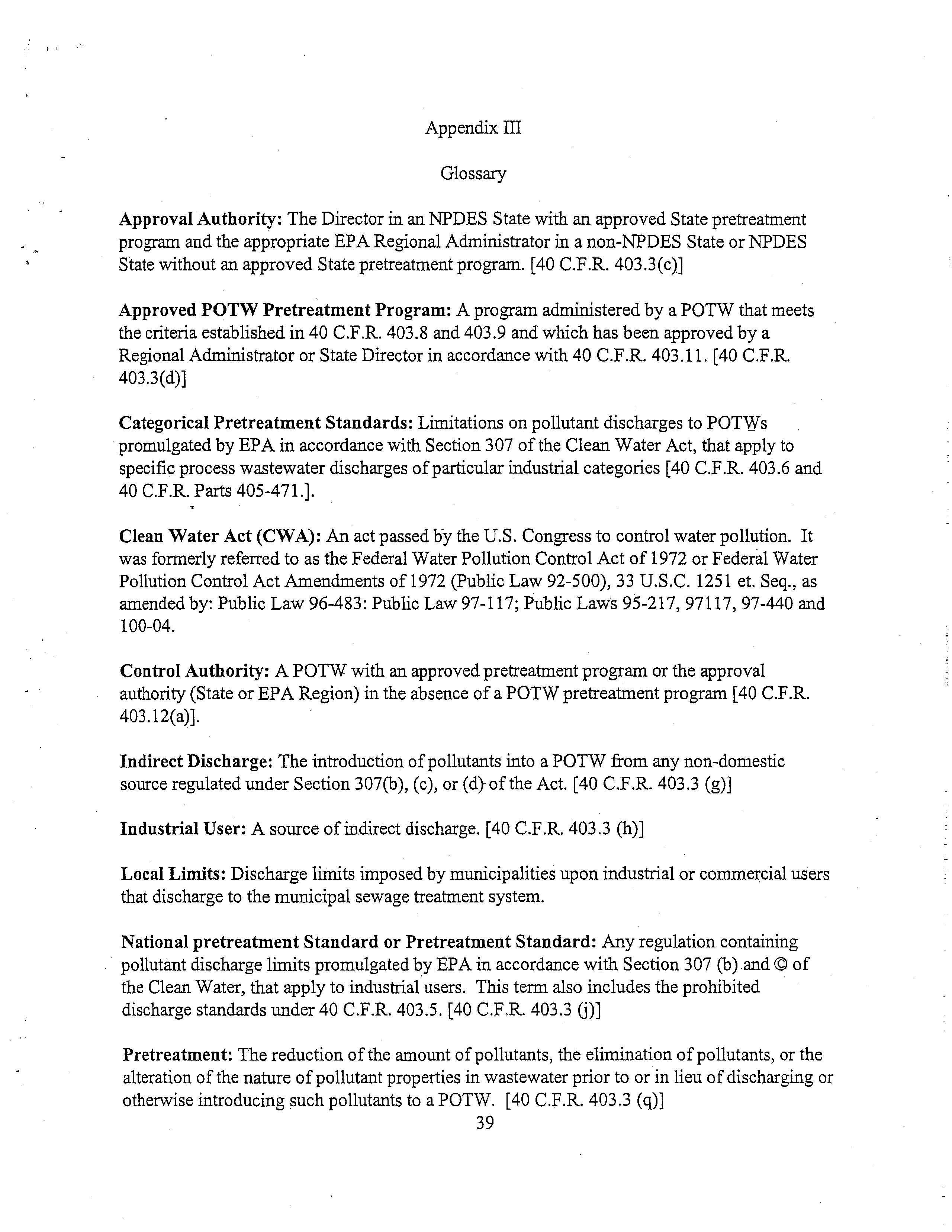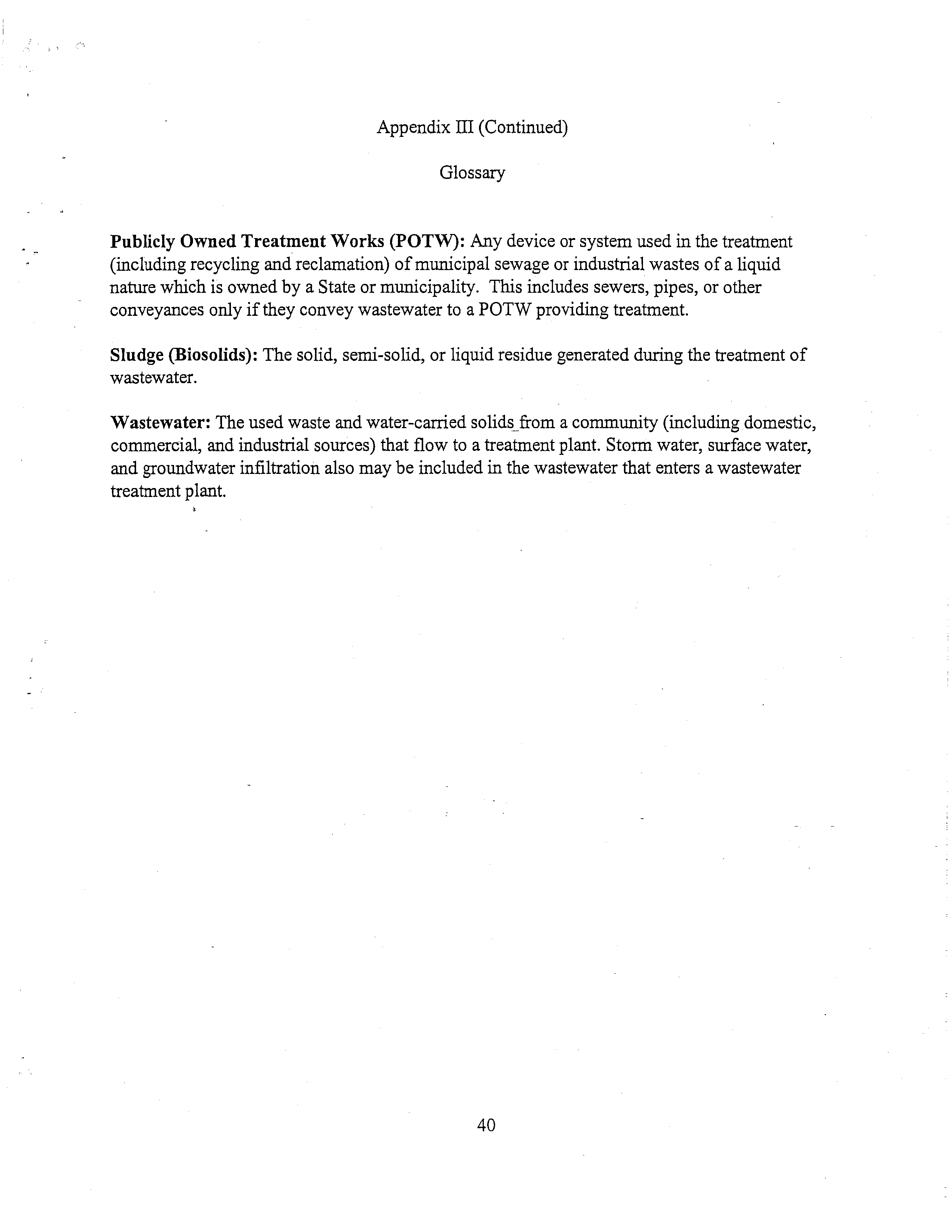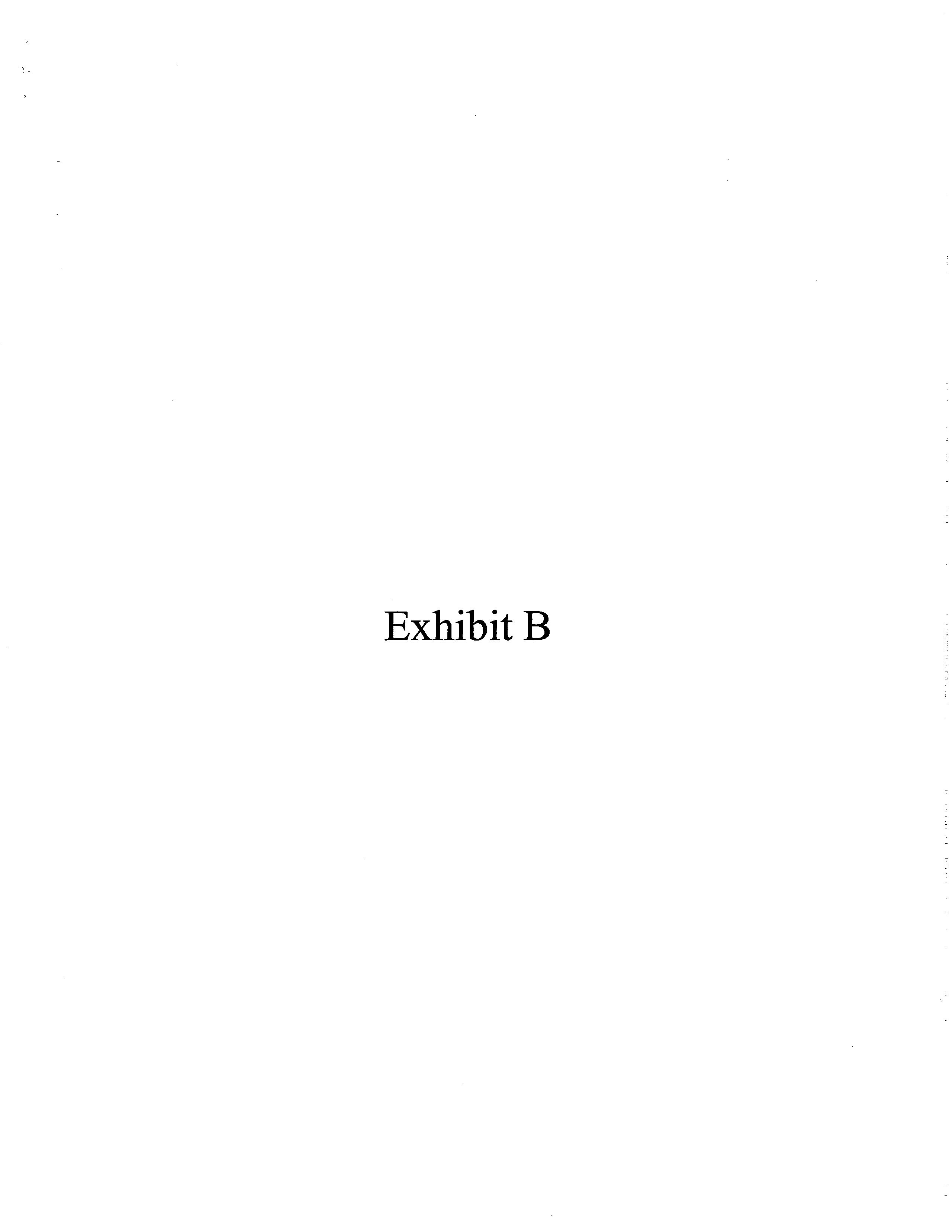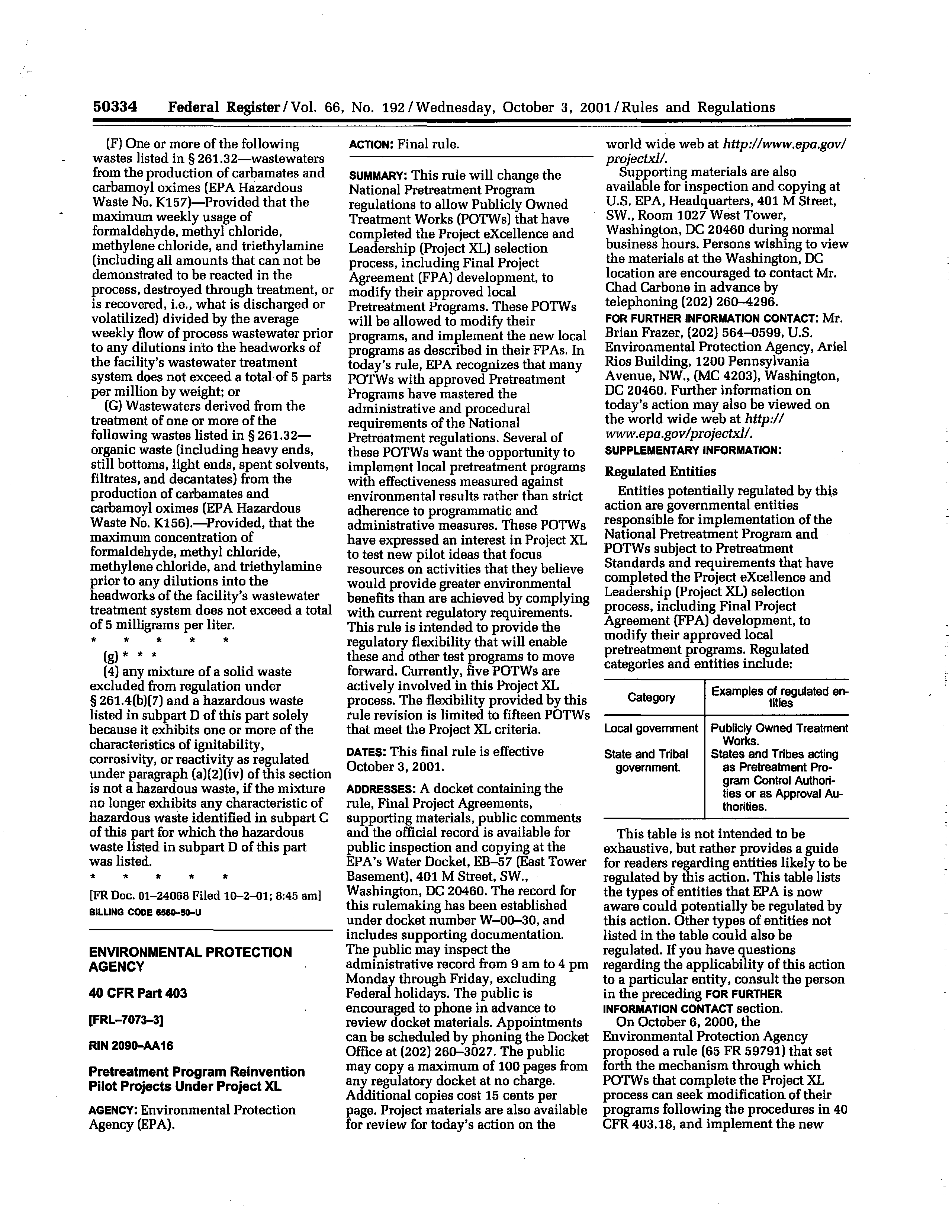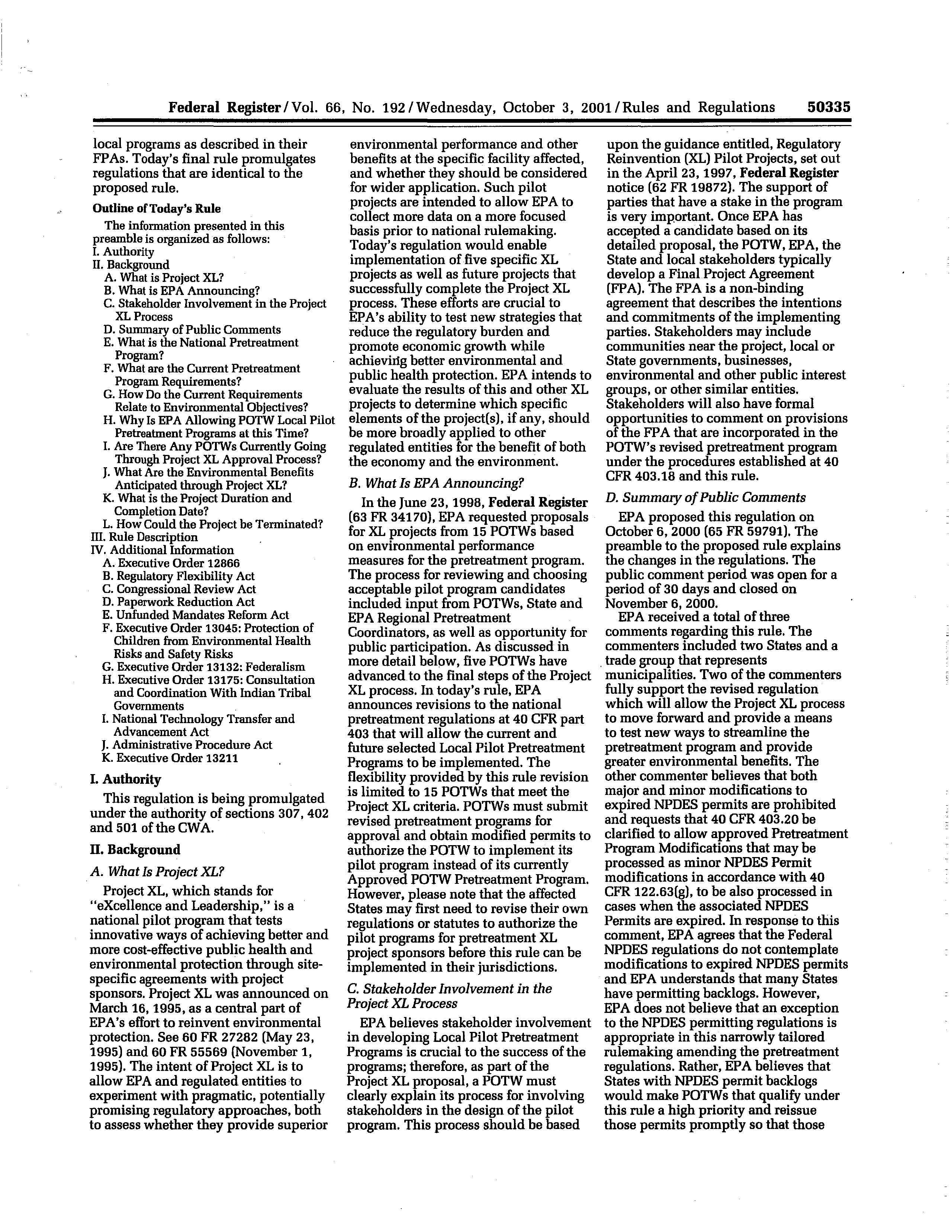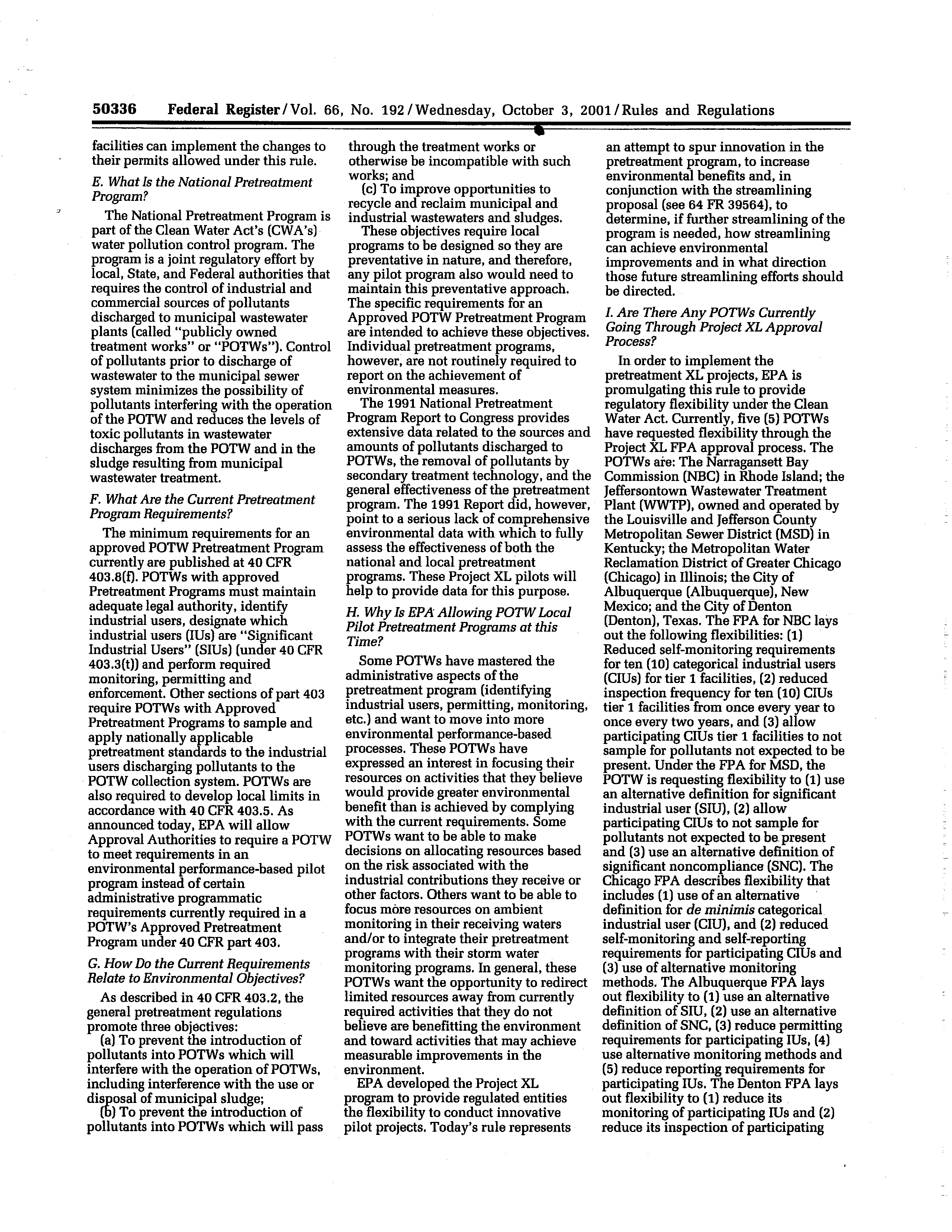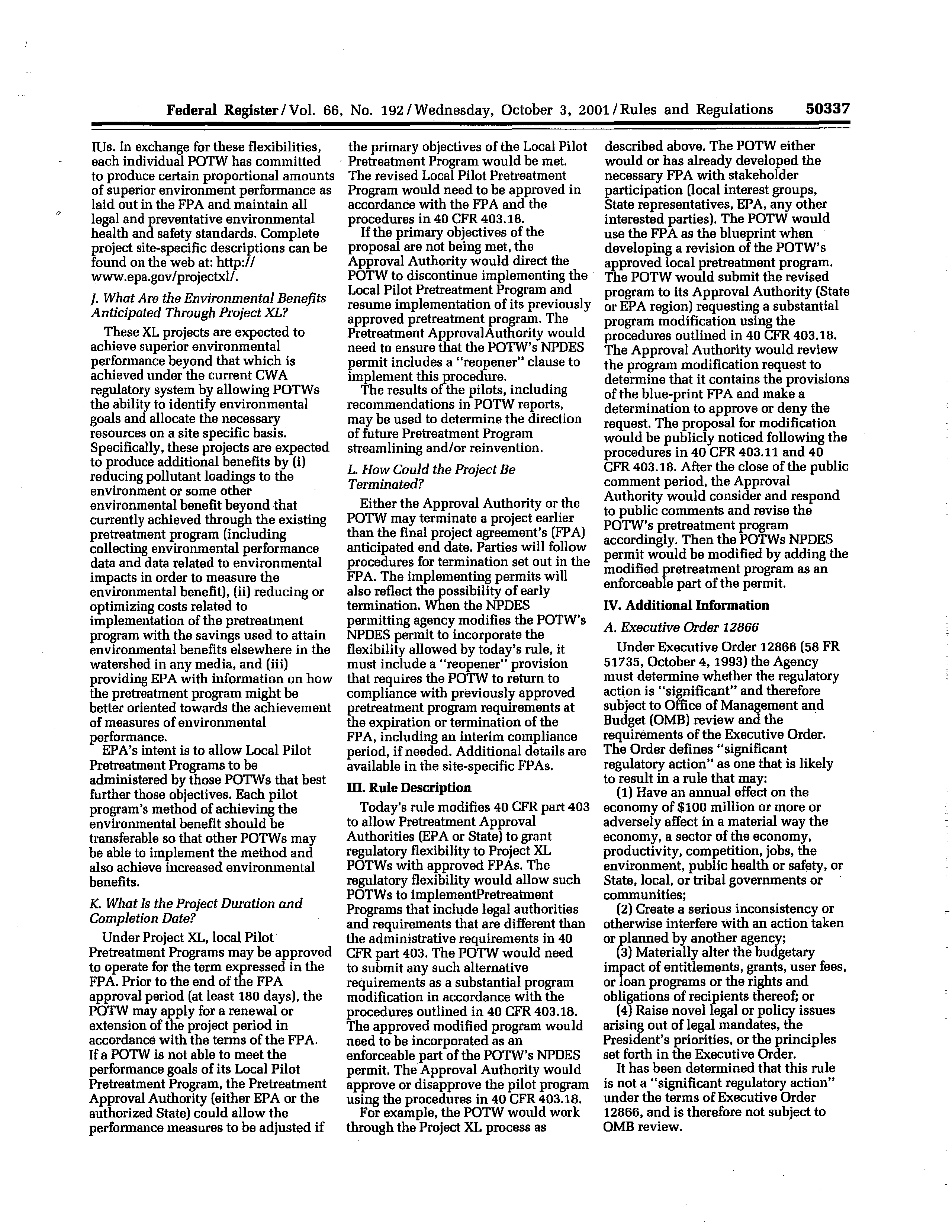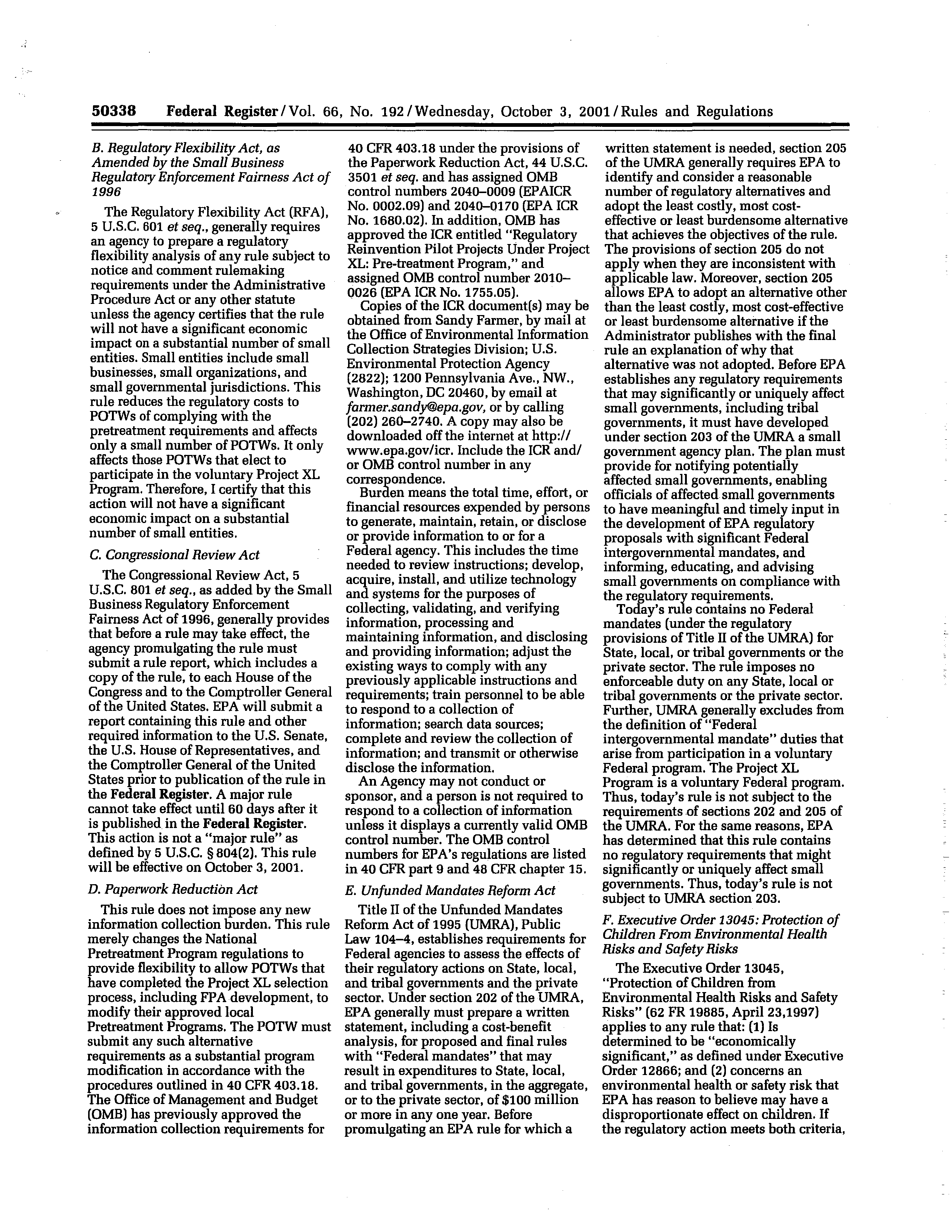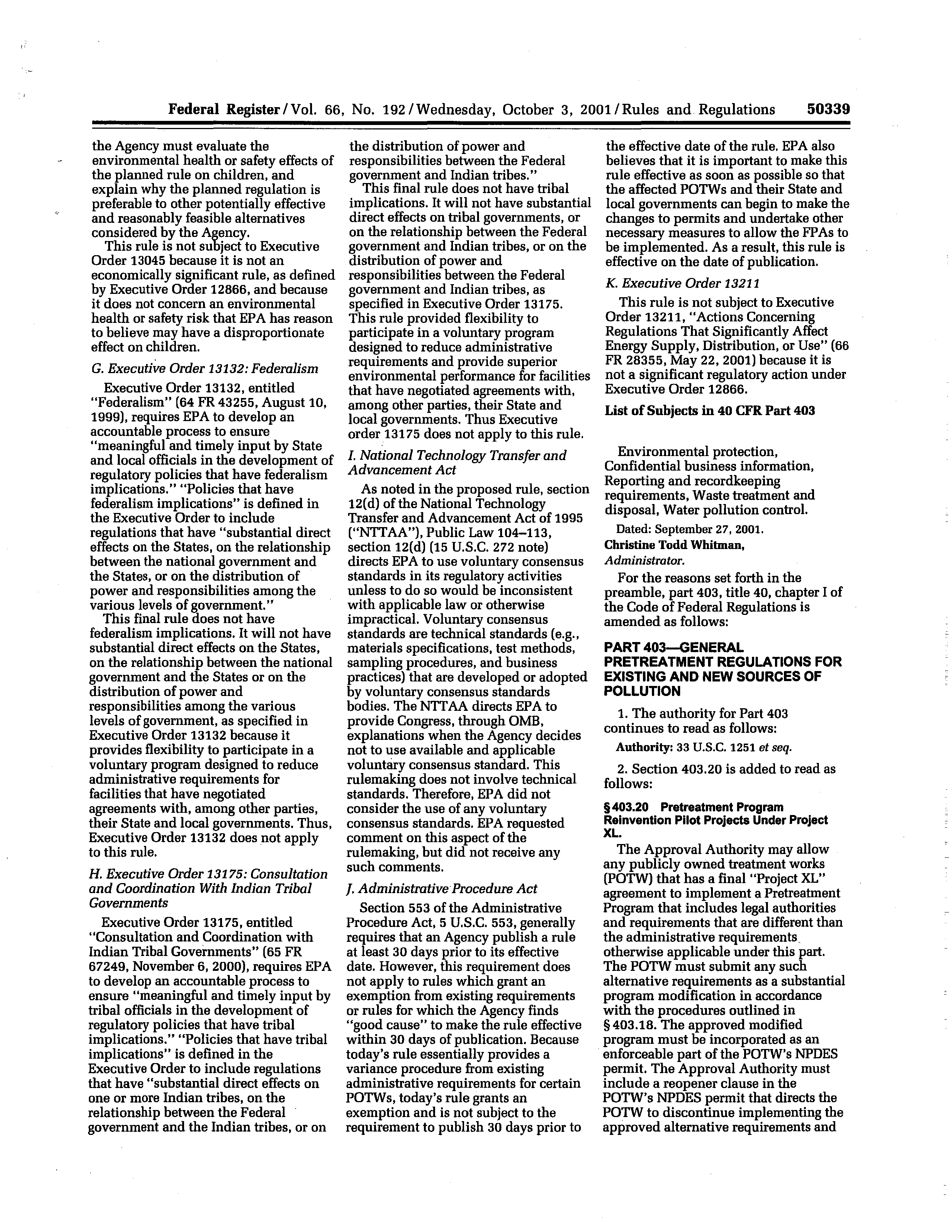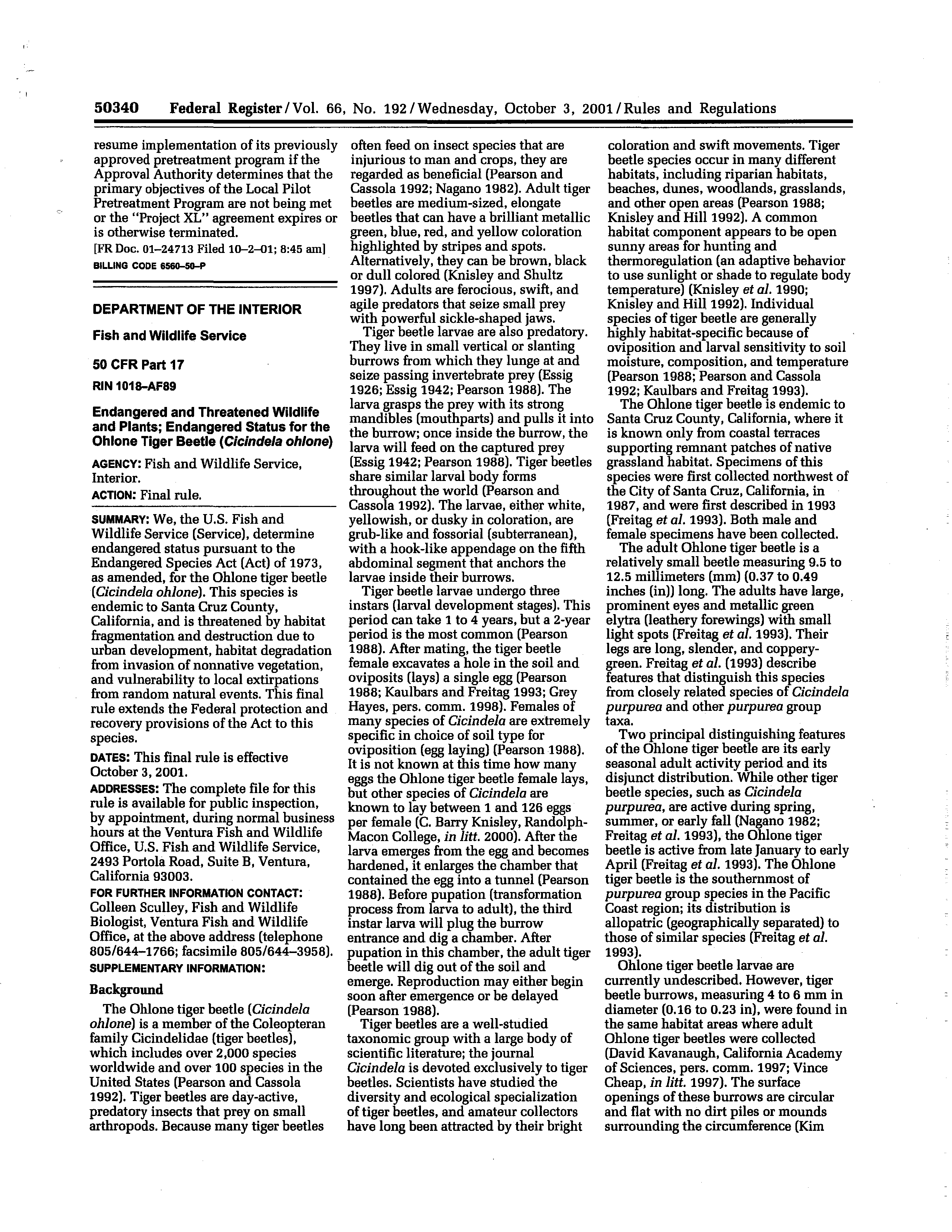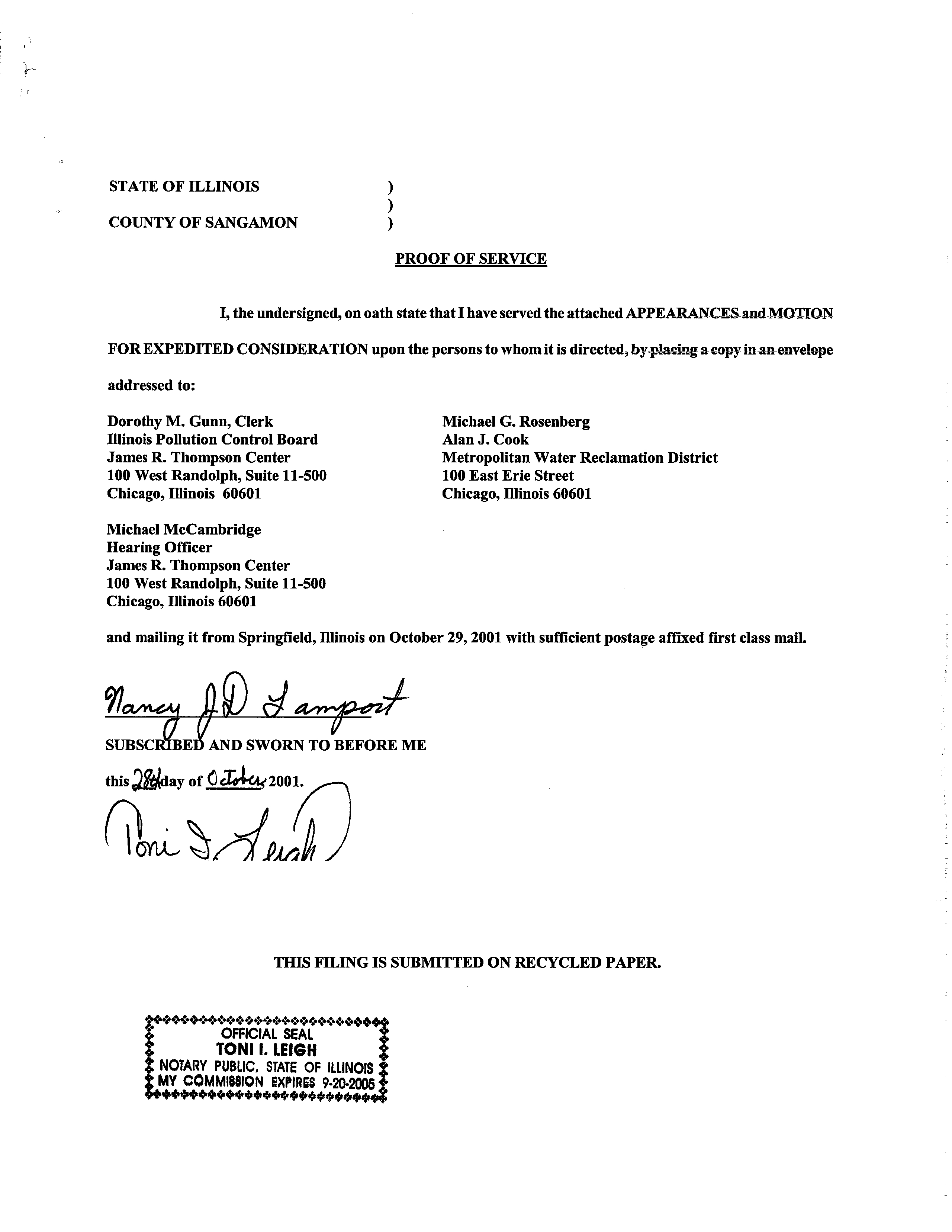ii
I
~
(~
~
U
~
~
;~k
\~‘j1~
~
j\..•W.
~
~!.
BEFORE THE ILLINOIS POU.U’IiON CONTROL
BOARD
NOTICE
Dorothy M. Gunn, Clerk
Michael G. Rosenberg
Illinois Pollution Control Board
Alan J. Cook
James R. Thompson Center
Metropolitan Water Reclamation District
100 West Randolph, Suite 11-500
100 East Erie Street
Chicago, illinois 60601
Chicago, Illinois 60611
Michael McCambridge
Hearing Officer
James R. Thompson Center
100
West Randolph, Suite 11-500
Chicago, Illinois 60601
PLEASE
TAKE
NOTICE that I have today filed with the Office of the Clerk of the Pollution
Control Board the APPEARANCE
of the illinois Environmental Protection
Agency and of the Metropolitan
Water Reclamation District of Greater Chicago and a MOTIONFOREXPEDITED CONSIDERAT-ION-in~the-
above matter on behalfof the Illinois Environmental Protection Agency and the MetropolitanWater-Reclamation
District of Greater Chicago, a copy of which is herewith served upon you.
ENVIRONMENTALPROTECTION AGENCY
OF THE STATE OF ILLINOIS
By:
Connie L. Tonsor
Associate Counsel
Special Assistant Attorney General
Division of Legal Counsel
ARDC # 6186313
Date: October 29, 2001
illinoisEnvironmental
Protection Agency
1021 North Grand AveEast
P.O. Box 19276
Springfield, IL
62794-9276
Coflti~o/Bd
IN THE MATTER OF:
)
)
WASTEWATER PRETREATMENT
)
UPDATE, USEPA AMENDMENTS
)
(January 1, 2001 through June 30, 2001)
)
)
)
R02-3
(Identical-in-Substance
Rulemaking-Public Water Supply)
THIS FILING IS SUBMITTED ON RECYCLED PAPER
iN THE MATTER OF:
WASTEWATER PRETREATMENT
UPDATE, USEPA AMENDMENTS
(January
1, 2001
through June 30, 2001)
APPEARANCE
The undersigned, as one ofits attorneys, hereby enters her Appearance on behalf ofthe
Illinois Environmental Protection Agency.
ILLINOIS ENVIRONMENTAL
PROTECTION AGENCY
By:
DATED: October 29, 2001
Illinois Environmental Protection Agency
1021 North Grand Avenue East
Post Office Box 19276
Springfield, Illinois 62794-9276
(217)
782-5544
—I
BEFORE THE
ILLINOIS
POLLUTION CONTROL BOARD
RECEIVED
CLERK’S
OFFICE
OCT
3
1
2001
)
STATE OF IWNOIS
)
Pollution Control Board
)
R02-3
)
(Identical-in-Substance
)
Rulemaking-Public Water Supply)
)
Connie L. Tonsor
Associate Counsel
Division ofLegal Counsel
THIS FILING ISSUBMITTED ON RECYCLED PAPER
eL~rn~~
O~~1CE
OCT
s
12001
BEFORE THE
ILLINOIS POLLUTION
CONTROL
BOARD
STATE OF IWNOI$
Pollution
Conèpôi Board
IN THE MATTER OF:
WASTEWATER PRETREATMENT
UPDATE, USEPA AMENDMENTS
(January
1,
2001 through June 30, 2001)
)
)
)
R02-3
)
(Identical-in-Substance
)
Rulemaking-Public Water Supply)
)
)
APPEARANCE
I
hereby
file
my
appearance
in
this
proceeding
on
behalf of the
Metropolitan
Water Reclamation District of Greater Chicago.
Metropolitan
District of Greater Chicago
Water
Reclamation
DATED:
October 26, 2001
Metropolitan Water Reclamation
District ofGreater Chicago
Michael G. Rosenberg
AlanJ. Cook
100 East Erie Street
Chicago, Illinois 60611
(312)751-6588
Michael G. Rosenberg, Attorn~-~
THIS FILING IS SUBMITTED ON RECYCLED PAPER
t~i~V~p
?~Ij~
OF~P1CE
OCT
2001
BEFORE THE ILLINOIS POLLUTION CONTROL BOARD
~TATE
OF IWNOIS
Pollution Control Board
IN
THE
MATTER
OF:
)
)
WASTE
WATER
PRETREATMENT
)
R02-3
UPDATE, USEPA AMENDMENTS
)
(Identical-in-Substance
(January 1, 2001
through June 30, 2001)
)
Rulemaking-Public Water Supply)
)
)
MOTION
FOR
EXPEDITED CONSIDERATION
NOW COME
the
ILLiNOIS
ENVIRONMENTAL
PROTECTION AGENCY (“Illinois
EPA”),
by
one of
its
attorneys,
Connie
L.
Tonsor
and
the
Metropolitan
Water Reclamation
District of Greater Chicago (“MWRDGC”) by its Attorney,
Michael G. Rosenberg, and pursuant
to
35
111.
Adm.
Code
101.512,
move
for
Expedited
Consideration
of
the
United
States
Environmental Protection Agency (“US EPA”) Pretreatment Program Reinvention Pilot
Projects
Under Project XL, amendments to 40 CFR Part 403, 66 Fed. Reg.
50334
(October
3, 2001) in the
instant docket.
In support of the Motion the illinois EPA andthe IvIV~TRDGCstate the following:
1.
Pursuant to
Sections 7.2 and
13.3
of the
illinois Environmental Protection
Act (“Act”),
415
ILCS
5/7.2,
13.3,
the
illinois
Pollution
Control
Board
(“Board”)
shall
adopt
regulations
which are
identical in
substance to
federal regulations
or
amendments that are
promulgated by
USEPA and that are necessary to implement Sections
3 07(b), (c), (d), 402(b)(8) and 402(b)(9) of
the Federal Water Pollution Control Act (“FWPCA”), as amended, 33 USC
§~
1317, 1342 (Clean
WaterAct Sections 307, 402).
415
ILCS
5/13.3.
2.
On
October
4,
2001,
the
Board,
in
the
instant
docket,
proposed
for
public
comment
federal
wastewater
pretreatment amendments
that the
USEPA had adopted
in
the period
from
January
1, 2001
through June 30, 2001.
3.
The Board noted:
“As of the date of this opinion and accompanying
order, we have not
identified
any
USEPA
actions
since
June
30,
2001
that
further
amend
the
wastewater
pretreatment
rules.
When
the
Board
observes
an
action outside
the
nominal
timeframe
of a
docket that would require expedited consideration in the pending docket, the Board will expedite
consideration of those
amendments.
Federal actions that
could warrant expedited consideration
include
those
that
directly
affect
the
amendments
involved
in
this
docket,
those
for
which
compelling
reasons would
warrant consideration
as
soon
as
possible
and those
for
which the
Boardhad received a request for expedited consideration.”
R02-3
at p. 3.
4.
On August 20,
2000, the Illinois EPA,
the
USEPA and the
MWRDGC
entered
a
fmal
agreement
endorsing
the
MWRDGC’s proposed
Project
XL
modification
of its
pretreatment
program. (Exhibit
A)’
The MWRDGC has
an
application for modification of its pretreatment
program pending before USEPA Region 5.
Project
XL
is a process by which publicly
owned
treatment works (“POTWs”) that have mastered the administrative and procedural requirements
ofthe national pretreament regulations, incorporated into Illinois regulations
111
35
ilLAdm.-Code
310,
may
implement
local
pretreatment
programs
with
effectiveness
measured
against
environmental results rather than strict adherence to programmatic and administrative measures.
5.
MWRDGC is one of fifteen POTWs that have participated in the Project eXcellence and
Leadership (“Project XL”) process
on
the
national
level.
It now seeks to
implement
test pilot
ideas that will
focus resources on
activities
that
it and the
illinois
EPA believe would
provide
greater
environmental
benefits
than
are
achieved
by
complying
with
current
regulatory
requirements.
6.
An amendment to 40 CFR 403 was needed to
adopt the flexibility at the federal level for
the Project XL.
An identical-in-substance amendment of the illinois regulations in 35 Ill. Adm.
Code
310
is needed prior to the
illinois EPA being able to
incorporate the
Project XL
program
into an existing permit for the MWRDGC.
Note:
The signing process necessitated preparation of copies ofthe final document prior to the signing
ceremony.
The Illinois
EPA has included the signature pages with the FinaLAgreernentinExhibitA.
7.
On
October 3, 2001, the USEPA adopted amendments to 40 CFR 403
by adding Section
403.20.
The
amendment, effective on October 3, 2001, provides that the approval authority may
allow any publicly owned treatment works (“POTW”)
with a
final “Project XL” agreement
to
implement a pretreatment program
that
includes
legal
authorities
and requirements
which
are
different thanthe administrative requirements otherwise applicable under part 403.
The approved
modified program must be incorporated as
an
enforceable part of the
POTW’s NPDES permit.
66 Fed. Reg.
50339.
The
October 3, 2001
amendment allows a pilot project
for the MWRDGC
that the USEPA has
characterized as
“crucial to EPA’s
ability” to test new strategies that reduce
the regulatory burden and promote
economic
growth while achieving better environmental
and
public health protection.
66
Fed. Reg. 50335. (Exhibit B)
8.
The Illinois EPA
and the MWRDGC urge the Board to include the revisions of 40
CFR
403,
found at
66
Fed.
Reg.
50334 in
this rulemaking docket.
Implementation of the Project XL
agreement
as
soon
as
possible
will
further
the
goals
of the
environment
and
streamline
the
process of effective administration of the pretreatmentprogram.
‘SATherefore, the Illinois Environmental Protection Agency andthe MWRDGC respectfully
move
that
the
Board include
the
October
3,
2001
Pretreatment
Program
Reinvention
Pilot
Projects Under Project XL, 66 Fed. Reg. 50334, amendment in R02-3.
Illinois Environmental Protection Agency
October
25,
2001
1021 North Grand Ave. East
P.O. Box 19276
Springfield,IL 62794-9276
(217) 782-5544
Michael G. Rosenberg
Alan
J. Cook
100 East Erie St.
Chicago, IL 60611
(312) 751-6588
By:
___________
Connie L.
Tonsd’r
Metropolitan Water Reclamation District ofGreater Chicago
)1~J
J~
By:
Michael G. Rosenberg
AFFIDAVIT
I,
Richard
C. Sustich, being duly swornon oath, state as follows:
1.
I am AssistantDirectorofResearch and
Development, Industrial Waste
Division, with theMetropolitan Water Reclamation District ofGreater
Chicago.
2.
As part ofmy position I have worked withthe ProjectXLprogramandam
familiarwiththe factual assertions stated in theMotion for
Expedited
Consideration.
3.
I swear and affirm thatthe factual information within theMotion is
true
and
correct and that I
am competent to t
ti
to the same.
RicIard C.
Sustich
SUBSCRIBED AND
SWORN to
Before me this
~Se
day of
t~’&1b~(,
2001
1\
i’Z/o~ç9~
7I’Kl-
Nota4’ Public
~
OFFflc~~
SEAL
~
AL/~cUc;ç~~ç~q(
Exhibit A
Metropolitan Water Reclamation District of Greater Chicago
Project XL
Final Project Agreement
August 30, 2000
In Collaboration with:
United States Environmental Protection Agency
illinois Environmental Protection Agency
Table of Contents
I. ProjectXL andFPA
A.
PurposeofProjectXL
B.
Purpose of
this
Final Project Agreement
II.
Executive
Summary
3
ifi.
Existing Pretreatment
Program
Requirements
.~..
A.
Industrial
Waste
Survey Requirements
B.
Permitting
Procedures
C.
Monitoring
Requirements
D.
Enforcement
Procedures
E.
Reporting
Requirements
~.
~.
.
~.
.~.
F.
Local
Limits
Development Process
G.
Current
Resources
~
liv
Project
XL Pil~tProject Description
and
ProposedResources
9
A. Project Description
B. Proposed Resources
~...
1.8
V. PROJECTXL CRITERIA
1.8
A. SuperiorEnvironmental Performance
B. Cost Savings
and
PaperworkReduction
~20
C. Stakeholder Involvement
D. InnovatiorilMulti-MediaPollutionPrevention
. .~.
~~21
E. Transferability
~
F. Feasibility
~
21.
G. Monitoring, Reporting,
and
Evaluation
.22
H.
Shifting of Risk
Burden
.
~~22
VI. Implementation
.
.~.
VII. Events Preventing Project
Implementation!
Unavoidable Delays
23
VIII.
Enforceability of the FPA
IX.
Duration of Agreement
X.
Amendments
or Modifications to
the Agreement
~.24
1
XI.
Termination
of
Agreement
A.
Expectations Concerning Termination
25
B.
TerminationProcedures
.~.
~~26
C.
Post-Project Compliance Period
26
XII. Dispute Resolution
~--
..-~-.
.~
XIII.
Right
ofOther
Legal
Remedies
Retained
....~..
27
XIV.
Transfer ofProject Benefits and
Responsibilities
~28
XV.
Reporting and Periodic Reviews
28
XVI.
EffectiveDate
XVII.
FPA Contacts
~
.
.
XVffi.
FPA Signatories
Appendix I: Proposed
Maximum
AllowableDischarge forDi
Minimis CIU Designation
32
Appendix II: Performance Measures to be Incorporated into the
Annual Pretreatment Report
37
Appendix III:
Glossary
.......~.
3.9
2
I.
Purpose of Project XL and the FPA
A.
Purpose ofProject XL
Project XL, which stands for“eXcellence
and Leadership,” is a national
pilot
program
to test the
extent towhich regulatory flexibility,
and
other innovative environmental approaches~
can
be
used to
achieve
superior environmental performance and
reduced economic burden. Through
site-specific agreements
with
project sponsors,
EPA is
able to gather data
and project experience
thatwillhelpthe Agency redesign current approaches to public health
and environmental
protection. UnderProjectXL, sponsors—private facilities,muItip1~facilities, industry sectors,
federal facilities, communities
and states—can
implementinnovative strategies thatproduce
superior environmental performance, provide flexibility, cost savings,paperworkreduction or
otEer
benefits to sponsors,
and
promote greater accountability to stakeholders.
B.
Purpose of this Final Project Agreement
This Final Project Agreement(Agreement) is ajoint statementofthe plans, intentions
and
commitments
of theU.S. EnvironmentalProtection Agency (EPA), Illinois EPA
(EPA),
and
the
MetropolitanWater Reclamation District of
Greater Chicago (District) to
carry
out
this
pilot
Project approved forimplementation at the District. ThisProject willbe
part
ofEPA’s Project
XLprogram to develop innovative approaches
to environmental protection.
TheAgreementdoesnot create legal rights or obligations and is notan enforceable contract or a
regulatory action suchas apermit or a rule.
This
applies to both the substantive
and
the
procedural provisions of
this
Agreement. While the Parties to the Agreement fully intend to
follow these procedures, they
are
not legally obligated to do so. Formore detail, please refer to
Section VI. Implementation.
Federal
and
State
flexibility
and enforceable
commitments
described in
this Agreement will be
implemented and
become
effective through
site-specific regulations
and
modification ofthe
existing NPDES permits
forthe District’s facilities.
All
Parties
to
this Agreement
will
strive for
a high level of cooperation, communication,
and
coordination to assure successful, effective, and
efficientimplementationofthe Agreement
and
the Project.
IL
Executive
Summary
This Final
ProjectAgreement (FPA) is an
outgrowth
of theEPA’s
June23,
1998, Federal
Register
Notice (Volume 63,
Number
120)
requestingproposals
from
Publicly
Owned Treatment
Works (POTWs) forXL projects
based
on environmentalperformance measures forPretreatment
Programs.
The intent ofthis effort is to investigateways ofincreasing the effectiveness ofthe
nationalPretreatment
Program and thus to obtain greater environmental benefit.
EPA
is willing
3
to providePOTWs regulatory relieffromprogrammatic requirements (e.g., specific monitoring
frequencies, specific controlmechanism issuance requirements, etc.), so that they
can implement
alternative programs that increase environmental benefits.
The District
is a POTW that treats wastewater from domestic, commercial,
and industrial sources
located in the
city
ofChicago
and
126
surrounding communities in
Cook County, Illinois. The
District
has maintained
an
industrial
waste Pretreatment
Program
formore
than 30 years.
Discharges fromthe District’s water reclamation plants (WRP)
are
in full compliance with all
applicable standards oftheir respectiveNational PollutantDischargeElimination System
(NPDES)
permits,
and
biosolids generatedby District
WRPs conform
to the Exceptional Quality
(EQ) criteria ofthe Standards
fortheUse
and Disposal of Sewage Sludge (40
CFR
503).
Through its Pretreatment Program, which it is required to
operate under its NPDES permits, the
District
regulates process wastewater discharges fromapproximately 530
Significant Industrial
Users
(SliT), including
358
Categorical Industrial
Users (CIU),
as ofJune 1, 2000.
In 1996, the
United States Environmental ProtectionAgency
(EPA)
awarded the District the National
ExcellenceAward for Pretreatment Programs in theLarge Category (greater
than
100
SliTs).
Basedon~thesuccess ofits traditional command-and-controlPretreatmentProgram, the District
is in a,position to develop
and
evaluate apilot program incorporatingmany ofthe regulatory
reinvention initiatives recommended by
the
EPA,
theAssociation ofMetropolitanSewerage
Agencies
(AMSA),
the Water Environment Federation
(WEF),
and
the regulated industrial
community.
-
The
intended result ofthis project is the achievement ofenvironmental performancebetter
than
would otherwisebe achieved under
the District’s current program.
A further principle for the
District’s participation
in ProjectXL is that participationmustnot result in a net increase in
Pretreatment Program costs, while
there is substantial likelihood thatparticipationcould result in
a long-term reduction in Pretreatment Program costs.
Therefore, resources for any additional
activities under Project XL can only be provided through operational and regulatory flexibility in
existing Pretreatment Program activities,
with reallocation offreed resources.
These reallocated
resources, in turn, willbe
committed to
achieving
improvements beyond
current environmental
-
performance.
Current environmental performance, including maintenance of
Part
503 EQ
sludge criteria, must
be maintained. Program modifications
or activities with the potential for degradation of
environmental performance will
notbe considered under
this
ProjectXLpilot project.
Inthis XLpilot project, four interrelated activities will demonstrate the application of
• performance-based oversight flexibility withinthe District’s existing Pretreatment Program
framework.
Resources currently allocated to programmatic activities with low potential
for
environmental benefit will be reallocated to new Pretreatment Program activities with a greater
• potential for environmental benefit.
These four activities are summarized briefly below.
4
• 1.
•
To effectuate
this project, EPA and
EPA
need to give the District regulatory flexibility
with regard to its. obligation under the General Pretreatment Regulations to provide regulatory
oversight to small
Categorical Industrial Users (ClJs)
into the District’s WRPs.
While oversight
flexibility may not result in direct environmental benefit, such flexibility will allow the District
to reallocate currently committed resources
to other activities with greater potential for
environmental benefit.
2.
The format ofthe District’s Pretreatment Program Annual Report will also need to be
revised to include detailed informationregarding environmental performance that
is not currently
required in the Annual Report.
To offset the District’s commitment to
include this additional
information in its Annual Report, detailed oversight information regarding SliTs will need to be
limited to
only the population ofSills that were found in significant noncompliance at any time
during the reportyear.
3.
Approximately 276 ofthe 358 CIUs regulated underthe District’s Pretreatment Program
are electroplating/metal finishing facilities.
Under the EPA’s
Common
Sense Initiative,
EPA
and the Metal Finishing Sectorhave established the national Strategic Goals Program (SGP) to
facilitate sector-wide environmental performance improvement, including promoting “beyond
compliance” performance by sector leaders.
The District has actively supported the objectives of
the SGP and is currently implementing sri SGP program in the greater Chicago area, in
cooperation with EPA and the EPA.
To furtherpromote the objectives of EPA’s Sector Initiatives, the District will create Strategic
Performance Partnerships (Partnerships) with metal finishing facilities that fully achieve the
individual facility goals outlined in the SGP.
Under these Partnerships, the District will work
cooperatively with demonstrated sector leaders to develop, test, and implement alternative
measurement systems for demonstrating environmental performance.
The District also
intends to
extend Partnership opportunities to CUJs in other industry
sectors in coordination with EPA’s
SectorInitiatives.
4.
Like most POTWs across the nation, the District,
through its Pretreatment Program, has
achieved substantial environmental gains relative to the non-conventional pollutants and heavy
metals, which have been regulated under the NPDES and the District’s local limits for many
years.
However, the same cannot be systematically said for otherpriority pollutants that may be
ofconcern on a local scale.
To address these pollutants, the District will develop Toxic
Reduction Action Plans (TRAPs).
Under TRAPs,
the Parties (District, EPA andEPA) will use existing environmental data (i.e.,
District emission and discharge data and multi-agency ambient environmental monitoring data)
to
identify priority pollutants which are documented to be present in quantities or concentrations
that may be a risk to the District’s facilities or the ambient environment but not
currently subject
to regulation, and. rank these pollutants in order ofimportance to
stakeholders.
As resources
become available through the regulatory flexibility described above, the District will commit to
5
specific reductions in the levels of these pollutants in WRP emissions and discharges through
source control.
Sincethese activities would be outside the existing regulatory structure, the
District will be free to use informal action (i.e., educational outreach and pollution prevention)
for these efforts.
The Parties recognize that non-regulatory activities maynot achieve the
anticipated pollutant reductions, but the lessons learned could provide direction for further efforts
and opportunity for future projects.
flI.
Existing PretreatmentProgram Requirements
The following section describes the current status ofthe District’s existing approved
Pretreatmônt Program.
Full annual reports for the District’s Pretreatment Program, beginning in
1995
are available throughthe District’s Public Information Office, (312)
751-6633.
A.
Industrial Waste Survey Requirements
Under its
existing approvedPretreatment Program, the District must identify all nonresidential
users tributary to its facilities, determine the nature oftheir activities and the pollutants discharge
therefrom into the sewerage system,
and advise each user ofapplicable Pretreatment Standards
and its obligation
to
comply with said standards.
The District accomplishes this survey through
ongoing
surveillance ofnon-residential areas ofits service area, through periodic review of
telephone directories, trade association publications, and the Illinois Manufacturers’ Association
directory.
The District also
annually solicits a listing ofall business licenses granted by the 126
individual municipalities within its service area for review.
Facilities identified as potential
industrial users are then sent a Facility Classification Questionnaire (FCQ) and directed to
describe in detail the nature oftheir operations.
FCQ forms are
processed
through a formal
review process and are verified through on-site inspections by District personnel.
Consistent with 40
CFR403.8,
under the District’s Ordinance, a nonresidential user is classified
as a Significant Industrial User (SItU) if it meets any ofthe following criteria:
1)
The Industrial User (RI) is subject to
regulation under a federal Categorical Pretreatment
Standard.
2)
The RI discharges greater than 25,000 gallons per day ofprocess wastewater into the
sewerage system.
3)
The Ill contributes
5
percent or more ofthe hydraulic load. or organic capacity ofthe
receiving WRP.
4)
The District has designated the IU as having a reasonable potential for adversely affecting
the operations of the District’s WRPs or for violating any
standard orrequirement
contained in the Ordinance.
6
An 1U
is a Categorical Industrial User (CR1) if it is subject to
reg
lation under
a federal
Categorical Pretreatment Standard (#1 above).
All CIUs are Sills.
B.
Permitting
Procedures
Facilities identified as potential Sills
through the industrial wastô survey process described
above are requiredto submit detailed Discharge Authorization Requests (DAR) (permit
applications) and to obtain Discharge Authorizations (DA)
(permits) from the District forthe
regulation ofprocess wastewaters.
DAs are issued for a period not exceeding five years and
contain specific limitations on the volume ofwastewater and concentrations ofpollutants
discharged from both categoricallyregulated and non-regulated industrial processes.
DAs also
contain specific reporting and self-monitoring requirements applicable to the SIU.
C.
Monitoring Require_ments
Under the District Sewage and Waste Control Ordinance (Ordinance) and DAs issued to
individual
Sills, each SRI is required to conduct
self-monitoring of its process
wastewater
discharg&and to submit Continued Compliance Reports (CCR) twice annually.
For process
wastewater discharges less than 200,000 gallons per day (gpd), the Sill must self-monitor the
wastewater discharge on at least three days during a two-week period for each semi-annual CCR.
Forprocess wastewater discharges exceeding 200,000 gpd, .the SItU must self-monitor the
wastewaterdischarge on at least six days during a two-week period for each semi-annual CCR.-
All monitoring must conform to
the provisions of 40 CFR 403.12
and all analytical methods
must conform to the provisions of40 CFR 136.
An authorized representative ofthe SRI must
certify all data contained in the CCR as accurate and complete.
The District inspects each Sill and monitors the process wastewater discharge from each SRI on
at least four days, annually; to verify continued compliance with the terms and provisions ofthe
DA
issued to
the Sill.
All monitoring must conform to the provisions of40 CFR 403.8
and all
analytical methods must conform to
the provisions of40 CFR 136.
D.
Enforcement Procedures
-
The District’s formal Enforcement Response Plan (ERP) was submitted to EPA, Region
5
in
December 1989
and was incorporated into the District’s Ordinance in 1991.
The ERP describes
the enforcement actions available to the District for responseto instances ofill noncompliance.
These actions range from informal Notices ofNoncompliance for non-significant noncompliance
to formal Cease and Desist (C&D) Orders for significant noncompliance.
The C&D Order
requires the submittal ofa formal Compliance Schedule, certified by an authorized representative
Of the 111 and a professional engineer registered in the state ofIllinois, and the submittal ofa Final
Compliance Report, including the results of self-monitoring conducted to verify that compliance
has been attained.
The ERP also contains a Response Option Matrix that identifies the minimum
enforcement response that may be considered in response to certain critical types of
7
noncompliance, such as those
instances involving pass-through and
interference.
The District has statutory authority to assess civil penalties in the range from $100.00
to
$2,000.00 for each day ofviolation, in administrative proceedings before its Board of
Commissioners, and to seek civil penalties in the range from $1,000.00 to $10,000.00 per day of
violation, in civil actions in the Circuit Court.
Wbile the District does not have statutory authority
to
initiative criminal proceedings, it does have authority and established policy forreferral of
potential criminal actions to the State’s Attorney’s
Office or the United States Attorney.
E.
Reporting
Requirements
As indicated above, under the District’s Ordinance and DAs, Sills are required to submit CCRs
semi-annually, to demonstrate continued compliance with applicable Pretreatment
Standards.
Under its NPDES
permits, the Districtmustsubmit
an annual PretreatmentProgram Report to
its
Approval Authority (currently EPA, Region
5),
detailing the District’s conformance with the
Pretreatment Program provisions contained in 40 CFR 403.8.
The annual report must include
detailed information describing the District’s resource commitment to the Pretreatment Program
as well as detailed information describing the compliance
status ofeach SRI.
F.
Local Limits Development Process
The District’s Ordinance
was
first
adopted
in 1969
and
has containedtechnically-based local
limits since 1971. These local limitswere developed through a stakeholderprocess involving
representatives ofthe District, the regulated
community and academia, and are considered
protective ofworker health
and safety, WRP
operations,
and
the environment. Local
limits are
reviewed annually by the District’s Research and Development
Department to ensure
appropriateness.
G.
Current Resources
As reported in the
District’s Pretreatment Program Annual Report
for 1999, the Districthas
devoted the followingresource levels -to administration ofits PretreatmentProgram.
8
Resource
Commitment
Field Surveillance
Staff
49.83
Full Time Equivalent Positions (FTE)
Enforcement Administration Staff
23.25
IFTEs
Analytical Laboratory Staff
11.14 FTEs
Legal Administration Staff
0.95 FTEs
Total PretreatmentProgram Budget
$7,258,622
IV
Project XL Pilot Project Description
and Proposed Resources
A.
Project Description
The followingdescribes theXLpilot project, andnotes howtheDistrict activities will differ from
current operations.
There willbe no change in the District’s Industrial Waste Survey
Requirements (described above
in
Section III. A.),EnforcementResponse Plan (described above in SectionIII. D.),
and Local
Limits Development and Review Process (described above in Section III. F.).
1.
Reduced Oversight ofDe Minimis and Non-Significant Categorical Industrial Users
This project is intended to provide regulatory flexibility to the District with respect to the
oversight ofsmall CRIs that have very low potential to violate Pretreatment Standards and
Requirements or adversely impact the operations ofthe District’s WRPs and the environment.
Under current regulations all CIUs are classified as Sills.
This pilot project creates two categories
of CIII that are not significant industrial users (SilJ).
For purposes ofthis project there are two
categories ofsmall
CRIs:
(1) de minimis and (2) non-significant categorical industrial users.
Currently, the District re~eives
wastewater from 358
CilJs.
In this XL project, the District
is
seeking to reduce the oversight requirements for “de niinimis” and “non-significant” CIII
facilities.
This part of the XL proposal is consistent with EPA’s proposal regarding “non-
significant” categorical industrial users in its July 22,
1999, Pretreatment Streamlining Proposal
(64 FR 39564).
These reduced oversight requirements will not deregulate~anyCIII in the sense
that they are no longer required to comply with Categorical Pretreatment Standards.
Rather, this
9
approachwillreduce boththe CilJ’s
and the District’s burden in demonstrating compliance with
the applicable
standards.
A
CIII
will be considered as de minimis if it discharges no untreated categorical wastewater and it
discharges a total ofless than 100 gallons per day ofprocess wastewater, or if it is only subject to
certification requirements ofapplicable categorical standards.
In addition, the CR1 will not have
been in significant noncompliance (SNC), as defined at 40 CFR 403.3(t), with applicable effluent
discharge standards or requirements forthe prior eight consecutive calendar quarters.
The oversight reductions for those CilJs that meet the de minimis criteria would include:
Non-expiring DischargeAuthorizations (DAs)
Reduction in frequency ofself-monitoring from twice per year to
at the District’s
discretion. These Clils would be requiredto report annually to verify their de minimis
status.
The District will perform a minimum of one random site visit annually.
The site visit will
include,
at a minimum, verification ofproper operation ofwastewater pretreatment
facilities n~ecessary
to maintain compliance with applicable standards and a grab sampling
ofthe CIU’s discharge to the sewerage system.
The District is also seekingreduced oversight requirements for small capacity “non-significant,”
CilJs.
To qualify as a non-significant CIII, the process wastewater subject to Categorical
Pretreatment Standards that
is, discharged from the facility:
Shall not exceed 0.0.1 percent ofthe hydraulic capacity ofthe receiving
WRP or 10,000
gallons per day, whichever is less,
Shall not exceed 0.01
percent ofthe organic treatment capacityofthe receiving WRP, and
Shall not, for all applicable pollutants, exceed 0.01
percent ofthe five-year average
headworks loading at the receiving WRP.
The maximum allowable discharge criteria fornon-significant CRIs tributary to each ofthe
District’s seven WRPs are shown in Appendix I.
In addition:
The
CIII
will not have beenin significant noncompliance (SNC),
as defined at 40 CFR
403.3(t), with applicable effluent discharge standards orrequirements forthe prior eight
consecutive calendar quarters.
The District will reassess conformance ofeach non-significant CIII with the above four criteria at
least annually.
The oversight reductions for those CRIs that meet the non-significant criteriawould include:
10
Non-expiring Discharge Authorizations (DAs)
Reduction in
frequency ofself-monitoring
and
submittal ofcompliance reports
from twice
per year to once per year
•
Reduction in frequency of full facility inspection and sampling by the District from once
per year to once every two years
•
During non-inspection years, the District will perform a minimum ofone random site visit
and sampling.
Conformance with the conditions set
forth in the definitions ofde minimis and non-significant
CIII will be reassessed at least annually by the POTW.
If a facility no longer falls within the
scope ofthe de minirnis ornon-significant CIII definition because of a change in the nature ofits
operations or if the facility is found in significant noncompliance (SNC), the facility’s status as a
de minimis or non-significant CIII willbe revoked and the facility will revert to full CIII status.
The District estimates that
80 ofthe 358
CRIs currently regulated under the District’s
Pretreatment Program would qualify for de minimis ornon-significant status.
At the time ofFPA
signature,
~t
is estimated that 2 ofthese 80
CIIJs would qualify as de rninimis and 78 of these 80
CIIJs would qualify as non-significant.
Under this XL pilot project, the District will continue to
ensure that
each facility is in compliance
with standards by issuing a Discharge Authorization (DA)
(permit) to each SRI as described
above in Section ifi. B.
Permitting Procedures.
Currently, under the General Pretreatment
Regulations, the District issues DAs to
all significant industrial users, both categorical and non-
categorical, for a period not exceeding five years.
The DAs will continue to contain specific
limits forthe volume ofwastewaterthat can be generated, maximum allowable concentrations for
pollutants in the wastewater, and requirements for self-monitoring and submittal ofcompliance
reports..
Under current District practice, even if nothing at the facility has changed when the DA expires,
the DA must be reapplied for and reissued.
Under this Project XL pilot project, however, de
minimis and non-significant CRIs willbe issued
“non-expiring” DAs.
“Non-expiring” permits
-
willbe subject to review at the District’s discretion and amended as appropriate.
This XL pilot project would also allow reductions in frequency only ofthe self-monitoring and
reporting requirements for non-significant CRJs from twiceper year to once per year.
In all other
respects, non-significant CRIs will be required to conduct self-monitoring equivalent to current
practice, as described above in Section ifi. C.
Monitoring Requirements.
(For process wastewater
discharges less than 200,000 gallons per day (gpd), the SRI must self-monitor the wastewater
discharge on at least three days during a two-week period for each CCR.
Forprocess wastewater
discharges exceeding 200,000 gpd, the Sill must monitor self-monitor the wastewater discharge
on at least six days during a two-week period for each CCR.
All monitoring must conform to the
provisions of40 CFR 403.12 and all analytical methods must conform to the provisions of40
11
CFR
136.
An authorized representative of the SRI must certify all data contained in the CCR as
accurate and
complete.)
Currently, the District inspects each SRI at least yearly and samples process wastewater on at
least four separate days each year.
Under this XL’pilot project, the inspection frequency would be
reduced from once a yearto once every two years fornon-significant CIUs,
and the sampling
frequency will be reduced to
once every other year for these ills.
The inspections conducted
under this XL pilot project willbe equivalent to those currently conducted, as described above in
Section III. C. Monitoring Requirements.
Only the frequency ofthe inspections would change
under the XL pilot project.
As in the Pretreatment Streamlining proposal, the de minimis
and non-significant CUJs will
still
be required to, comply with applicable categorical Pretreatment Standards and related reporting’
requirements.
The District will also still be required to perform oversight for these CRI’s as
currently required:
•
Notification to
CRJs oftheir status
and requirements,
•
Receipt and review ofrequired reports,
Random sampling and inspection, and
Investigation of noncompliance as necessary.
The proposed classification offull, non-significant, and de minimis CRIs, along with the
oversight flexibility described above, is summarized in Table 1.:
Where a de minimis CIII or non-significant CRI
is found to be in SNC, the District will modify
the ill’s DA to reflect full SRI status.
The RI would thenbe requiredto not be in
SNC
for 8
consecutive quarters and to
meet all other applicable criteriato regain its status as a de minimis or
non-significant CR1.
In addition, under the District’s Sewage and Waste Control Ordinance, RIs are required to notify
the District at least 30 days prior to
any change in operations or discharge practices and to receive
written approval of such’change from the District.- A de minimis CRI’s DA will be subject to
review or revision if its operations change significantly (new processes or increased discharge
loadings or flow rates that exceed the de minimis cutoffs.)
If sucha change alters the RIs
eligibility as a de minimis ornon-significant RI, the District will make such a notification to the
RI
and the RI will revertback to full CIII status.
Such a notice by anIII will also prompt the
District to
evaluate the appropriateness ofthe RI’s current DA,
A modification ofthe DA by the
District will be initiated if appropriate.
The SRIwill be required to comply with the additional
requirements causedby reversion to full SRI status, within 6 months of the date of reversion.
12
TABLE
1
SELECTIONCRITERIAFORFULL,NON-SIGNIFICANT, AND
DEMINIMIS
CATEGORICAL Th~DUSTRIAL
USER DESIGNATION
Qualification
DeMinimis
CRI
No discharge of
untreated categorical
wastewater and 100
gpd total process
wastewater discharge,
or subject to
certification
requirements only, no
SNC for four
consecutive six month
periods
Non-Significant
CIII
0.01
ofPOTW
design
flow, 0.0 1
of
POTW headworks
organic
load, 0.01
of
headworks load of
categorically regulated
pollutants, no
SNC for
four cOnsecutive six-
month periods
Full
CR1
Subject to
categorical
pretreatment
standards
and
not
qualified as DCRI
orNCRI
Permit length
Control Authority
discretion
Non-expiring, subject
Fiveyears
to Control Authority
review every five
years
Minimum
self-
monitoring
requirements
Minimum reporting
requirements
Control Authority
discretion
Annual
DCRI
certification
Annual
Periodic
Compliance Report
Twice/year
Twice
annual
Period
Compliance Report
Minimum Control
Authority monitoring
One random site
visit/sampling
annually
One full
inspection/sampling
every two years; one
random site
visit/sampling during
non-inspectionyears
Full
inspection/sampling
annually
Once/year
13
One of the anticipatedresults of the reduced oversight of de minimis
and non-significant CILJs is
that some facilities that do not initially meet these criteria may be prompted to implement
pollution reduction and water conservation measures in order to obtain de minimis or non-
significant CRI status.
This will result in decreased loadings ofregulated pollutants into the
WRPs.
While the oversight flexibility will not result in direct environmental benefit, it will allow
the District to allocate saved resources toward activities that have greater potential forbenefiting
the environment.
2.
Revisions to Pretreatment Program Annual Report
In accordance with the Federal pretreatment regulations and its NPDES permits, the District
is
required to submit a Pretreatment Program Annual Report (Annual Report) to
its Approval
Authority (EPA Region
5)
each year.
Along with details about staff and funding committed to the
pretreatment program, the Annual Report includes detailed information about the compliance
status ofeach regulated SRI. (Requirements for contents ofthe report appear in 40 CFR
403.12(i)).
Inthis
XL project, EPA
will propose to
amend their rules to require the Annual Report to provide
specific information for only those Sills found to be in significant noncompliance (SNC) during
the reporting year.
Currently, detailed information
and the compliance status related to all Sills (a
total ofapproximately 530) within the District’s jurisdiction are included in the Annual Report.
Under this project, the District would continue to
collect all ofthe information required in 40 CFR
403.12(i), and it would make the information available to EPA, Illinois EPA, and the public as
required.
The Report would not, however, include specific information about the facilities that
are not in SNC.
Information currently reportedin the Annual Report, not published in the revised Annual Report,
would be available through the District’s Public Information Office (312-751-6633).
A Freedom
of Information Act request would not be required to obtain this information.
As
a result of this revision, the number of facilities covered in the Annual Report would vary from
year to year, depending on the number of facilities that are in SNC in a given year.
Instead of
providing specific compliance information on the approximately 530
SRIs currently regulatedby
the District, with this change the number ofSRIs covered in the Annual Reportwould have been
227
in
1995,
208 in
1996, and 56
in 1997.
A second revision to the Annual Report as a result ofthis Agreement is to include additional
environmental data in the report that are not currently required.
The ~isttict
has been collecting
these data for a number ofyears for its own knowledge.
The data will provide more meaningful
information about the quality ofthe wastewaters being discharged and the quality ofthe waters in
the receiving surface water bodies.
The additional information will include summary data relating to the
18 performance measures
14
identified b.y the Association ofMetropolitan Sewerage Agencies
in its report entitled “Case
Studies in the Application ofPerformance forPOTW Pretreatment Programs” (1997).
These 18
performance measures ai~e
listed in Appendix. II.
The detailed reporting format for this additional
information will be developed with input from the Stakeholders.
This Agreement does not waive any of the requirements ofthe EPA
Construction Permit
Program.
The District and the EPA~are considering doing anotherpilot project under the State’s
Regulatory Innovation Pilot Program that would delegate management ofthe Construction Permit
Program for certain CRIs.
3.
Alternative Environmental Monitoring Systems
Under the General Pretreatment Regulations,
SRIs must conduct self-monitoring according to
rigorous sampling and analytical protocols provided by EPA.
The self-monitoring currently
required involves traditional, “end-of-pipe” sampling ofeffluent.
The District’belieyes this
type
ofmonitoring may not be ideal because it is relatively costly, it can only be done on an infrequent
basis (due to its cost), it is inconvenient, and it generally provides little to no feedback to the SRI
for improving its processes.
This XL project intends to pilot test alternative environmental monitoring approaches.
This
portion ofthe project willbe possible through reallocating the saved resources from the reduced
oversight of de minimis and non-significant CRIs and the revisions to the Pretreatment Annual
Report.
One possible alternative to traditional effluent discharge monitoring is to use statistical process
control data which is collected by the SRI at critical points within its process train, often at
intervals far more frequent than effluent discharge monitoring.
These data serve to regularly
trackprocess performance and product quality at the SRI, and could potentially serve to assess
pretreatment system performance and wastewater quality.
In order to implement the alternative monitoring systems, the District plans to form Strategic
Performance Partnerships
(.Partnerships) with a number of facilities involved in sector Strategic
Goals Programs (SGP).
Currently the only well-developed sector SGP initiative in the Chicago
area is for the metal finishing sector.
Under the Common Sense Initiative (CSI), EPA and the
Metal Finishing Sector have developed the first sector-wide SGP.
The SGP
established both
facility-specific and sector-wideperformance goals that extend beyond traditional compliance
with environmental regulations.
While the metal finishing sector is currently the only sector with
a well-developed SGP, this Project XL pilot project intends to
develop Partnerships with other
facilities from EPA’s Sector Initiatives as SGPs are developed and associated facilities become
interested in implementing alternative monitoring systems.
The District will extend the objectives ofEPA’ s Sector Initiatives through the Partnerships.
Under these Partnerships, the District will work cooperatively with demonstrated sector leaders to
15
develop, test
and
implement alternative measurement systems for demonstrating environmental
performance.
The District will work only with those facilities that have fully achieved the
goals
oftheirrespective SGPs.
Facilities involved in SGP initiatives tend to be forward-thinking and
have demonstrated a willingness to try to perform above
and beyond what is required.
During the development phase of the alternative monitoring system, data both from the alternative
system and from traditional effluent sampling will be collected.
Ifthe Partnership shows, to the
satisfaction of the Parties to this Agreement, that an AMS provides equal or better measurement
ofenvironmental performance, the Partnership will develop Alternative Performance Expectations’
for the facility that utilize the alternative means to demonstrate compliance with applicable
pretreatment standards.
As part of its mandatedregulatory oversight function, the District would
continue to
assess compliance with applicable pretreatment standards through effluent discharge
monitoring appropriate to the applicable standards.
EPA and EPA
will modify
Ehe existing pretreatment regulations to enable the District to
implement the Project XL program.
Regulatory modifications will allow:
1) Alternative
Performance Expectations established to the satisfaction ofthe Partnership to be considered by the
District, EPA and EPA
as a means through which the facility will demonstrate compliance with
applicable Pretreatment Standards and 2) Partnership facilities to
obtain authorization to use~
Alternative Performance
Expectations to
demonstrate compliance with categorical standards.
This authorization will be given only upon approval ofthe District, EPA, and EPA.
The District,
EPA,
and EPA
must be satisfied that the Partnership developed datathat the Alternative
-
Performance
Expectations will satisfactorily demonstrate compliance with categorical standards.
The ultimate intent ofthe pilot tests is to
develop systems that fulfill current self-monitoring and
reporting requirements.
Potential Partnership facilities and the District are concerned about any new categorical
pretreatment standards or requirements that may be promulgated in the future.
Ofgreatest
concern to
the District and industry are the Metal Products & Machinery (MP&M) standards,
which could eventually supercede standards that
currently apply to metal finishers.
If a proposal
to modify an existing categorical pretreatment standard or to adopt a new categorical pretreatment
standard conflicts with the environmental monitoring system being tested or implemented by a.
facility under this XL Agreement, the District and Partnership facilities hope to receive a deferral
of the new ormodified standard or requirement for the Partnership facility in cases where it
conflicts with the goals ofthe
SGP forthe duration ofthe Partnership effort.
EPA is not able to prospectively commit to waiving new or revisedpretreatment standards that
may be promulgated.
However, as stated in a September 9,
1998, memo from EPA’s Office of
Water, Engineering and Analysis Division, that Office is working with the Office ofReinvention,
Office ofPolicy, EPA Region
5,
and outside Parties, to incorporate the objectives ofthe Metal
Finishing Strategic Goals Program into the !vIP&M regulation.
Such incorporation could
conceivably involve recognizing achievement ofcertain best industry practices as a basis
for
determining whether orhow a facility must comply with the MIP&M regulations.
16
The District willpropose Partnerships with eligible
facilities upon demonstration that they are
fully achieving the Metal Finishing .SGP goals.
Each Partnership will produce a work plan for the
AMS
within six months ofentering into a Partnership that
is acceptable to the District,
Partnership facilities, EPA, and IEPA.
The work plan will include schedules and strategies
for
piloting various AMSs, and identify reporting mechanisms for the A.MS pilots to EPA and EPA.
The work plan will be distributedto the Stakeholders.
Stakeholders are described in Section V.
C. Stakeholder Involvement, below.
Stakeholders at this time include the following: the District,
EPA, EPA,
Citizens for a Better Environment, North Business and Industrial Council, and
Chicago Metal Finishers Institute.
.
4.
Identification, Ranking, and Control ofNon-Regulated Pollutants
Through its pretreatment program, the District has greatly reducedthe amounts ofnon.-
conventional pollutants and heavy metals regulated under their NPDES permits and under
Pretreatment Standards.
The objective ofthe last component ofthe XL pilot project will be to
make headway on reducing pollutants not covered by either NPDES permits or local limits, but
which are of concern locally.
Implementing this part ofthe plan will also be done using funds and
resources saved from the first two parts ofthe proposal.
The District proposes to implement Toxic Reduction Action Plans (TRA.Ps).
Under TRAPs, the
Stakeholders will establish identification and pollutant selection criteria.
The Parties will review
existing data and identify non-regulated pollutants oflocal concern, as well as ecosystem-wide
pollutants ofconcern. The Parties will initially identify no more than five pollutants, of concern
based on a number offactors, including:
(1) their detectable presence in the influent, effluent, or
biosolids
at District WRPs, (2) their detectable presence in and potential to’ adversely impact WRP
receiving streams, (3) theirpotential to become regulated pollutants
in
NPDES
permits
issued to
District WRPs, and (4) their designation as pollutants ofconcern under national environmental
policy initiatives such as the Great Lakes Initiative.
It should be clear, however, that TRAPs are
intended to address pollutants that are not currently subject to regulation under the NPDES
Program and that TRAPs are not intended as a substitute for enforcement ofeither Categorical
Pretreatment Standards or local limits developed under the National Pretreatment Program.
The Parties will identify and rank the pollutants
in. order ofimportance based on criteria
developed by the Stakeholders.
The Stakeholders will attempt
to identify the ‘source(s) ofthe
identified and ranked pollutants, and establish pollutantreduction targets.
The District and impacted entities will then attempt to reduce discharges and emissions of these
pollutants through a variety ofnon-traditional strategies developed by the Stakeholders and
impacted entities.
Some ofthe strategies that may be considered include: (1) pollution prevention
outreach to industrial and commercial sources; (2).consumer education programs
and increased
household hazardous waste collections; and
(3) point source-point source effluent trading
agreements.
17
Ifa
CILJ is afforded regulatory flexibility ofreduced monitoring and reporting, and subject to
less
frequentinspection, as described above in Section IV, A. Reduced Oversight of D.e Minimis
and
Non-Significant Categorical Industrial Users, and/orparticipates as a Partnership facility in the
development ofAMS
as described above in Section IV.
C.
Alternative Monitoring Systems, they
will be expected to fully participate in any of the voluntary emission reduction activities proposed
under TRAPs which are applicable to their facility.
Ifsuch a Clii does not fully participate in
applicable TRAPs emission reduction activities, their status as a de minimis or non-significant
CRI and/or AMS Partnership facility willbe subject to revocation.
-
The District will convene the Stakeholders within three months ofFPA signature for development
of the selection criteria.
The Parties, in consultation with the Stakeholders, as described above,.
will endeavor to
identify the pollutants to be addressed under TRAPs and pollutant sources with
12 months ofproject implementation, and identify reduction strategies within 18 months of
project implementation.
B.
Proposed Resources
The District is not proposing any changes to its current overall resource commitment to the
Pretreatment Program.
Through application ofthe regulatory flexibility regarding small CRIs, the
District anticipates that resources currently committed to mandated programmatic activities will
become available for activities not currently being performed by the District.
These activities
include participation in the previously described Partnerships with industry and the
implementation ofTRAPs.
The cost ofadministering TRAPs will be segregated from and not included in the Pretreatment
Program cost recovery component applicable to Sills, but will be recovered through the District’s
User Charge Program, which is
applicable to all users ofthe District’s services.
The District estimates that initially, it will save
0.5
full time equivalent (FTE) Engineering and 2.0
FTE Field Surveillance Section from this pilot project’s regulatory
flexibility.
These resources
will be equally apportioned to
the AMS and TRAPs portions ofthis project.
V.
PROJTECT XL CRITERIA
A.
Superior Environmental Performance
Under this XL project, Superior Environmental Performance (SEP) will be achieved through the
alternative environmental monitoring systems and the identification, ranking and reduction of
non-regulated pollutants. The other two components ofthe XL proposal (reduced oversight ofde
minimis and non-significant CIIJs, and revisions to the Pretreatment Program Annual Report) will
create regulatory flexibility that will yield time and costs savings
to the District.
These savings
will then be dedicated to the SEP-generating parts ofthe project.
In addition, the reduced
18
oversight of de minimis and non-significant CIUs may provide incentive for some
CJiIs to reduce
theirpollutant loadings and waterusage in order to classify as de minimis ornon-significant so
that they can benefit from the resulting regulatory flexibility.
The alternative monitoring system will provide environmental data on a more frequent basis
and/or providó data that are more accurate, more precise, and/or more meaningfulthan traditional
environmental monitoring data.
Integration ofprocess control data with effluent discharge data
will provide Partnership participants with better tools forprocess management and will likely
result in improved process performance, with concurrent decreased loading ofregulated pollutants
and reduced water consumption. It is also anticipated that the alternativemonitoring system will
increase worker safety.
Ifthe opportunity to try out alternative monitoring systems
is considered desirable by the metal
finishing sector, the Partnerships may function as an incentive prompting more facilities to join
the SGP
initiative. In. addition, the Partnerships formed to test the alternative environmental
monitoring systems in this XL project should leadto an increase in the success ofthe SGP
initiative.’ This XL project can thus take “partial credit” for the successes ofthe SGP.
Environmental gains that should be achievedunder the metal linishing SGP include:
Reduced amount ofhazardous and toxic waste generated and released
Decreasedwater and energy cOnsumption
Decreasedworker exposure to toxic materials
Improved resource utilization
Decreased demand for raw materials
Reduced overall loading to the District system
Improved quality of effluent and biosolids
Identifying and reducing non-regulated pollutants will result in environmental gains from the non-
traditional strategies the District will use to reduce emissions ofidentified pollutants.
In order to prevent a decrease in environmental performance due to the reduced oversight of de
minimis or non-significant CflJs, the District will not accept any environmental degradation from
these facilities.
Current environmental performance will be maintained.
If the District observes
any negative indicators, they will take necessary steps to
address the situation, including halting
the project.
Currently the District’s WRPs are operating in compliance.with effluent and Excellent Quality
biosolids, as defined under 40 CFR 503.
The District
is committed to maintaining,
at a minimum,
this level of environmental performance.
Currently the District monitors the environmental
performance oftheir WRPs by taking daily influent and
effluent samples.
The samples are
analyzed for all pollutants regulated under the District’s NPDES permits.
Additionally, WRP
biosolids are analyzed every 16 days (Digester Composite Output), for metals regulated under 40
CFR 503.
The District has already established performance targets for digester output which
19
include a safety
factor that ensures continued productionofExceptional Quality biosolids.
Ifthe
digester output at a WRP
exceeds the established target for any parameter, the District will initiate
an investigation, including the installation of continuously operated automatic
samplers, as
appropriate, at point sources’ tributaries to
the WBP
to
identify the facility responsible for the
increased pollutant loading.
Appropriate enforcement action will be taken against facilities
violating their operating permits, including, but not limited
to their removal from the XL pilot
project.
It is anticipated that inclusion ofadditional environmental data in the Annual Report will have a
positive effect on environmental performance. The new report will be more detailed and more
useful to the public.
B.
Cost Savings and
Paperwork
Reduction
The reduced oversight of de minimis and non-signfficant CUJs will reduce the
time
and
cost to the
District for inspections and effluent sampling.
Instead ofone inspection per year and four effluent
sampling events per year for approximately 80 facilities, the District will conduct discretionary
inspections and sampling at de minimis CUJs, and will inspect and sample each non-significant
Clii
onceevery two years.
In addition, the self-monitoring for de
minimis CUJs will be reduced
at the discretion ofthe District, and non-significant CIIJs willhave halfthe amount
ofself-
monitoring and reporting.
District resources to review and follow-up on those reports will be
reduced.
Theproposed revisions to the Annual Report will result in both increases and
decreases in
paperwork, labor, and costs for District.
The additional datain the report will result in some
increases in labor, cost,
and paperwork.
However, by requiring that the Annual Report only
report on those facilities that were in significant noncompliance during the year, significant
savings in paperwork, labor,
and costs will be gained.
Instead ofincluding enforcement data for
over 500 facilities eachyear, the Annual Report will likely report on
100 facilities or less.
It is
also anticipatedthat the alternative monitoring systems developed in this project will be
less
costly to conduct than the current traditional monitoring.
-
,
.
-
C.
Stakeholder Involvement
.
The following organizationswere invited to participate in a stakehoider group withthe
District,
EPA,
and 1EPA to
develop the FPA:
Chicago Metal Finishers Institute (CMFI),
Citizens for a
Better Environment
(CBE),
Center for Neighborhood Technology,
ChicagoLaw
Clinic, Illinois
Waste Management and Research Center, Illinois
Department
ofCommerce
and Community
Affairs, North Business
and Industrial
Council
(NORBIC),
and
BackoftheYards Neighborhood
Council. Meetings were also advertised
and open to the public.
Meetings to
discuss the FPA
were held in Chicago on April
6,
May 3, and June
14, 2000.
CMFI, CBE,
and NORBIC,
participated in the
FPA development to a substantial degree,
and thus are presently considered
20
participating Stakeholders.
Along with the District, EPA,
and IEPA, these three groups are
Stakeholders for the purposes ofthis document and project, although other organizations and
individuals with aninterest in the project are welcome
to’ participate as stakeholders during project
implementation.
Stakeholder involvement will continue in project implementation.
Success ofthe AMSs depends
on
development ofPartnerships with facilities involved
in. the Chicago area that have fully
achievedthe SGP goals fortheir respective industry sectors.
The CMFI, CBE,
and NORBIC also
expressed
interest in participating in the TRAPs process as outlined in
Section IV. I). above.
D.
Innovation/Multi-Media Pollution
Prevention
The AMS will be innovative and support pollution prevention.
In. addition, the project’s
identification and control ofnon-regulated pollutants should decrease amounts ofnon-regulated
pollutants in waste’~aterthat are oflocal concern.
This
approach is proactive pollution
prevention.
The non-traditional approaches formaking these environmental gains are innovative.
E.
Transferability
The approaches and management practices in this project, such as modifying the existing
pretreatment regulations to allow Partnership facilities authorization to use Alternative
Performance Expectations, will be readily transferable to other POTWs and industries.
Similarly, if plans to reduce oversight for de minimis and non-significant
CIUs, and to modify the
Annual Report Format are successfully implemented, this information could also be readily
transferred to otherPOTWs.
Finally, plans to reduce non-regulated pollutants through TRAPs
maybe transferred to other POTWs; the EPA may find it appropriate to promulgate future
regulations requiring tighter controls on some pollutants identified in the.TRAPs process.
F.
Feasibility
The District
is financially, technically, and administratively able to conduct this Project XLpilot.
They have made a conirnitrnent to make available sufficient resources and
appropriately qualified
staffto
implement this project.
Implementing the alternative monitoring system component ofthe proposal should be feasible.
Its success will be tied to the success ofthe Chicago SGP in attracting metal finishers willing
and
able to fully achieve the SGP goals, as well as the success and interest from other lesser and
undeveloped sector initiatives.
Identifying and ranking non-regulated pollutants should also be possible.
.
Implementing the
source control plans willbe challenging due to the lack ofdirect regulatory
endpoints, which
support requests for source reductions.
Voluntarypollution prevention efforts conducted by
21
POTWs in the past
have, however,
experienced a good degree of success.
The District
has
indicatedthat the requestedregulatory flexibility should be sufficient to enable it
to implement
the planned environmental improvements.
G.
Monitoring, Reporting, and Evaluation
The
District
willcontinue to monitor theperformance of their
WRPs, and
conduct basin sampling
as necessary as
described above in Section V. A. above. Reporting on
this monitoring
and
sampling will be available upon request to the District.
Ifa WRP performance has declined, this
information will
be reported immediately in
writing to
the Parties and Stakeholders.
Work plans for AMS will be prepared within six months ofestablishment ofPartnerships with
individual CItJs.
The pollutants to
be addressed under the TRAPs and
pollutant sources willbe identified within 12
months ofproject implementation.
TRAPs pollutant reduction strategies will be identifiedwithin
18 months ofproject implementation.
H.
Shifting
of
Risk
Burden
This XL pilot project should not result in any adverse shifts in loadings across media.
It is likely
that the 80 or so de minimis and non-significant CIUs that would be subject to reduced
monitoring and oversight are located throughout the seven WRP districts and
do not all discharge
to one WRP.
The environmental benefits will be evenly distributed across the community and
watershed.
Current requirements in the District pretreatment program for protecting worker
health and safety will remain in place.
It is anticipated that the AMSs developed in. this pilot
project will be superior to current monitoring practices with respect to
worker safety..
VI.
Implementation
Implementation ofthis agreement will rely onEPA to issue a
rule
thatwould modify existing
regulations
and
the
IEPA to adopt this rule.
This rule will grant regulatory flexibility to EPA
and
the District
to: 1) provide oversight flexibility for
lBs meeting
de
minimis
ornon
significant CItJ
criteria, 2) allow the District to use an alternative format for
its Pretreatment Annual Report,
and
3) allow Alternative Performance Expectations established to the satisfaction ofthe Partnership to
be consideredby the District, EPA, and IEPA as a means through which the facility will
demonstrate compliance withapplicable Pretreatment Standards, and Partnership facilities to
obtain authorization to use Alternative Performance Expectations to demonstrate compliance with
categorical standards.
The Parties intend that once this is in place, IEPA will issue revised
regulations
and an amended NPDES wastewater treatment facility penuit to
one of the wastewater
treatment plants operated by the District, and the District will need to
apply for a substantial
pretreatment program modification, revise its sewer use ordinance, and issue amended Discharge
22
Authorizations to de minimis
and non significant CIIJs.
All ofthese actions are necessary to fully
implement the provisions ofthis project.
The Illinois Pollution
Control Board will be involved in State rulemaking to
allow the District to
implement the regulatory flexibility ofthis Project XL pilot project. The Board is mandated to
adopt regulations that are “identical in substance” to the federally promulgated pretreatment
regulations.
VII.
Events Preventing
Project Implementation! Unavoidable Delays
This section applies to the provisions ofthis FPA that do not encompass enforceable regulatory
mechanisms.
Enforceable mechanisms, such as permit provisions or rules, shall be subject to
modification or enforcement as provided in applicable
law.
“Unavoidable delay” for purposes ofthe project described in this FPA is defined as any event
arising from causes beyond the control ofany Party or Parties that delays or prevents the
implementation ofthe project described in this FPA despitethe Parties’ best efforts to put their
intentions into effect.
An unavoidable delay can be caused by,
for example, a fire or acts ofwar.
An unavoidable delay does not include any increase in costs necessary to undertake-and
successfully complete the project in a timely fashion.
When any event occurs that may delay or prevent the implementation ofthis project, whether or
not it is unavoidable, the Party with knowledge ofthe event will provide verbal notice to
the
designated representatives of the remaining Parties.
Within ten days ofthe Party providing initial
notice ofthe event a written confirming notice will be provided to the Stakehoiders.
The
confirming notice will include the reason forthe
delay, the anticipated duration of the delay,
all
actions taken to prevent or minimize the delay, and the Party’s rationale for considering such a
delay to be unavoidable.
The Party providing notice will include all available documentation
supporting the claim that the delay was unavoidable.
Ifthe Parties, after reasonable opportunity to confer, agree that the delay is attributable to an
unavoidable delay, then the time forperformance ofobligations that are affected will be extended
to cover the period lost due to the delay.
Ifthe Parties agree, the Parties will document their
agreement in a written amendment to
this FPA.
Ifthe Parties do not agree, then the provisions for
Dispute Resolution in Section XIII will be followed.
VIII.
Enforceability
of the FPA
.
-
This Agreement in itself does not create
or modify legal rights or obligations, is not
a contract or a
regulatory action, such as a permit or a nile, and is not legally binding or enforceable against any
Party.
Rather, it expresses the plans
and intentions ofthe Parties without making those plans and
intentions bindingrequirements.
This
applies to
the provisions ofthis Agreement that concern
procedural as well as substantive matters.
Thus, for example, the Agreement establishes
23
procedures that the Parties intend to
follow with respect to
dispute resolution and termination (see
Sections XI and XII).
However, while the Parties fully intend
to
adhere to these procedures, they
are not legally obligated
to do so.
EPA intends to propose for public comment the
rule
needed to implement this Project.
Any rules,
permit modifications or legal mechanisms that implement
this
Project willbe effective
and
enforceable as provided under applicable law.
This Agreement is not a “final agency action” byEPA,because it does not create ormodify legal
rights
or obligations
and
is not legally enforceable. This Agreement itself is not subject to judicial
review or enforcement. Nothing any
Party
does or does not do that deviates from aprovision of
this
Agreement, or that is alleged to deviate froma provision of
this
Agreement,
can
serve as the
sole basis for any claim
for damages, compensation or other reliefagainst
any Party.
IX.
Duration ofAgreement
This FPA willbe
in. effect for the period of five years, unless
terminated earlierby the Parties. At
least
180 daysprior to the end ofthe five-yearperiod of
this
FPA, the Districtmayapply for
renewal
or extensionofthe Project period. A renewal or extension ofthe Project period willbe
treated as a modificationofthe FPA, and is addressed in SectionXbelow.
X.
Amendments or Modifications to the Agreement
This Project is an experiment designed to test new approaches to environmental protection
and
there is a degree of uncertainty regarding the environmental benefits
and costs associated with
activities to beundertaken in
this
Project. Therefore, itmaybe appropriate to amend
this
Agreement at somepoint during its duration.
Issues
and amendments
maybe raisedby the
Parties
or the Stakeholders.
This Final
ProjectAgreement maybe
amended by
mutual agreement of all
Parties
at
any time
during the duration ofthe
Project. The Parties recognize that amendments to
this
Agreement may
also necessitatemodification of legal implementationmechanisms (such as a rule orpermit) or
may require development ofnew implementation mechanisms.
Ifthe
Agreement is amended,
EPA, the District, and EPA
expect to
work together
with other regulatory bodies
and
stakeholders to
identify
and pursue any necessary modifications or additions to
the
implementation mechanisms in accordance with applicable procedures.
Ifthe Parties
agree to
make a substantial amendment
to
this Agreement, the general
public willreceive notice of the
amendment and
be given an
opportunity to participate in the process, as appropriate.
In determining whether to amend the Agreement, the Parties will evaluate whether the proposed
amendment meets Proj ect XL acceptance criteria and any other relevant considerations agreed on
by the Parties.
All Parties to the Agreement will meet withinninety (90) days following
submission
of any amendmentproposal (or within a shorter or longer period if all Parties agree) to
24
discuss- evaluation ofthe proposed. amendment.
Ifall Parties support the proposed amendment,
the Parties will (after appropriate stakeholder involvement) amend the Agreement.
XL
Termination of Agreement
A.
Expectations
Concerning
Termination.
This FPA
is not
a legally binding document and ‘any Party may withdraw from the FPA at any
time.
IfParties do withdraw from
the FPA, the regulation andlor permit will remain enforceable
until modified.
However, it is the desire ofthe Parties that this FPA
should remain. in effect
through the expected minimum Project term, and, during that time, be implemented as fully as
possible.
Although each Party retains its
discretion to terminate the FPA at any time, it is the
intent ofthe Parties that this Project will not be terminated unilaterally during the expected
minimum project term ofthis FPA unless.one ofthe following conditions, set forth below occurs:~
1.
Failure (taking into account its nature and duration) by any other Party to (a) comply with the
provisions ofthe implementation mechanisms for this Project, or (b) act in accordance with
the provisions ofthis
FPA;
2.
Discovery ofthe failure ofany
other Party-to disclose material facts during development of
the FPA;
3.
Failure ofthe Project to provide enhanced
environmentalbenefits an.dlor performance
consistent with the expectations ofthis FPA;
4.
Enactment or promulgation ofany environmental, health, or safety law or regulation after
execution ofthis FPA which renders the Project legally, technically, or economically
impracticable; or
Unless the Parties determine that continuation ofthe Project past the minimum Project term is
warranted, this FPA will be terminated as of the end ofthe minimum Project term.
EPA, Illinois EPA and the District do not intend to withdraw from the Agreement if the District
does not act in accordance with this Agreement or its implementation mechanisms, unless the
actions constitute a substantial failure to act consistently with intentions expressed in this
Agreement and its implementing mechanisms.
The decision to withdraw will, ofcourse, take the
failure’s nature and duration into account.
The District will be givennotice and a reasonable opportunity to remedy any “substantial failure”
before EPA’s or EPA’s
withdrawal.
Ifthere is a disagreement betweenthe Parties over whether
a “substantial failure” exists, the Parties will use the dispute resolution mechanism identified in
Section XII of this Agreement.
EPA and the Illinois EPAretain their discretion to use existing
enforcement authorities, including withdrawal or termination of this Project, as appropriate.
The
25
District-retains any existing rights or abilities to defend itself against any enforcement actions, in
accordance with applicable procedures.
B.
Termination
Procedures
The Parties agree that the following procedures will be used to terminate the Project prior to the
minimum Project term, and furtherthat the implementation mechanisms will provide for
withdrawal or termination consistent with these procedures:,
AnyParty desiring to terminate this EPA is expected to provide writtennotice ofits intent to
terminate to the other Parties and Stakeholders at least 60 days prior to termination.
Ifrequested by any one Party during the 60 day period noted above, the dispute resolution
proceedings provided in Section XII herein, may be initiated to resolve any dispute relating to
the
intent to
terminate.
If, following any dispute resolution or informal
discussion, the Party still
desires to terminate, the terminating Party will provide written notice offinal termination to all
Parties to the FPA.
If any Party terminates its participation in this FPA, the remaining Parties will consult with the
District to
determine whether the FPA should be continued in a modified form consistent with
applicable federal and state law, orterminated.
The termination procedures set forth in. this Section apply to the decision to
terminate
participation
in the FPA.
Procedures to be used in modifying or rescinding the legal mechanisms
used to implement the Project will be governed by the terms of those legal mechanisms and
applicable law.
C.
Post-Project Compliance Period
Orderly Returnto Compliance in the Event of Early Termination:
In the event ofany termination not based upon the end ofthe expected minimum Project term
(initially five years), there will be an Interim Compliance Period to provide sufficient time
consistent with permit modificationprocedures
set forth in 40 CFR
§
122.1
et seq. for the District
to come into compliance with the regulations deferred under the Project.
By the end ofthe
Interim Compliance Period, the District will comply with the applicable standards set forth in 40
CFR Part 403
and the applicable Illinois Administrative Code governing the Pretreatment
Program.
Within three months of the termination date, EPA and the Illinois EPA will issue an
order, permit or other legally enforceable mechanism establishing an implementation schedule for
the District’s orderly return to compliance.
The Interim Compliance Period is
15 months from the
date on which EPA, the Illinois EPA orthe District provides written notice offmal termination of
the Project in accordance with the terms ofthis FPA.
It is the District’s intent to be in
full
compliance with all applicable requirements above as soon as practicable,
as will be set forth in
26
the implementation
schedule.
Orderly
Return to
Compliance in
the Event ofCompletion ofProjectTerm:
Inthe event ofternimn.ation based upon the end ofthe Project term, the District will achieve
compliance with all applicable requirements within 15 months ofthe end ofthe minimum Project
term, unless the Project is modified in. accordance with Sections IX and X.
Amendment and
Resources.
The District, is expected to anticipate and plan for all activities necessary to come into
compliance upon completion ofthe Project, sufficiently in advance ofthe end ofthe Projectterm.
The District mayrequest a meetingwith EPA and the Illinois EPA to discuss the timing and
nature of any actions that the District will be required to take to
come into compliance with
regulatory requirements that have been deferred under this Project and should request such a
meeting at least 60 days in. advance ofthe anticipated completion date ofthe project term.
The
Parties expect that theywill meet within 30 days ofreceipt.ofthe District’s written request for
such a discussion.
At and following such meeting, the Parties expect that they will engage in
reasonable good faith discussion to identify the extent to which requirements deferred under this
Projectwill apply after termination ofthis Project.
XII.
Dispute Resolution
Any dispute that arises with respect to the meaning, application, implementation, interpretation,
amendment, termination or modification ofthe FPA will, in the first instance, be the subject of
informal discussions.
To initiate informal discussions, any Party that believes it has a dispute
with any other Party will contact all Parties, to
identify and explain the matter(s) in dispute.
This
initial contact should involve staff at the appropriate level forthe nature ofthe dispute.
Ifthe dispute cannotbe resolved by these staff within 30 days ofthe initial contact (or such,longer
time as agreed to by the disputants, then any Party escalate the dispute to the respective chief
administrative officials (signatories to this Agreement).
Writtennotices shall be provided to these
officials and the Stakeholders that explain the issue in dispute and provide a proposal for
resolution. The EPA Region
5
Administrator shall convene a meeting or conference call as soon
as practicable.
These officials mayprepare a final opinion that specifies that agreed resolution or
other appropriate findings
in. a timely manner.
Nothing
in this section willbe construed to
alter the Parties’ expectations regarding the ability to
terminate orwithdraw from the FPA set forth in the provision ofSection Xl Termination of
Agreement.
XIII.
Right
ofOther Legal Remedies Retained
Except as expressly provided in the legal imp1em~ntation
mechanisms,
nothing in the FPA affects
or limits the District’s, EPA’s, or EPA’
s legal rights.
These rights may include legal, equitable,
civjl, criminal or administrative claims or other relief regarding the enforcement of present or
27
future
applicable federal and state laws, rules, regulations or pennits with respect to the facility or
the District.
Although the District does not intend to
challenge agency actions implementing the Project
(including any rule amendments or adoptions, permit actions, or other action)
that are consistent
with this EPA, the District nevertheless reserves
any right itmay have to
appeal or otherwise
challenge any and all agency actions implementing the Project.
Nothing in this EPA is intended
to limit the District’s right to administrative or judicial appeal or review ofthose legal
mechanisms in accordance with the applicable procedures for suchreview.
XIV.
Transfer ofProject Benefits and Responsibilities
It is expected that the implementation mechanisms will allow for the transfer ofthe District’s
rights and obligations under the Project to any
future owner or operator upon request ofthe
District and such owner/operator, provided that the following conditions ,aremet:
The District will provide written notice of any such proposed transfer to EPA and the
Illinois EPA at least 45
days prior to the effective date of the transfer.
The notice is
expected to
include identificationofproposedtramisferee, a description ofthe proposed
-
transfere&s financial and technical capability to
assume the obligations
associated with the
Project, and a statement ofthe transferee’s intention to sign the EPA as an additional Party.
Within 30 days ofreceipt ofthe written notice, it is
expected that the EPA and IEPAwill
determine whether the transferee has demonstrated adequate financial and technical
capability to carry out the Project, willingness to sign the FPA,
and is otherwise an
appropriate XL partner.
It is expected that the implementation mechanisms will provide
that,
so long as the demonstration has been made to the satisfaction
and unreviewable
discretion ofthe Agencies, and upon consideration ofother relevant factors, the FPA will
be modified to
allow the proposed transferee to assume the rights and obligations of the
District.
In the event that transfer is disapproved by
any’ agency, withdrawal or
termination may be initiated, as provided in Section XI, A and E.
Upon approval oftransfer under this section, EPA, the Illinois EPA, and the District will
amend the rule, permit
and other implementing mechanism(s) (subject to public notice and
comment) to legallytransfer the rights
and obligations of the District under this project to
the proposed transferee.
The rights
and obligations of this project remain with the District
prior to their final, legal transfer to the proposed transferee.
XV.
Reporting
and Periodic Reviews
The District is required to periodically report the progress of its pilot program, as set forth below.
The District’s periodic report will describe
its Local Pilot Pretreatment Program activities and
28
accomplishments, including activities
and accomplishments ofany participating agencies and
public involvement.
The report will include an analysis ofall enviromnental data collected over
the reporting period and activities conducted to reduce pollutant loadings to the environment and
any other activities that address the objectives ofthe Local Pilot Pretreatment Program.
The report following the fourth year ofpilot program implementation will also include the
findings of the pilot.
This report will specifically address all objectives ofthe pilot program and
provide measures related to the effectiveness ofthe program, as implemented, in meeting the
objectives.
The reportwill also include recommendations concerning the implementation ofthe
Pretreatment Program at the local level.
The minimum report requirements will be detailed in the District’s NPDES permit.
This
requirement will be similar to the current requirement for the District to annually report to the
Approval Authority the status ofits
Pretreatment Program
(see 40 CFR 403.12(i).
At the
discretion ofthe NPDES permitting authority, the report may be rec~uired
more frequently than
onceper year.
The District must continue to submit regulatory reports on the requirements ofits
Pretreatment Program that
are unaffected by this FPA, as required under 40 CFR 403.
XVI.
Effective
Date
This FPA shall become
effective upon the date it is dated and signed by EPA’s Regional
Administrator for Region
5.
XVII.
EPA
Contacts
The Parties to this Final Project XL Agreement are the United States Environmental Protection
Agency (EPA), the Metropolitan Water Reclamation District of Greater Chicago and the Illinois
Environmental Protection Agency.
The project contacts
are as follows:
.
-
Metropolitan Water Reclamation District ofGreater Chicago
Richard Sustich
Assistant Director ofResearch and Development
Industrial Waste Division
111 East Erie Street
Chicago, Illinois
60611
312-751-3030
29
XVIII.
Signatories
to this FPA
Francis X. Lyons, Region~~Thinistrator,
US EPA
Region
5
Tom
Skinner,
ector
Illinois Environmental
Protection Agency
/4
~
Hugh
.
McMillan, General Superintendent
Metropolitan
Water Reclamation
District
of Greater
4~J
/~i_
(~
~
ATTES~
Mary C.
West
Clerk of the Board
Metropolitan Water Reclamation District ofGreater
Chicago
,/~~
Date
Date
Date”
—
Gloria Alitto ~Majewski,
tittee
on Finance
Metropolitan
Water
Reclamation
Chicago
of Greater
Date
I—
~-;~~o
Date
31
Appendix I
METROPOLITAN WATER RECLAMATIONDISTRICT
OF GREATER CHICAGO
PROPOSED MAXIMUM ALLOWABLE DISCHARGE FOR DIMINIMUS
CIIU
DESIGNATION
(Expressed as pounds per day, except flow
gallons
per day)
Calumet WRP
John E. Egan
Hanover Park
James C. Kirie
Lemont WRP
WRP
WRP
WRP
Stickney WRP
Parameter
North
Side
,wp~p
Flow
10,000
3,000
1,200
7,200
230
10,000
10,000,
BOD
38.881
‘
6.274
1.543
6.347
0.239
28.129
201.767
Arsenic
ND’
ND
0.00
ND
ND
ND
ND
Barium
Cadmium
0.021
0.000
0.002
0.000
0.001
ND
0.004
0.000
0.000
0.000
0.014
0.000
0.088
0.002
Chromium
0.002
0.000
0.000
0.001
ND
0.004
0.117
Copper
0.015
0.003
‘
0.001
0.005
0.000
0.013
0.116
Cyanide
0.070
0.001
0.000
0.001
0.000
0.005
0.032
Fluorine
0.132
0.028
0.001
0.062
0.001
0.278
1.072
Iron
0.781
0.051
0.009
0.098
0.003
0.249
3.492
Lead
0.001
ND
ND
ND
0.000
ND
0.039
Appendix
I (Continued)
METROPOLITAN WATER RECLAMATION DISTRICT
OF GREATER CHICAGO
PROPOSED
MAXIMUM ALLOWABLE DISCHARGE
FOR
DIMINIMUS CIII
DESIGNATION
(Expressed as pounds per day, except flow gallons
per day)
Calumet
WRP
JohnE. Egan
Hanover Park
,
James
C.
Kirie
Lemont WRP
North
Side
Stickney WRP
Parameter
WRP
WRP
WRP
WRY
Manganese
0.038
0.003
,
0.001
0.005
0.000
0.015
0.130
Mercury
0.000
0.000
0.000
0.000
0.000
0.000
0.000
Nickel
0.00 1
‘
ND
ND
ND
ND
ND
0.022
Oil & Grease
6.554
0.986
0.302
1.285
‘
0.003
6.665
26.42 1
Phenols
0.179
0.002
0.001
0.004
0.000
0.013
0.316
Selenium
ND
ND
0.000
ND
ND
ND
ND
Silver
ND
0.000
0.000
0.000
ND
0.001
0.006
Zinc
0.098
,
0.004
0.001
0.009
0.000
0.030
3.088
Benzene
0.007
ND
ND
ND
ND
ND
0.001
Chloroform
0.001
0.000
0.000
0.000
0.000
ND
0.004
Appendix I (Continued)
METROPOLITAN WATER RECLAMATION DISTRICT OF GREATER CHICAGO
PROPOSED MAXIMUM ALLOWABLE DISCHARGE FOR
DIM1NIMUS CIII DESIGNATION
(Expressed as pounds per day, except flow gallons
per day)
CalumetWRP
John E. Egan
Hanover Park
James C.
Kirie
Lemont
WRP
North
Side
Stickney WRP
Parameter
WRY
WRY
WRP
WRY
Dichlorobromomethane
ND
ND
ND
ND
ND
ND
0.000
1,2-Dichloropropane
ND
‘
ND
ND
ND
ND
ND
0.001
Ethyl benzene
0.001
ND
0.000
0.000
ND
0.00
1
0.002
w
Methylene chloride
0.002
0.003
0.000
0.001
ND
0.002
0.009
Tetrachloroethylene
0.001
0.000
0.000
0.000
0.000
0.003
0.007
Toluene
0.010
0.000
0.000
‘
0.000
0.000
0.003
0.013
1,2-trans-Dichloroethylene
0.000
0.000
0.000
0.000
ND
0.001
0.002
Trichloroethylene
0.000
0.000
0.000
0.000
ND
0.004
0.005
2,4-Dimethylphenol
0.006
ND
ND
ND
ND
ND
ND
Phenol
0.050
0.000
0.000
0.000
0.000
0.00 1
0.066
1,1,1-Trichloroethane
0.000
ND
ND
ND
ND
0.000
0.001
Appendix
I (Continued)
METROPOLITAN WATER RECLAMATIONDISTRICT OF GREATER
CHICAGO
PROPOSED MAXIMUM ALLOWABLE DISCHARGE FOR DIM~NIMIJS
CIII DESIGNATION
(Expressed as pounds per day, except flow gallons
per day)
Parameter
Calumet WRP
John E. Egan
WRP
Hanover Park
WRP
James C.
Kirie
WRP
Lemont WRP
~
North Side
WRY
Stickney WRP
Anthracene
ND
ND
ND
ND
ND
ND
0.000
Benzo-(a)-anthracene
0.000
ND
ND
0.000
ND
ND
ND
Benzo-(a)-pyrene
0.000
ND
ND
ND
ND
ND
ND
Benzo-(k)-fluoranthene
0.000
ND
ND
ND
ND
ND
ND
Butylbenzylphthalate
0.000
0.000
0.000
0.000
0.000
0.002
‘
0.003
Chrysene
0.000
ND
ND
‘
0.000
ND
ND
0.000
Diethylphthalate
0.001
0.000
0.000
0.000
0.000
0.001
0.003
Di-n-butyl-phthalate
0.000
0.000
0.000
0.000
0.000
0.001
0.002
Di-n-octyl-phthalate
0.000
0.000
0.000
0.000
0.000
ND
0.000
Fluoranthene
0.001
ND
ND
0.000
ND
ND
0.001
Naphthalene
0.002
ND
0.000
ND
ND
ND
0.001
Phenanthrene
0.00
1
ND
ND
0.000
0.000
ND
0.002
Appendix I (Continued)
METROPOLITAN WATER RECLAMATION DISTRICT OF
GREATER CHICAGO
PROPOSED MAXIMUM ALLOWABLE DISCHARGE FOR
DIM1NIMUS CIII
DESIGNATION
(Expressed as pounds per day, except flow gallons
per day)
Parameter
Calumet WRP
John E.
Egan
WRY
Hanover Park
WRP
James C.
Kirie
WRP
Lemont WRY
North
Side
WRY
Stickney WRP
Pyrene
ND
ND
ND
‘
0.000
ND
ND
0,001
PCB-1254
0.000
ND
ND
ND
ND
ND
0.000
PCB-1260
0.000
ND
ND
ND
ND
ND
0.000
PCB-1016
,
0.000
ND
ND
ND
ND
ND
ND
y-BHC
ND
0.000
ND
ND
ND
ND
ND
Appendix II
Performance Measures to be Incorporated into the Annual Pretreatment Program Report
1.
Trends in mass loadings ofmetalsand other toxic and non-conventional pollutants in
POTW effluent; and comparisons to
allowable levels in NPDES permits.
2.
Trends in emissions ofhazardous pollutants to the
air, particularly for volatile pollutants
from unit processes and metals from incineration.
3.
Trends in mass loadings ofmetals
and other toxic contaminants to
POTWinfluent, as a
total, and, where possible, divided into domestic, commercial, industrial, and storm
contributions to the total;
and comparison to
allowable loadings as calculated during the
headworks analysis, where such analysis is ayailable.
4.
Reductions in annual average metals levels in biosolids, with an indication ofany trend
towards or compliance with the most stringent nationwide biosolids
standards.
5.
Percent compliance with NPDES permit discharge requirements.
6.
For each POTW, whether the POTW is failing Whole Effluent Toxicity (WET) discharge
criteria due to industrial sources.
7.
Percent compliance with non-pathogen biosolids quality limits for the management
method currently used, with sites divided into categories based on applicable regulations,
calculated as the number ofsamples in compliance out of all samples (i.e., the average for
that calendar year).
8.
Percent compliance at each IU with categorical discharge limits.
9.
Percent compliance at each IU with all permit discharge limits.
10.
Percent oflUs in compliance with reporting requirements.
11.
Number and percent ofis
in SNC for the current year that were also in SNC for the
previous year.
12.
Whether an effective method is being used to prevent, detect,
and remediate incidents of
violations of the specific prohibitions attributable to
industrial or commercial sources (e.g.,
fire, explosion hazards,
fume
toxicity, etc.).
13.
Whether an effective procedure is being used to identify non-domestic users
and to
update
the list ofregulated users.
14.
Number ofsample events conducted by the Control Authority per SItU per year,
and
percent
37
Appendix II (Continued)
Performance Measures to be Incorporated into the Annual Pretreatment Program Report
ofall sample events that were conducted by the Control Authority.
15.
Number ofinspections per SIU per year.
16.
Whether the Control Authority has site-specific, technically based local limits, based on
the most recent regulatory changes and latest NPDES permit requirements; or a rationale
for the lack ofsuch limits.
17.
Whether the POTW or Control Authority has significant activities or accomplishments
that demonstrate performance beyond traditional goals and standards.
18.
Whether or not the POTW has an effective public involvement program in place.
38
Appendix III
Glossary
Approval Authority:
The Director in anNPDES State with anapproved State pretreatment
program and the appropriate EPARegional Administrator in a non-NPDES
State orNPDES
State without an approved State pretreatment program.
40
C.F.R. 403.3(c)
Approved POTW Pretreatment Program: A
program administered by a POTW that meets
the criteria
established in40 C.F.R. 403.8
and
403.9
and which
has been approvedby a
Regional Administrator or State Director in accordance with 40
C.F.R. 403.11.
40
C.F.R.
403.3(d)
Categorical Pretreatment Standards:
Limitations on pollutant discharges to POTWa
promulgated byEPA in
accordance with Section 307 ofthe Clean Water Act, that apply to
specific process wastewater discharges of particular industrial categories
40
C.F.R. 403.6
and
40 C.F.R. Parts 405-471..
Clean Water Act (CWA):
An act passed by the U.S.
Congress to control waterpollution.
It
was formerly referred to as the Federal Water Pollution
Control Act of 1972 or Federal Water
Pollution Control Act Amendments of 1972 (Public Law
92-500),
33 U.S.C.
1251 et.
Seq.,
as
amended by:
Public Law 96-483: Public Law 97-117; Public Laws 95-217, 97117, 97-440 and
100-04.
Control Authority: A POTW
with an approved pretreatment program or the approval
authority
(State or EPA Region) in
the absence of a POTW pretreatment program 40
C.F.R.
403.12(a).
Indirect Discharge: The
introduction
ofpollutants into aPOTW from
any
non-domestic
source regulated under Section 307(b), (c), or (d)- ofthe Act.
40
C.F.R. 403.3
(g)
Industrial User:
A source of indirect discharge. 40
C.F.R. 403.3
(h)
Local Limits:
Discharge limits imposed by municipalities upon industrial or commercialusers
that discharge to the municipal sewage treatment system.
National pretreatment Standard or Pretreatment Standard:
Any
regulation containing
pollutant discharge limits promulgated by EPAin accordance with Section 307 (b) and © of
the Clean Water, that apply to industrial users.
This
term also includes the prohibited
discharge standards under 40
C.F.R. 403.5. 40
C.F.R. 403.3
(j)
Pretreatment:
The reduction ofthe amount ofpollutants, the elimination ofpollutants, or the
alteration ofthe nature ofpollutant properties in wastewater prior to or in lieu ofdischarging or
otherwise introducing such pollutants to a POTW.
40
C.F.R. 403.3
(q)
39
Appendix III (Continued)
Glossary
Publicly Owned Treatment Works (POTW):
Any
device or system used in the treatment
(including recycling
and reclamation) ofmunicipal sewage or industrial wastes ofa liquid
nature which is owned by a State or municipality.
This includes sewers, pipes, or other
conveyances only if they convey wastewater to
a POTW providing treatment.
Sludge (IBiosolids): The
solid, semi-solid, or liquid residue generated during the treatment of
wastewater.
Wastewater:
The used waste and water-carried solids from a community (including domestic,
commercial, and industrial sources) that flow to
a treatment plant. Storm water, surface water,
and groundwater infiltration also may be included in the wastewater that
enters a wastewater
treatment plant.
40
Exhibit B
50334
Federal
Register/ Vol.
66,
No.
192
/ Wednesday,
October
3,
2001/Rules
and
Regulations
(F) One or more ofthe following
wastes
listed in
§ 261.32—wastewaters
from theproduction of carbamates and
carbamoyl oximes (EPA Hazardous
Waste No.
K157)—Provided that the
maximumweekly usage of
formaldehyde, methyl chloride,
methylene chloride,
and
triethylamine
(including all
amounts that can not be
demonstratedto be reacted in the
process, destroyed through treatment,
or
is recovered, i.e., what is discharged or
volatilized)
divided by theaverage
weekly flow of process wastewater prior
to any dilutions into theheadworks of
the facility’swastewater treatment
system does not exceed a total of 5
parts
per million by weight; or
(G) Wastewaters derived from the
treatment of one or moreof the
following wastes listed in § 261.32—
organic waste (including heavy ends,
still bottoms, light ends, spent solvents,
filtrates, and decantates)
fromthe
production of carbamates and
carbamoyl oximes (EPA Hazardous
Waste No. K156).—Provided, that the
maximum concentration of
formaldehyde, methyl chloride,
methylene chloride, and triethylamine
priorto
any
dilutions into the
headworks of the facility’swastewater
treatment system does not exceed a total
of
5
milligrams per liter.
*
*
*
*_
*
(g)*
*
*
(4)
any
mixture
of a solid waste
excluded from regulation under
§ 261.4(b)(7) and a hazardous waste
listed in subpart D of this part solely
because it exhibits one or more ofthe
characteristicsof ignitability,
corrosivity, or reactivity as regulated
under paragraph (a)(2)(iv) ofthis
section
is not a hazardous waste, if themixture
no longer exhibits any characteristic of
hazardous waste identified in subpart C
ofthis
part
for which the hazardous
waste listed in subpart D ofthis
part
was listed.
*
*
*
*
*
FR
Doc.
01—24068 Filed
10—2—01; 8:45
am
BILLING CODE
6560-50—U
ENVIRONMENTAL PROTECTION
AGENCY
40CFR Part 403
IFRL—7073—3
RIN 2090—AAI6
Pretreatment Program Reinvention
Pilot Projects Under Project XL
AGENCY:
Environmental Protection
Agency
(EPA).
ACTION:
Final
rule.
SUMMARY:
This
rule will change the
National Pretreatment Program
regulations
to allow Publicly Owned
TreatmentWorks
(POTWs) that have
completed the Project excellence and
Leadership
(ProjectXL) selection
process, including Final Project
Agreement (FPA) development, to
modify their approved local
Pretreatment Programs. These POTWs
will be allowed to modify their
programs, and implement thenew local
programs as
describedin their FPAs. In
today’srule,
EPA recognizesthat many
POTWs with approved Pretreatment
Programs have mastered the
administrativeand procedural
requirements of theNational
Pretreatment regulations.
Several
of
these POTWs wantthe opportunity to
implementlocal pretreatment programs
with effectiveness measured against
environmental results rather than strict
adherence to progranunatic
and
administrative measures. These POTWs
have expressed an interest in Project XL
to test new pilot ideas that focus
resources on activities that they believe
would provide greater environmental
benefits than are
achieved by complying
with current regulatory requirements.
This rule is intended to provide the
regulatory flexibility that will enable
these and other test programs to move
forward. Currently, five POTWs are
actively involved in
this Project XL
process. The flexibility provided by this
rule revision is limited to fifteen POTWs
that meet theProject XL criteria.
DATES: This final rule is effective
October 3, 2001.
ADDRESSES: A docket containing the
rule, Final Project Agreements,
supporting materials, public
comments
and the official record is available for
public inspection and copying at the
EPA’s Water Docket, EB—57
(East Tower
Basement), 401 M Street,
SW.,
Washington, DC 20460. The record for
this rulemaking has been established
under docket number W—00—30, and
includes supporting documentation.
The
public may inspect the
administrative record from 9 amto
4
pm
Monday through Friday, excluding
Federal holidays.
The public is
encouraged to phone in advance to
review docket materials. Appointments
can be scheduled by phoning theDocket
Office at (202) 260—3027. The public
may copy a maximum of
100
pages from
any regulatory docket at no charge.
Additional copies cost 15
cents per
page.
Project materials are also available
for review for today’s action
on the
world wide web at
http://www.epa.gov/
projectxl/.
Supporting
materialsare also
available for inspection and copying at
U.S. EPA, Headquarters, 401 M Street,
SW., Room 1027 West Tower,
Washington, DC 20460 during normal
business hours. Personswishing to view
thematerials at the Washington, DC
location
are
encouraged to contact Mr.
Chad Carbone in advance by
telephoning
(202)
260—4296.
FOR
FURTHER INFORMATION
CONTACT:
Mr.
Brian Frazer,
(202) 564—0599, U.S.
Environmental Protection Agency, Ariel
Rios
Building, 1200 Pennsylvania
Avenue, NW., (MC 4203), Washington,
DC 20460. Further informationon
today’s action may also be viewed on
the world wide web at
http://
www.epa.gov/projectxl/.
SUPPLEMENTARY INFORMATION:
Regulated Entities
Entities potentially regulated by this
action are governmental entities
responsible for implementation of the
National Pretreatment Program and
POTWs subject to Pretreatment
Standards and requirements that have
completed the ProjecteXcellence and
Leadership (Project XL) selection
process, including Final Project
Agreement (FPA) development, to
modify their approved local
pretreatmentprograms. Regulated
categories and entities include:
Category
Examples ?~~~ts
en-
Local government
State
and
Tribal
government
Publicly Owned
Treatment
Works.
States
and
Tribes
acting
as
Pretreatment Pro-
gram
Control Authori-
ties or as Approval Au-
thorities.
This table
is
not intended to be
exhaustive,but rather provides a guide
for readers regarding entities likely to be
regulated by this action. This table lists
the types of entities that
EPA
is now
aware could potentially be regulated by
this action. Othertypes of entities not
listed in the tablecould also be
regulated. If you have questions
regardingthe applicability of this action
to a particularentity, consult theperson
in the preceding FOR FURTHER
INFORMATION CONTACT
section.
On October 6, 2000, the
Environmental ProtectionAgency
proposed a rule (65 FR 59791) that set
forth the mechanism
through
which
POTWs that complete the Project XL
process can seek modification oftheir
programs following the procedures in 40
CFR
403.18, and implement thenew
Federal
Register/Vol.
66,
No.
192 /Wednesday,
October
3,
2001/Rules
and
Regulations
50335
local programs as described in their
FPAs. Today’s
final rule promulgates
regulations that are identical to the
proposed rule.
Outline ofToday’s
Rule
The information presented in this
preamble is organized as follows:
I. Authority
II. Background
A.
What
is Project XL?
B.
What
is EPA
Announcing?
C. Stakeholder Involvement in the Project
XL Process
D.
Summary
of Public Comments
E. Whatis the National Pretreatment
Program?
F.
Whatare the Current Pretreatment
Program
Requirements?
G. How Do the Current Requirements
Relate to Enviromnental Objectives?
H. Why Is
EPA
Allowing POTW Local Pilot
Pretreatment
Programs
at
this Time?
I.
Are
There
Any
POTWs
Currently
Going
Through
Project XL Approval Process?
J. What
Are
the Environmental Benefits
Anticipated
through
Project XL?
K. What is the Project Duration
and
Completion Date?
L. How Could the Project be Terminated?
III.
Rule
Description
IV. Additional Information
A. Executive Order 12866
B. RegulatoryFlexibility Act
C. Congressional Review Act
D. PaperworkReduction Act
E. Unfunded Mandates Reform Act
F. Executive Order 13045: Protectionof
Children
from
Enviromnental Health
Risks
and Safety
Risks
G. Executive Order 13132: Federalism
H.
Executive
Order
13175:
Consultation
and Coordination With Indian Tribal
Governments
I. National Technology Transfer and
Advancement Act
J.
Administrative Procedure
Act
K. Executive Order 13211
L Authority
This regulation is being promulgated
under theauthority
of sections 307, 402
and 501
of the CWA.
H.
Background
A.
What Is Project XL?
Project XL, which stands for
“eXcellence
and
Leadership,” is
a
national pilot program that tests
innovative ways of
achieving betterand
more cost-effective public health and
environmental protection
through
site-
specific agreements with project
sponsors. ProjectXL was announced on
March 16,
1995, as a central part of
EPA’s effort to reinventenvironmental
protection. See 60 FR 27282 (May 23,
1995)
and
60 FR55569
(November 1,
1995).
The intent of ProjectXL is to
allow EPA and regulated entities to
experiment with pragmatic, potentially
promising regulatory approaches, both
to assess whether they provide superior
environmental performance and other
benefitsat thespecific facility affected,
and whether they should be considered
for widerapplication. Such pilot
projects are
intended to allow EPA to
collect moredata on a more focused
basis prior to national rulemaking.
Today’s regulation would enable
implementation of five specific XL
projects as
well as future projects that
successfully complete theProject XL
process. These efforts are crucial to
EPA’s ability to test new strategies
that
reduce theregulatory burden and
promote economic growth while
achieving better environmental and
public health protection. EPA intends to
evaluate the results ofthis and other XL
projects to determinewhich specific
elements of theproject(s), if any, should
be more broadly applied to other
regulated entities
for the benefit of both
the economyand theenvironment.
B.
What Is EPA Announcing?
In theJune
23, 1998, Federal
Register
(63 FR 34170), EPA requested proposals
for XL projects from 15 POTWs based
on environmental performance
measuresfor the pretreatmentprogram.
The process for reviewing and choosing
acceptable pilot program candidates
included input fromPOTWs, State
and
EPA Regional
Pretreatment
Coordinators, as well as opportunity for
public participation.
Asdiscussed in
moredetail below, five POTWs have
advanced
to the final steps ofthe Project
XL process. In today’s rule, EPA
announces revisions to the national
pretreatment regulations at 40 CFR
part
403 that will allow the current and
future selected Local Pilot Pretreatment
Programs to be implemented. The
flexibility provided by this
rule revision
is limited to
15 POTWs that meet the
Project XL criteria. POTWs must submit
revised pretreatment programs for
approval
and obtain modified permits to
authorize thePOTW to implement its
pilot program instead of its currently
Approved POTW Pretreatment Program.
However, please note that theaffected
States may first need to revise their
own
regulations
or statutes to authorize the
pilot programs for pretreatmentXL
project sponsors before this rule can be
implemented in their jurisdictions.
C. Stakeholder Involvement in the
Project XL Process
EPA believes stakeholder involvement
in developing Local Pilot Pretreatment
Programs is crucial to thesuccess ofthe
programs; therefore, as part of the
Project XL proposal, a POTW must
clearly explain its process for involving
stakeholders in the design of the pilot
program.
This process should be based
upon the guidance entitled, Regulatory
Reinvention (XL) Pilot Projects, set out
in theApril
23,
1997, Federal Register
notice (62 FR 19872). The support of
parties that have a stake in the program
is very important. OnceEPA has
accepted a candidate based on its
detailed proposal, the PO’FW, EPA, the
State and local stakeholders typically
develop a Final ProjectAgreement
(EPA). The
EPA is a non-binding
agreement that describes theintentions
and commitmentsof theimplementing
parties. Stakeholders may include
communities near the project, local
or
State governments, businesses,
environmental and other public interest
groups, or
other similar entities.
Stakeholders will also have formal
opportunities to comment on provisions
of theEPA that are incorporated in the
POTW’s revised pretreatmentprogram
under the procedures established at 40
CFR 403.18 and this rule.
D. Summary ofPublic Comments
EPA proposed
this regulation
on
October 6, 2000
(65 FR59791), The
preamble to the proposed rule explains
thechanges inthe regulations. The
public comment period was open for a
period of 30 days and closed on
November 6, 2000.
EPA received a total of three
comments regardingthis rule. The
commentersincluded two States and a
trade group that represents
municipalities. Two of the cominenters
fully
support the revised regulation
which will allow the Project XL process
to move forward and provide a means
to test new ways to streamline the
pretreatmentprogramand provide
greater environmental benefits. The
other conunenter believes that both
major and minor modifications to
expired NPDES permits are prohibited
and requeststhat 40 CFR 403.20 be
clarified to allow approved Pretreatment
Program Modifications that may be
processed as minor NPDES Permit
modifications in accordance with 40
CFR 122.63(g), to be also processed in
cases when theassociated NPDES
Permits are expired.
In response to this
comment, EPA agrees that the Federal
NPDES regulations do not contemplate
modifications to expired NPDES permits
and EPA understands that many
States
have permitting backlogs. However,
EPA does not believe that an exception
to the NPDES permitting regulations is
appropriatein this
narrowly tailored
rulemaking amending the pretreatment
regulations. Rather, EPA believes that
States with NPDES permitbacklogs
would
make
POTWs that qualify under
this rule a high priority
and
reissue
those permits promptly so that those
50336
Federal
Register/Vol.
66,
No.
192/Wednesday,
October
3,
2001/Rules
and
Regulations
facilitiescan implement thechanges
to
their permits allowed under this rule.
E.
What Is the National Pretreatment
Program?
The National Pretreatment Program is
part of
the
Clean Water Act’s (CWA’s)
water pollution control program. The
programis a joint regulatory effort by
local, State, and Federal authorities that
requiresthe control of industrial and
commercial sources ofpollutants
discharged to municipal wastewater
plants (called “publicly owned
treatment works” or “POTWs”). Control
of pollutants prior to dischargeof
wastewater to the municipal sewer
systemminimizes thepossibility of
pollutants interfering with the operation
ofthePOTW and reduces the levels of
toxic pollutants in wastewater
discharges fromthe POTW and in the
sludge
resulting frommunicipal
wastewater treatment.
F.
What
Are
the Current Pretreatment
Program Requirements?
The minimum requirements for an
approved
POTW
Pretreatment Program
currentlyare published at 40 CFR
403.8(f). POTWs with approved
Pretreatment Programs mustmaintain
adequate legal authority, identify
industrial users, designate which
industrial users (IUs) are “Significant
Industrial Users” (SIUs) (under 40 CFR
403.3(t)) and perform required
monitoring, permitting
and
enforcement. Othersections of
part
403
require POTWs with Approved
Pretreatment Programs to sample
and
apply nationally applicable
pretreatment standards to the industrial
users discharging pollutants to the
POTW collection system.
POlliVs
are
also required to
develop local limits in
accordance with 40 CFR 403.5. As
announced today, EPA will allow
Approval Authorities to require a POTW
to meet requirements in an
environmentalperformance-based pilot
programinstead of certain
administrative programmatic
requirements currentlyrequired in a
POTW’s
ApprovedPretreatment
Program under 40 CFR
part
403.
G.
How Do the Current Requirements
Relate to Environmental Objectives?
Asdescribed in 40 CFR 403.2, the
general pretreatmentregulations
promote three objectives:
(a) To prevent the introduction of
pollutants into POTWs which will
interfere with theoperation of POTWs,
including interference with theuse or
disposal of municipal sludge;
(b)
To prevent the introduction of
pollutants into POTWs which will pass
through thetreatmentworks
or
otherwise be incompatible with such
works; and
(c)To improve opportunities to
recycle and reclaim municipal and
industrial wastewaters and sludges.
These objectivesrequire local
programs to be designed so they are
preventativein nature, and therefore,
any
pilot program also would need to
maintain this preventative approach.
The
specific requirements for an
Approved POTW Pretreatment Program
are intended to achieve these objectives.
individual pretreatmentprograms,
however, are not routinely required to
report on theachievement of
environmental measures.
The 1991 National Pretreatment
Program Reportto
Congress provides
extensive data relatedto the sources and
amounts of pollutants discharged to
POTWs, theremoval ofpollutants by
secondarytreatment technology, and the
general effectiveness of the pretreatment
program. The 1991 Report did, however,
point to a serious lack of comprehensive
environmental data with which to fully
assess
the effectiveness ofboth the
national
and
local
pretreatment
programs. These Project XL pilots will
help to provide data for this purpose.
H.
Why Is EPA Allowing POTWLocal
Pilot Pretreatment Programs at this
Time?
Some POTWs have mastered the
administrative aspects of the
pretreatment program (identifying
industrial users, permitting, monitoring,
etc.)
and want to move into more
environmental performance-based
processes.
These
POTWs
have
expressed an interest in focusing their
resources on activitiesthat they believe
would provide greaterenvironmental
benefit than is achieved by complying
with thecurrent requirements. Some
POTWs want to be able to make
decisions on allocating resources based
on therisk associatedwith the
industrial contributions they receive or
other factors.
Others want to be able to
focus mOre resources
on ambient
monitoring in their receivingwaters
and/or to integrate their pretreatment
programs with their storm water
monitoring programs. In general, these
POTWs want theopportunity to redirect
limited resources awayfrom currently
required activities that they do not
believe
are
benefitting the environment
and
toward activities that may achieve
measurable improvements in the
environment.
EPA
developed the ProjectXL
programto provide regulated entities
the flexibilityto
conduct innovative
pilot projects.
Today’s rule represents
an attemptto spur innovation in the
pretreatment program, to increase
environmental benefits and, in
conjunction with the streamlining
proposal (see 64
FR 39564), to
determine, if furtherstreamlining ofthe
programis needed, how streamlining
can achieve environmental
improvements and in what direction
those futurestreamlining efforts should
be directed.
I. Are There Any
POTWs
Currently
Going Through Project XL Approval
Process?
In order to implement the
pretreatment XL projects, EPA
is
promulgating this rule to
provide
regulatory flexibility under theClean
Water Act. Currently, five (5) POTWs
have requested flexibility through the
ProjectXL EPA approval process. The
POTWs ale: The NarragansettBay
Commission
(NBC)
in
Rhode
Island; the
JeffersontownWastewater Treatment
Plant (WWTP),owned and operated by
theLouisville and Jefferson County
Metropolitan Sewer District (MSD)in
Kentucky; the MetropolitanWater
Reclamation District of Greater Chicago
(Chicago) in Illinois; the City of
Albuquerque (Albuquerque), New
Mexico; and the City of Denton
(Denton), Texas. The EPA for NBC lays
out the following flexibilities:
(1)
Reduced self-monitoring requirements
for ten (10) categorical industrial users
(CIUs) for tier 1
facilities, (2)
reduced
inspection frequency for ten(10) CIUs
tier 1
facilitiesfrom once everyyear to
once everytwo years, and
(3) allow
participating CIUs tier 1
facilities to not
sample for pollutants not expected to be
present. Under the EPA for MSD, the
POTW is requesting flexibility to
(1) use
an alternative definition
for significant
industrial user (SIU), (2) allow
participating CIUsto not sample for
pollutants not expected to be.present
and (3) use an alternative
definition of
significant noncompliance
(SNC). The
Chicago EPA describes flexibility that
includes (1) use of an alternative
definition for
de
minimis
categorical
industrial user (CIU), and
(2) reduced
self-monitoring and self-reporting
requirements
for participating ClUe and
(3) use of alternative monitoring
methods.
The Albuquerque EPA lays
out flexibility to (1) use an alternative
definition of SIU,
(2) use an alternative
definition of SNC,
(3) reduce permitting
requirements for participating lUs,
(4)
use alternative monitoring methods
and
(5) reduce reporting requirements for
participating lUs. The DentonEPA lays
out flexibility to (1) reduce its
monitoring of participating
lUs
and (2)
reduce its inspection of participating
Federal
Register/Vol.
66,
No.
192/Wednesday,
October 3,
2001/Rules
and
Regulations
50337
lUs. In
exchange for these flexibilities,
each individual POTW has committed
to produce certain proportional amounts
of superior environmentperformance as
laid out in the EPA and maintain all
legal and preventative environmental
health and safety standards.
Complete
project site-specific descriptions can be
found on the web at: http://
www.epa.gov/projectxl/.
J.
What
Are
the Environmental Benefits
Anticipated Through Project XL?
These XL projects are expected to
achieve superior environmental
performance beyond that which is
achieved under the currentCWA
regulatory system by allowing POTWe
the ability to identify environmental
goals and allocate thenecessary
resources
on a site specific basis.
Specifically, these projects are expected
to produce additional benefitsby
(i)
reducing pollutant loadings to the
environment or some other
environmental benefit beyond that
currentlyachieved through the existing
pretreatmentprogram (including
collecting environmental performance
data and data related to environmental
impacts in order to measure the
environmental benefit), (ii) reducing
or
optimizing costs relatedto
implementation ofthe pretreatment
programwith thesavings used to attain
environmental benefits elsewhere in the
watershed in any media, and (iii)
providing EPA with information on how
the pretreatment programmight be
betteroriented towardsthe achievement
of measuresof environmental
performance.
EPA’s intent is to allow Local Pilot
Pretreatment Programsto be
administered by those POTWs that best
furtherthose objectives. Each pilot
program’s methodof achieving the
environmentalbenefit should be
transferable so that other POTWs may
be able to implement themethod and
also achieve increased environmental
benefits.
K.
What Is the Project Duration and
Completion Date?
Under
Project XL, local Pilot
Pretreatment Programs may be approved
to operate for theterm expressed in the
FPA. Prior to theend of the EPA
approval period (at least 180 days), the
POTW may apply for a renewal or
extension of theproject period in
accordance with thetermsof the FPA.
Ifa P01W is not able to meet the
performance goals of its Local Pilot
Pretreatment Program, thePretreatment
ApprovalAuthority (either EPA
or the
authorized State) could allow the
performance measures to be adjusted if
theprimary objectivesof the Local Pilot
Pretreatment Program would be
met.
The revised Local Pilot Pretreatment
Program would need to be approved in
accordance with the EPA and the
procedures in 40 CFR 403.18.
If theprimary objectives of the
proposal
are not being met, the
Approval Authoritywould direct the
POTW to
discontinue implementing the
Local
Pilot Pretreatment Program and
resume implementation of its previously
approved pretreatment program. The
Pretreatment ApprovalAuthority would
need to ensure that the POTW’s NPDES
permit includes a “reopener” clause to
implement thisprocedure.
The results of thepilots, including
recommendations in P01W reports,
may be used to determine the direction
of futurePretreatment Program
streamlining and/or reinvention.
L. How Could the Project Be
Terminated?
Either the Approval Authority or the
POTW may terminate a project earlier
than the final project agreement’s (EPA)
anticipated end date. Partieswill follow
procedures for termination set out in the
EPA. The implementing permits will
also reflect the possibility of early
termination. When theNPDES
permitting agency modifies the POTW’s
NPDES permit to incorporate the
flexibility allowed by today’s rule, it
must include a
“reopener” provision
that requires theP01W to returnto
compliance with proviously approved
pretreatment programrequirements at
theexpiration or termination of the
FPA, including an interim compliance
period, ifneeded.
Additional details are
available in thesite-specific FPAs.
IH. Rule Description
Today’s rule modifies 40
CFR
part
403
to allow Pretreatment Approval
Authorities (EPA or State) to grant
regulatory flexibility to Project XL
POTWs with approved FPAs.
The
regulatory flexibility would allow such
POTWs to implementPretreatment
Programs that include legal authorities
and requirements that are different than
the administrativerequirements in 40
CFR
part
403. The P01W would need
to submit any such alternative
requirements as a substantial program
modification in accordance with the
procedures outlined in 40
CFR 403.18.
The approved modified program would
need to be incorporated as an
enforceable part of the POTW’s NPDES
permit. The Approval Authoritywould
approve or disapprove thepilot program
using theprocedures in 40 CFR 403.18.
Forexample, theP01W would work
through the Project XL process as
described above. The P01W either
would or has already developed the
necessary EPA with stakeholder
participation
(local interest groups,
State representatives, EPA,
any other
interested parties). The P01W would
use the EPA as
theblueprint when
developing a revision of the POTW’s
approved local pretreatment program.
The POTW would submit the revised
programto
its Approval Authority (State
or EPA region) requesting a substantial
program
modification using the
procedures outlined in 40 CFR 403.18.
The Approval Authority would review
the programmodification requestto
determine that it contains the provisions
ofthe blue-print EPA and make a
determination to approve or deny the
request. The proposal for modification
wouldbe publicly noticed following the
procedures in 40 CFR 403.11 and 40
CFR 403.18.
After the close of the public
comment period, theApproval
Authoritywould consider and respond
to public
commentsand revise the
POTW’s pretreatmentprogram
accordingly. Then the POTWs NPDES
permitwould be modified by adding the
modified pretreatment program as
an
enforceable
part
of thepermit.
liv. Additional Information
A. Executive Order
12866
Under Executive Order 12866 (58 FR
51735, October
4,
1993) the Agency
mustdetermine whether theregulatory
action is “significant” and therefore
subject to Office of Management
and
Budget (0MB) review and the
requirements of the Executive Order.
The
Orderdefines “significant
regulatory action” as one that is likely
to result in a rule that may:
(1) Have an annual effecton the
economyof $100 million or more
or
adversely affect in a material way the
economy, a sector ofthe economy,
productivity, competition, jobs, the
environment, public health or safety, or
State, local, or tribal governments or
communities;
(2) Create a serious
inconsistency or
otherwise interfere with an action taken
or planned by another agency;
(3) Materially alterthe budgetary
impact of entitlements, grants, user fees,
or loan programs or therights and
obligations ofrecipients thereof; or
(4) Raisenovel
legal or policy
issues
arising out of legal mandates, the
President’s priorities, or the principles
set forth in the Executive Order.
It
has been determined that
this rule
is not a “significant regulatory action”
under the terms ofExecutive Order
12866, and
is therefore not subject to
0MBreview.
50338
Federal
Register/Vol.
66,
No.
192/Wednesday,
October
3,
2001/Rules
and
Regulations
B. Regulatory Flexibility Act, as
Amended by the Small Business
Regulatory Enforcement FairnessAct of
1996
The
Regulatory Flexibility Act (RFA),
5
U.S.C. 601
et seq.,
generally requires
an agency to prepare a regulatory
flexibility analysis of any rule subject to
notice and comment rulemaking
requirements under theAdministrative
Procedure Act or any other statute
unless theagency certifies that therule
will not have a significant economic
impact on a substantial
number of small
entities.
Small entities include small
businesses, small
organizations, and
small governmentaljurisdictions.
This
rule reduces the regulatory costs to
POTWs of complying with the
pretreatment requirements and affects
only a small number of POTWs. It only
affects those POTWs that elect to
participatein thevoluntary Project XL
Program. Therefore, I certifythat this
action will not have a significant
economic impact on a substantial
number of small entities.
C. CongressionalReviewAct
The Congressional ReviewAct, 5
U.S.C. 801
et seq.,
as added by the Small
Business Regulatory Enforcement
Fairness Act of 1996, generally provides
that before a rule may take effect, the
agency promulgating therule must
submit a rule report, which includes a
copy of the rule, to each House of the
Congress and to the Comptroller General
of the United States. EPA
will submit a
report containing this rule and other
required informationto the U.S. Senate,
the U.S. House of Representatives, and
theComptroller General of the United
States priorto publication ofthe rule in
theFederal Register. A major rule
cannot take effectuntil
60 days after it
is published in the Federal Register.
This action is not a “majorrule” as
defined by 5 U.S.C.
§ 804(2).
This rule
will
be effective on October 3, 2001.
D. Paperwork Reductibn Act
This rule does not impose any new
information collection burden.
This rule
merely changes theNational
Pretreatment Program regulations to
provide flexibility to allow POTWs that
have completed the Project XL selection
process, including EPA development, to
modify their approved local
Pretreatment Programs. The P01W must
submit any such alternative
requirements as a substantial program
modification
in accordance with the
procedures outlined
in 40 CFR 403.18.
The Office of Management and Budget
(0MB) has previously approved the
information collection requirements
for
40 CFR 403.18 under the provisions of
the PaperworkReduction Act, 44
U.S.C.
3501
et seq.
and has assigned 0MB
control
numbers 2040—0009
(EPAICR
No.
0002.09)
and 2040—0170 (EPA ICR
No.
1680.02).
in
addition, 0MB has
approved the ICR entitled “Regulatory
Reinvention Pilot Projects Under Project
XL: Pre-treatment Program,” and
assigned
0MB
control number 2010—
Q026 (EPA ICR No. 1755.05).
Copies ofthe ICR document(s) may be
obtained fromSandy Farmer, by mail at
the Office ofEnvironmental Information
Collection StrategiesDivision; U.S.
Environmental ProtectionAgency
(2822);
1200
Pennsylvania Ave., NW.,
Washington, DC 20460, by email at
farmer.sandy@epa.gov,
or by calling
(202)
260—2740.
A copy may also be
downloaded off the internet at http://
www.epa.gov/icr. include the ICR and/
or 0MB control number in any
correspondence.
Burden means the total time, effort, or
financial resources expended by persons
to generate, maintain, retain, or disclose
or provide informationto or for a
Federal agency. This includes the time
needed to review instructions; develop,
acquire, install, and utilize technology
and systems for the purposes of
collecting, validating, and verifying
information, processing and
maintaining information, and disclosing
and providing information; adjust the
existing ways to complywith any
previously applicable
instructions and
requirements; train personnel to be able
to respond to a collection of
information; search data sources;
complete and review the collection of
information; and transmit or otherwise
disclose theinformation.
An Agency may not conduct or
sponsor,and
a person is not required to
respond to a collection of information
unless it displays a currently valid 0MB
control number. The 0MB control
numbers for EPA’s regulations are listed
in 40 CFR part
9
and 48
CFR chapter 15.
E. Unfunded Mandates Reform Act
Title
II of theUnfunded Mandates
Reform Act of
1995
(UMRA),
Public
Law
104—4, establishes requirements for
Federal agenciesto assess the effects of
their regulatory actions on State, local,
and tribal
governments and theprivate
sector. Under section 202 of theUMRA,
EPA generally mustprepare a written
statement, including a cost-benefit
analysis,
for proposed and final rules
with “Federal mandates” that may
result in expenditures to State, local,
and tribal governments, in the aggregate,
or to theprivate sector, of $100 million
or morein any one year.
Before
promulgating an EPA
rule for which a
written statement is needed, section
205
ofthe
UMBA
generally requiresEPA to
identify and consider a reasonable
number of regulatory alternatives and
adopt the least costly, most cost-
effective or least burdensome alternative
that achievesthe objectives ofthe rule.
The provisions of section 205 do not
apply when they are inconsistent with
applicable law.
Moreover, section
205
allows
EPA to adopt an alternative other
than the least costly, most cost-effective
or leastburdensome alternative if the
Administrator publishes with the final
rule an explanation of why that
alternative was not adopted. Before EPA
establishes any regulatory requirements
that may significantly
or uniquely affect
small governments, including tribal
governments, it must have developed
under section
203 of the
UMRA a
small
governmentagency plan. The plan must
provide for notifying potentially
affected small governments, enabling
officialsof affected small governments
to have meaningful and timely input in
the development of EPA regulatory
proposals with significant Federal
intergovernmental mandates, and
informing, educating, and advising
small governments on compliance with
theregulatory requirements.
Today’s rule contains no Federal
mandates (under theregulatory
provisions ofTitle
II of theUMRA) for
State, local,
or tribal governments or the
private sector. The rule imposes no
enforceable
duty on any State, local
or
tribal governments or theprivate sector.
Further,
UMBA
generally excludes
from
the definition of “Federal
intergovernmental mandate” duties that
arise from participation in a voluntary
Federal program.
The ProjectXL
Program is a voluntary Federal program.
Thus, today’s rule is not subject to the
requirements of sections 202
and 205 of
theUMRA. Forthe same reasons, EPA
has determined that this rule contains
no regulatory requirements that might
significantly or uniquely affect small
governments. Thus, today’s rule is not
subject to
UMEA
section 203.
F. Executive Order13045: Protection of
Children From Environmental Health
Risks and SafetyRisks
The Executive Order 13045,
“Protection of Children from
Environmental Health Risks and Safety
Risks”
(62 FR 19885, April 23,1997)
applies to any
rule that: (1) Is
determined to be “economically
significant,” as defined under Executive
Order 12866;
and
(2) concerns an
environmental health or safety risk that
EPA has reason to believe may have a
disproportionate effecton children. If
the regulatory action meets both criteria,
Federal Register/Vol.
66,
No.
192
/Wednesday,
October
3,
2001/Rules
and
Regulations
50339
the Agency must evaluatethe
enviromnentalhealth
or safety effects of
the planned rule on children, and
explain why theplanned regulation
is
preferable to other potentially effective
and reasonably feasible alternatives
considered by the Agency.
This rule is not subject to Executive
Order
13045
because it is not an
economically significant rule, as defined
by Executive Order
12866, and because
it
does
not concern an environmental
health
or safety risk that EPA has reason
to believe may have a disproportionate
effecton children.
C.
Executive Order 13132: Federalism
Executive Order 13132, entitled
“Federalism” (64 FR43255, August 10,
1999), requires EPA to
develop an
accountable process to ensure
“meaningful and timely input by State
and local officials in the development of
regulatory policies that have federalism
implications.” “Policies
that have
federalism implications” is defined in
the Executive Order to include
regulations that have “substantial direct
effects
on the States, on therelationship
between thenational government and
the States, or on the distribution of
power and responsibilities among the
various levels ofgovernment.”
This final rule does not have
federalism implications. It will not have
substantial direct effects on the States,
on the relationship between the national
governmentand the States or on the
distribution of powerand
responsibilities among the various
levels of government, as
specified in
Executive Order 13132 because it
provides flexibility to participate in a
voluntary program designed to reduce
administrativerequirements for
facilities that have negotiated
agreementswith, among other parties,
their State and local governments. Thus,
Executive Order 13132 does not apply
to this rule.
H. Executive Order
13175:
Consultation
and Coordination
With Indian
Tribal
Governments
Executive
Order 13175, entitled
“Consultation and Coordination with
Indian Tribal Governments”
(65 FR
67249, November6, 2000), requires EPA
to develop an accountable process to
ensure
“meaningful
and timely input by
tribal officials in thedevelopment of
regulatory policies that have tribal
implications.” “Policies that have tribal
implications” is
defined in the
Executive Order to include regulations
that have “substantial direct effects on
one or more Indian tribes,
on the
relationship between theFederal
government and the Indian tribes, or on
the distribution of power and
responsibilities between theFederal
government and Indian tribes.”
This final rule does not have tribal
implications.
It will not have substantial
direct effects on tribal governments,
or
on the relationship between the Federal
government and Indian tribes, or on the
distribution ofpower and
responsibilities between the Federal
government and Indian tribes, as
specified in Executive Order
13175,
This rule
provided flexibility to
participate in a voluntary program
designed to reduceadministrative
requirements and provide superior
environmental performance for facilities
that have negotiated agreements with,
among other parties, their State and
local
governments. Thus Executive
order
13175
does not apply to this rule.
L National Technology Transfer and
Advancement Act
As noted in theproposed rule, section
12(d) of theNational Technology
Transferand Advancement Act of 1995
(“NTTAA”), Public
Law 104—113,
section 12(d) (15 U.S.C. 272
note)
directs EPA to use voluntary consensus
standards in
its regulatory activities
unless to do
so would be
inconsistent
with applicable law or otherwise
impractical. Voluntary consensus
standards
are technical standards (e.g.,
materials specifications, test methods,
sampling procedures, and business
practices) that are developed or adopted
by voluntary
consensus standards
bodies.
The NTTAA directs EPA to
provide Congress, through 0MB,
explanations when the Agency decides
not to use available and applicable
voluntary consensus standard. This
rulemaking does not involve technical
standards. Therefore, EPA did
not
consider the use of any voluntary
consensus standards. EPA requested
comment on this aspect ofthe
rulemaking, but did not receive any
such comments.
J.
Administrative Procedure Act
Section 553 of theAdministrative
ProcedureAct, 5 U.S.C. 553, generally
requiresthat an Agency publish a rule
at least 30 days priorto its
effective
date. However, this requirementdoes
not apply to ruleswhich grantan
exemptionfrom existing requirements
or rules for which theAgency finds
“good cause”
to makethe rule effective
within 30 days
of publication. Because
today’s rule essentially provides a
variance procedure from existing
administrative requirements for certain
PO1Ws, today’s rule grants an
exemption and is not subject to the
requirement to publish 30 days priorto
the effective date ofthe rule. EPA also
believes that it is importantto makethis
rule effective as soon as possible so that
the affected POTWs and their State and
local governments can begin to makethe
changes to
permits and undertake other
necessary measures to allow the EPAs to
be implemented. As a result, this rule is
effectiveon the date of publication.
K. Executive Order 13211
This
rule
is not subject to Executive
Order
13211,
“Actions Concerning
Regulations That Significantly Affect
Energy Supply, Distribution,
or Use” (66
FR 28355, May 22,
2001) becauseit is
not
a significant regulatory action under
Executive Order 12866.
List of Subjects in 40 CFR
Part
403
Environmental protection,
Confidential business
information,
Reporting and recordkeeping
requirements, Wastetreatment and
disposal, Water pollution control.
Dated:
September
27,
2001.
Christine Todd Whitman,
Administrator.
For the reasons set forth in the
preamble,
part
403, title 40, chapter I of
theCode of Federal Regulations is
amended as follows:
PART
403—GENERAL
PRETREATMENT REGULATIONS FOR
EXISTING AND NEW SOURCES OF
POLLUTION
1.
The authority for
Part
403
continues to read as
follows:
Authority:
33 U.S.C.
1251
etseq.
2. Section 403.20 is added to read as
follows:
§
403.20
Pretreatment Program
Reinvention Pilot Projects Under Project
XL
The Approval Authoritymay allow
any publicly owned treatmentworks
(P01W) that has a final “Project XL”
agreement to implement a Pretreatment
Program that includes legal authorities
and requirements that are different than
the administrativerequirements
otherwise applicable under this part.
The P01W must submit any such
alternative requirements as a substantial
program modification in accordance
with the procedures outlined in
§403.18. The approved modified
programmust be incorporated as
an
enforceable part of the POTW’s NPDES
permit. The Approval Authoritymust
include a reopener clause in the
POTW’s NPDES permit that directs the
P01W to discontinue implementing the
approved alternative requirements and
50340
Federal Register/Vol.
66,
No.
192/Wednesday,
October
3,
2001/Rules
and
Regulations
resume implementation of its previously
=
approved pretreatmentprogram if the
Approval Authority determines that the
primaryobjectives ofthe Local Pilot
Pretreatment
Program
are
not being met
or the “Project XL” agreement expires or
is otherwise terminated.
FRDoc.
01—24713
Filed
10—2—01; 8:45
am
BILLING
CODE
6560—50—P
DEPARTMENT OF THE INTERIOR
Fish
and Wildlife Service
50 CFR Part 17
RIN 1O18—AF89
Endangered and Threatened Wildlife
and Plants; Endangered Status for the
Ohlone Tiger Beetle
(Cicindela ohione)
AGENCY:
Fish and Wildlife Service,
Interior.
ACTION:
Final
rule.
SUMMARY: We, the
U.S. Fish and
Wildlife Service (Service), determine
endangered status pursuant to the
Endangered Species Act (Act) of
1973,
as amended, for the Ohlone tigerbeetle
(Cicindela ohione).
This species
is
endemicto Santa Cruz County,
California, and is threatened by habitat
fragmentationand destruction due to
urban development, habitat degradation
frominvasion of nonnative vegetation,
and vulnerability to local extirpations
fromrandom natural events. This final
rule extends the Federal protection
and
recovery provisions of theAct to
this
species.
DATES:
This final rule is effective
October
3, 2001.
ADDRESSES: The
complete
file for this
rule is available for public inspection,
by appointment,
during normal business
hours at the Ventura Fish and Wildlife
Office,
U.S. Fish and Wildlife Service,
2493 Portola Road, Suite B,
Ventura,
California 93003.
FOR FURTHER INFORMATION CONTACT:
Colleen Sculley, Fish and Wildlife
Biologist, VenturaFish
and
Wildlife
Office, at the above address (telephone
805/644—1766; facsimile805/644—3958).
SUPPLEMENTARY INFORMATION:
Background
The Ohlone tiger beetle
(Cicindela
ohlone)
is
a member of the Coleopteran
family Cicindelidae (tigerbeetles),
which includes over2,000 species
worldwide and over 100 species in the
United States (Pearson
and
Cassola
1992). Tigerbeetles are day-active,
predatory insects
that prey on small
arthropods.
Because many tiger beetles
often feed on insectspecies that are
injurious to man and crops, they
are
regarded as beneficial (Pearsonand
Cassola 1992; Nagano 1982).
Adult tiger
beetles are medium-sized, elongate
beetles that can have a brilliant metallic
green, blue, red, and yellow coloration
highlighted by stripes and spots.
Alternatively, they can be
brown,
black
or dull colored (Knisley
and Shultz
1997).
Adults are ferocious, swift, and
agile predators that seizesmall prey
with powerful sickle-shaped jaws.
Tigerbeetle larvae
are
also predatory.
They live in small
vertical or
slanting
burrows fromwhich they lunge at and
seizepassing invertebrate prey
(Essig
1926; Essig 1942; Pearson 1988).
The
larva
grasps theprey with its strong
mandibles
(mouthparts) and pulls it into
the burrow; once inside theburrow,
the
larvawill feed on thecaptured prey
(Essig 1942; Pearson1988).
Tigerbeetles
share similar larval body forms
throughout theworld (Pearsonand
Cassola 1992).
The larvae, either white,
yellowish, or dusky in coloration, are
grub-like and fossorial (subterranean),
with a hook-like appendage on the
fifth
abdominal segment that anchors the
larvae inside their burrows.
Tiger beetle larvaeundergo
three
instars
(larval developmentstages).
This
period can take
1 to 4
years, but a 2-year
period is the most common (Pearson
1988).
After mating, thetiger beetle
female excavates a hole in the soil and
oviposits (lays) a single
egg
(Pearson
1988; Kaulbars and Freitag 1993; Grey
Hayes, pers. comm. 1998). Females of
many species of
Cicindela
are
extremely
specific in choice of soil type for
oviposition (egg laying) (Pearson 1988).
It is not known
at this timehow many
eggs the Ohlone tigerbeetle female lays,
but
other species of
Cicindela
are
known
to lay between
1
and 126 eggs
per female (C.
Barry Knisley, Randolph-
Macon College,
in
litt.
2000).
After the
larvaemerges fromthe
egg and
becomes
hardened, it enlarges thechamber that
contained the egg into a tunnel (Pearson
1988). Before pupation (transformation
process from larvato adult), the third
instar larvawill plug theburrow
entrance and dig a chamber. After
pupation in this chamber, theadult tiger
beetle will dig out of thesoil and
emerge. Reproduction may either begin
soon after emergence or be delayed
(Pearson1988).
Tiger beetles are a well-studied
taxonomicgroup with a large body of
scientific literature; thejournal
Cicindela
is
devotedexclusively to tiger
beetles.
Scientists have studied the
diversity and ecological specialization
of tigerbeetles, and amateur collectors
have long been attracted by their bright
coloration and swift movements. Tiger
beetle species occur in many
different
habitats, including riparian habitats,
beaches, dunes, woodlands, grasslands,
and other open areas (Pearson 1988;
Knisley and Hill 1992).
A common
habitat component appears to be
open
sunny areas
for hunting and
thermoregulation (an adaptive behavior
to use sunlight or shade to regulate body
temperature) (Knisley et
a.
1990;
Knisley and Hill 1992). Individual
species of tigerbeetle
are
generally
highly habitat-specific because of
oviposition and larval sensitivity to soil
moisture, composition, and temperature
(Pearson 1988; Pearson and Cassola
1992; Kaulbars and Freitag 1993).
The Ohlone tigerbeetle is endemic to
Santa
Cruz
County, California, where it
is
known
only from coastal terraces
supporting remnantpatches ofnative
grassland habitat. Specimens ofthis
species were first collected northwest of
the
City
of Santa
Cruz,
California, in
1987,
and
were
first
describedin 1993
(Freitag
et a.
1993). Both male and
female specimenshave been collected.
The adult Ohlone tigerbeetle is a
relatively small beetle measuring 9.5 to
12.5 millimeters
(mm)(0.37 to 0.49
inches (in)) long. The adults have large,
prominent eyes
and
metallic green
elytra
(leathery forewings)
with
small
light spots (Freitag
et a.
1993). Their
legs
are
long, slender, and coppery-
green. Freitag
et
al.
(1993) describe
features that distinguish this species
from closely related species of
Cicindela
purpurea
and
other
purpurea
group
taxa,
Two principal distinguishing features
ofthe Ohlone tiger beetle are its
early
seasonal adult activity period and
its
disjunct distribution. While other tiger
beetle species, such as
Cicindela
purp
urea,
are active during spring,
summer, or early fall
(Nagano 1982;
Freitag
et
a.
1993), theOhlone tiger
beetle is active from late January to early
April
(Freitag
et a.
1993). The Ohlone
tiger beetle is the southernmost of
purpurea
group
species in thePacific
Coast region; its distribution is
allopatric (geographically separated) to
thoseof similar species
(Freitag
et a.
1993).
Ohlone tiger beetle larvae
are
currently undescribed, However, tiger
beetle burrows, measuring 4 to 6 mm in
diameter (0.16 to 0.23 in), were found in
the same habitat areas where adult
Ohlone tiger beetles were
collected
(David Kavanaugh, California Academy
of Sciences,
pers. comm. 1997; Vince
Cheap,
in
itt.
1997). The surface
openings ofthese burrows
arecircular
and flat with no
dirt piles or mounds
surrounding the circumference (Kim
STATE OF ILLINOIS
)
)
COUNTY OF SANGAMON
)
PROOF OF SERVICE
I, the undersigned, on oathstatethat! have servedthe attached
-APPEARANCES-and-MOTION
FOR EXPEDITED CONSIDERATION upon the persons to whom it is-directed,
by-placing
acopy in-an~envelope
addressed to:
Dorothy M. Gunn, Clerk
Michael G. Rosenberg
Illinois Pollution Control Board
Alan J. Cook
James R. Thompson Center
MetropolitanWater Reclamation District
100
West Randolph, Suite 11-500
100 EastErie Street
Chicago, Illinois
60601
Chicago, Illinois 60601
Michael McCambridge
Hearing Officer
James R. Thompson Center
100 West Randolph, Suite 11-500
Chicago, Illinois 60601
and mailing it from Springfield, Illinois on October 29, 2001
with sufficient postage affixed first class
mail.
~i!ø
~
SUBSC
E
M41) SWORN TO BEFORE ME
this ~1~day
of c~&Lt?2OOl.
THIS
FILING
IS SUBMITTED
ON RECYCLED PAPER.
OFFICIAL
SEAL
TONI
I.
LEIGH
~
NOTARY
PUBLIC,
STATE
OF
ILLINOIS
t
MY
COMMIB$ION
EXPIRES
9.202005














